
Timeline of Colombian history
Encyclopedia
This is a timeline of Colombian history
.
This timeline is incomplete; some important events may be missing. Please help add to it.
History of Colombia
This article deals with the history of Colombia, a country in South America.-Pre-Colombian period:Approximately 10,000 years BC hunter-gatherer societies existed near present-day Bogotá , and they traded with one another and with cultures living in the Magdalena River valley...
.
This timeline is incomplete; some important events may be missing. Please help add to it.
150th to 50th century BC
| Year | Date | Event | Image |
|---|---|---|---|
| 15000 BC | El Abra El Abra El Abra is an archaeological excavation site, located in the valley of the same name, east of the city of Zipaquirá, department Cundinamarca, Colombia; in the Altiplano Cundiboyacense, at an altitude of 2,570 m... Fúquene Stadial Stadial A stadial is a period of lower temperatures during an interglacial separating the glacial periods of an ice age. Such periods are of insufficient duration or intensity to be considered glacial periods... |
||
| 12500 BC | Guantiva interstadial |  |
|
| 11400 BC | Tibitó stadial |  |
|
| 11000 BC | El Abra-Tequendama stadial | 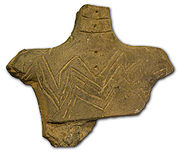 |
|
| 10000 BC | El Abra-Holocene Holocene The Holocene is a geological epoch which began at the end of the Pleistocene and continues to the present. The Holocene is part of the Quaternary period. Its name comes from the Greek words and , meaning "entirely recent"... stadial |
 |
|
| 5900 BC | Archaeological evidence of ceramic production and sedentary groups living on Caribbean Region of Colombia (near the towns of San Jacinto, Bolívar San Jacinto, Bolívar San Jacinto is a town and municipality located in the Bolívar Department, northern Colombia. The town is famous as the birthplace of the Latin Grammy Award winner cumbia group Los Gaiteros de San Jacinto.... , Monsú, Puerto Chacho, and Puerto Hormiga archaeological site Puerto Hormiga archaeological site The Puerto Hormiga archaeological site is located in the Bolivar department, Colombia, on the Atlantic coast. It has an uncertain date, between 4000 and 12,000 BC.... . This would place these pottery shards among the oldest ever recovered anywhere |
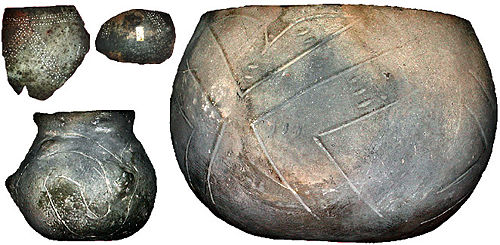 |
|
| 5500 BC | Muisca Muisca Muisca was the Chibcha-speaking tribe that formed the Muisca Confederation of the central highlands of present-day Colombia. They were encountered by the Spanish Empire in 1537, at the time of the conquest... formative stage Formative stage The Formative Stage or "Neo-Indian period" is an archaeological term describing a particular developmental level. This stage from 1000 BCE to 500 CE is the third of five stages defined by Gordon Willey and Philip Phillips' 1958 book Method and Theory in American Archaeology.Cultures of the... |
 |
|
| 5000 BC | Aguazuque period |  |
49th to 10th century BC
| style=" | Date | Event | Image |
|---|---|---|---|
| 2000 BC | Building of El Infiernito El Infiernito El Infiernito , is a pre-Columbian Muisca site located at the outskirts of Villa de Leyva, Boyacá Department, Colombia. It is composed of several earthworks surrounding a setting of menhirs ; several burial mounds are also present... menhir Menhir A menhir is a large upright standing stone. Menhirs may be found singly as monoliths, or as part of a group of similar stones. Their size can vary considerably; but their shape is generally uneven and squared, often tapering towards the top... s |
 |
|
| 1600 BC | Building of El morro del tulcán El morro del tulcán El Morro del Tulcán is an Indian pyramid in Popayán, Colombia. The pyramid dates to at least 1535, as the Spanish found it abandoned when they arrived in that year... Pyramid Pyramid A pyramid is a structure whose outer surfaces are triangular and converge at a single point. The base of a pyramid can be trilateral, quadrilateral, or any polygon shape, meaning that a pyramid has at least three triangular surfaces... |
 |
|
| 1300 BC | Chimitá petroglyph Petroglyph Petroglyphs are pictogram and logogram images created by removing part of a rock surface by incising, picking, carving, and abrading. Outside North America, scholars often use terms such as "carving", "engraving", or other descriptions of the technique to refer to such images... s in Santander Department Santander Department Santander is a department of Colombia. Santander inherited the name of one of the nine original states of the United States of Colombia. It is located in the central northern part of the country, east of the Magdalena River, bordered to the south and southeast by Boyacá, to the northeast by Norte... |
 |
|
| 1270 BC | Zipacón Zipacón Zipacón is a municipality and town of Colombia in the department of Cundinamarca.... pottery Pottery Pottery is the material from which the potteryware is made, of which major types include earthenware, stoneware and porcelain. The place where such wares are made is also called a pottery . Pottery also refers to the art or craft of the potter or the manufacture of pottery... |
 |
9th to 1st century BC
| Year | Date | Event | Image |
|---|---|---|---|
| 700 BC | Cave painting Cave painting Cave paintings are paintings on cave walls and ceilings, and the term is used especially for those dating to prehistoric times. The earliest European cave paintings date to the Aurignacian, some 32,000 years ago. The purpose of the paleolithic cave paintings is not known... s near Inirida river, Vichada Vichada Vichada may refer to:*Department of Vichada, a subdivision of Colombia*Vichada River, a river in eastern Colombia... department |
||
| 700 BC | Quimbaya civilization Quimbaya civilization The Quimbaya civilization is a South American civilization, noted for spectacular gold work characterized by technical accuracy and detailed designs. The majority of the gold work is made in tumbaga alloy, with 30% copper, which imparts beautiful color tonalities to the pieces... formative stage Formative stage The Formative Stage or "Neo-Indian period" is an archaeological term describing a particular developmental level. This stage from 1000 BCE to 500 CE is the third of five stages defined by Gordon Willey and Philip Phillips' 1958 book Method and Theory in American Archaeology.Cultures of the... |
||
| 300 BC | Malagana Malagana Malagana, also known as the Malagana Treasure is an archaeological site of Colombia named after the same name sugarcane estate where it was accidentally discovered in 1992... period |
||
| 300 BC 300 BC Year 300 BC was a year of the pre-Julian Roman calendar. At the time it was known as the Year of the Consulship of Corvus and Pansa... |
Guayabero Cave painting Cave painting Cave paintings are paintings on cave walls and ceilings, and the term is used especially for those dating to prehistoric times. The earliest European cave paintings date to the Aurignacian, some 32,000 years ago. The purpose of the paleolithic cave paintings is not known... s in Guaviare Guaviare Guaviare may refer to:* Guaviare Department of Colombia* Guaviare River... |
||
| 200 BC | San Agustín San Agustín, Huila San Agustín is a town and municipality in the southern Colombian Department of Huila. The town is located 227 km away from the capital of the Department, Neiva. Population is around 30,000. The village was originally founded in 1752 by Alejo Astudillo but attacks by indigenous people destroyed... culture |
 |
|
| 100 BC | Tairona Tairona Tairona was a group of chiefdoms in the region of Sierra Nevada de Santa Marta in present-day Cesar, Magdalena and La Guajira Departments of Colombia, South America, which goes back at least to the 1st century AD and had significant demographic growth around the 11th century.The Tairona people... culture |
 |
1st to 5th century AD
| Year | Date | Event | Image |
|---|---|---|---|
| 100 | Early Sinú culture | ||
| 300 | the Chibcha civilization expands from the northern Andes Andes The Andes is the world's longest continental mountain range. It is a continual range of highlands along the western coast of South America. This range is about long, about to wide , and of an average height of about .Along its length, the Andes is split into several ranges, which are separated... includying part of what is now Panama Panama Panama , officially the Republic of Panama , is the southernmost country of Central America. Situated on the isthmus connecting North and South America, it is bordered by Costa Rica to the northwest, Colombia to the southeast, the Caribbean Sea to the north and the Pacific Ocean to the south. The... , the high plains of the Eastern Sierra of Colombia the areas of modern departments of Santander Santander Department Santander is a department of Colombia. Santander inherited the name of one of the nine original states of the United States of Colombia. It is located in the central northern part of the country, east of the Magdalena River, bordered to the south and southeast by Boyacá, to the northeast by Norte... (North and South), Boyacá Boyacá Boyacá is the name of a region in Colombia. It may refer to any of:* Boyacá Department* Boyacá Department * Boyacá River* Boyacá Municipality* Battle of Boyacá* Boyacá Chicó F.C.* Boyacá Avenue an avenue in Bogotá... and Cundinamarca Cundinamarca Department - Origin of the name :The name of Cundinamarca comes from Kundur marqa, an indigenous expression, probably derived from Quechua. Meaning "Condor's Nest", it was used in pre-Columbian times by the natives of the Magdalena Valley to refer to the nearby highlands.... , becoming the most populous zone between the Mayan Maya civilization The Maya is a Mesoamerican civilization, noted for the only known fully developed written language of the pre-Columbian Americas, as well as for its art, architecture, and mathematical and astronomical systems. Initially established during the Pre-Classic period The Maya is a Mesoamerican... and Inca Empire Inca Empire The Inca Empire, or Inka Empire , was the largest empire in pre-Columbian America. The administrative, political and military center of the empire was located in Cusco in modern-day Peru. The Inca civilization arose from the highlands of Peru sometime in the early 13th century... s. |
||
| 600 | Classic Quimbaya civilization Quimbaya civilization The Quimbaya civilization is a South American civilization, noted for spectacular gold work characterized by technical accuracy and detailed designs. The majority of the gold work is made in tumbaga alloy, with 30% copper, which imparts beautiful color tonalities to the pieces... . Poporo Quimbaya Poporo Quimbaya Poporo Quimbaya is a precolumbian artpiece of the classic quimbaya period, currently exhibited in the Gold Museum in Bogotá, Colombia. Its primary use was as a ceremonial device for chewing of coca leaves during religious ceremonies... |
5th to 10th century AD
| Year | Date | Event | Image |
|---|---|---|---|
| 600 | Tierradentro Tierradentro Tierradentro is a National archeological park in the jurisdiction of the municipality of Inza, Department of Cauca, Colombia. The park is located 100 km away from the capital of the Department, Popayán.... culture |
 |
|
| 700 | Late Sinú culture |  |
11th century AD
| Year | Date | Event | Image |
|---|---|---|---|
| 1000 | Classic Muisca Muisca Muisca was the Chibcha-speaking tribe that formed the Muisca Confederation of the central highlands of present-day Colombia. They were encountered by the Spanish Empire in 1537, at the time of the conquest... period. Muisca raft |
 |
15th century
| Year | Date | Event | Image |
|---|---|---|---|
| 1450–1470 | Meicuchuca is Zipa of Bacatá |  |
|
| 1470–1490 | Saguamanchica is Zipa of Bacatá | ||
| until 1490 | Michuá is Zaque of Hunza Tunja Tunja is a city and municipality located in the central part of Colombia, in the region of "Alto Chicomocha". As of the 2005 Census it had 152,419 inhabitants. It is the capital of the Department of Boyacá and part of the subregion of the Central Boyacá Province. It is approximately 145 km... |
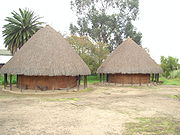 |
|
| 1490–1514 | Nemequene is Zipa of Bacatá | ||
| 1490–1537 | Quemuenchatocha is Zaque of Hunza Tunja Tunja is a city and municipality located in the central part of Colombia, in the region of "Alto Chicomocha". As of the 2005 Census it had 152,419 inhabitants. It is the capital of the Department of Boyacá and part of the subregion of the Central Boyacá Province. It is approximately 145 km... |
||
| 1498 | Spanish explorer Juan de la Cosa Juan de la Cosa Juan de la Cosa was a Spanish cartographer, conquistador and explorer. He made the earliest extant European world map to incorporate the territories of the Americas that were discovered in the 15th century, sailed first 3 voyages with Christopher Columbus, and was the owner/captain of the Santa... landed on what is today called Cabo de la Vela Cabo de la Vela Cabo de la Vela is a headland in the Guajira Peninsula in Colombia with an adjacent small fishing village. It is a popular ecotourism destination of the Caribbean Region of Colombia-History:... (Cape of Sail Sail A sail is any type of surface intended to move a vessel, vehicle or rotor by being placed in a wind—in essence a propulsion wing. Sails are used in sailing.-History of sails:... s) in the Guajira Peninsula Guajira Peninsula Guajira Peninsula , is a peninsula in northern Colombia and northwestern Venezuela in the Caribbean Sea... |
 |
16th century
| Year | Date | Event | Image |
|---|---|---|---|
| 1500 | Rodrigo de Bastidas Rodrigo de Bastidas Rodrigo de Bastidas was a Spanish conquistador and explorer who mapped the northern coast of South America and founded the city of Santa Marta.-Early life:... discovers the Colombian Caribbean littoral. |
||
| 1502 | May 2 | Alonso de Ojeda Alonso de Ojeda Alonso de Ojeda was a Spanish navigator, governor and conquistador. His name is sometimes spelled Alonzo and Oxeda.-Early life:... arrives to Bahía Honda and founded the village of Santa Cruz, first city in Colombia. |
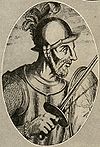 |
| 1508 | Diego de Enciso and Vasco Núñez de Balboa Vasco Núñez de Balboa Vasco Núñez de Balboa was a Spanish explorer, governor, and conquistador. He is best known for having crossed the Isthmus of Panama to the Pacific Ocean in 1513, becoming the first European to lead an expedition to have seen or reached the Pacific from the New World.He traveled to the New World in... founded the village of Santa María la Antigua del Darién Santa María la Antigua del Darién Santa María la Antigua del Darién was a Spanish colonial town founded in 1510 by Vasco Núñez de Balboa, located in present-day Colombia approximately 40 miles south of Acandí... , initially called The Antigua. |
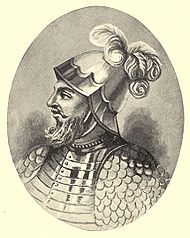 |
|
| 1509 | Ojeda founded the village of San Sebastián de Urabá. | ||
| 1509 | Indigenous princess India Catalina India Catalina India Catalina , was an indigenous woman from the Colombian Atlantic coast, who accompanied Pedro de Heredia and played a role in the Spanish conquest of Colombia, acting as interpreter and intermediary... is abducted by Spanish conqueror Diego de Nicuesa Diego de Nicuesa Diego de Nicuesa was a Spanish conquistador and explorer. In 1506, he was given the job of governing Costa Rica, but ran aground off the coast of Panama. He made his way north overland, against resistance from the native population... from a Calamari indigenous settlement |
 |
|
| 1510 | Spanish conquerors discover San Andres y Providencia islands | 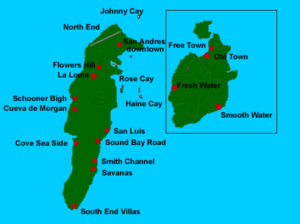 |
|
| 1513 | September 25 | Balboa discovers the Pacific Ocean. | 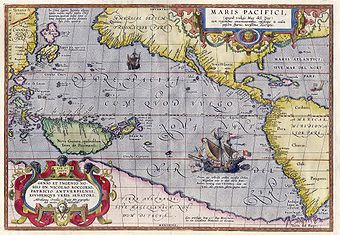 |
| 1514 | April 12 | The Pedrarias Dávila Expedition began. | |
| 1514–1537 | Tisquesusa is Zipa of Bacatá | ||
| 1518 | December 2 | Vasco Núñez de Balboa Vasco Núñez de Balboa Vasco Núñez de Balboa was a Spanish explorer, governor, and conquistador. He is best known for having crossed the Isthmus of Panama to the Pacific Ocean in 1513, becoming the first European to lead an expedition to have seen or reached the Pacific from the New World.He traveled to the New World in... is executed by orders of Pedrarias Dávila Pedrarias Dávila Pedrarias Dávila y Ortiz de Cota , was a Spanish colonial administrator... . |
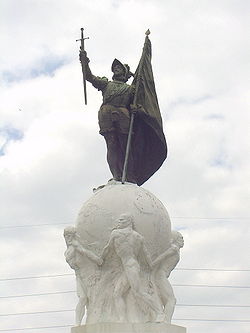 |
| 1525 | July 29 | Rodrigo de Bastidas Rodrigo de Bastidas Rodrigo de Bastidas was a Spanish conquistador and explorer who mapped the northern coast of South America and founded the city of Santa Marta.-Early life:... founded the village of Santa Marta Santa Marta Santa Marta is the capital city of the Colombian department of Magdalena in the Caribbean Region. It was founded in July 29, 1525 by the Spanish conqueror Rodrigo de Bastidas, which makes it the oldest remaining city in Colombia... . |
 |
| 1530 | May 3 | Foundation of Santa Cruz de Mompox Santa Cruz de Mompox Mompox or Mompós, officially Santa Cruz de Mompox, is a town and municipality in northern Colombia, in the Bolívar Department, which has preserved its colonial character. Located on an island in the Magdalena River where it joins the Cauca River, 249 kilometers from Cartagena. Mompox depends upon... by Alonso de Heredia |
|
| 1533 | January 20 | Pedro de Heredia Pedro de Heredia Pedro de Heredia, Spanish conqueror, founder of the city Cartagena de Indias, in Colombia.Noble from birth, for being involved in many brawls he was forced to leave Spain. He established himself in La Española. Later on, he accepted the job of lieutenant offered by the governor of Santa Marta,... founded the village of Cartagena de Indias. |
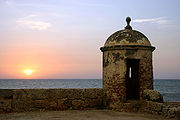 |
| 1536 | July 25 | Sebastián de Belalcázar Sebastián de Belalcázar Sebastián de Belalcázar was a Spanish conquistador.-Early life:He was born Sebastián Moyano in the province of Córdoba, Spain, in either 1479 or 1480. He took the name Belalcázar as that was the name of the castle-town near to his birthplace in Córdoba... founded the village of Santiago de Cali Santiago de Cali Santiago de Cali , simply referred to as Cali, is a city in western Colombia and the capital of the Valle del Cauca Department. With a population of 2.5 million, Cali is the third largest city in the country. It has one of the fastest growing economies and infrastructure in the country because... . |
 |
| 1537 | Foundation of St. Juan de Pasto Pasto Pasto, officially San Juan de Pasto, is the capital of the department of Nariño, located in southwest Colombia. The city is located in the "Atriz Valley", on the Andes cordillera, at the foot of the Galeras volcano, at an altitude of 8,290 feet above sea level... by Lorenzo de Aldana |
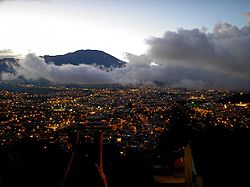 |
|
| 1537 | July 25 | Francisco César discovers the territory of Antioquia Antioquia Department Antioquia is one of the 32 departments of Colombia, located in the central northwestern part of Colombia with a narrow section that borders the Caribbean Sea. Most of its territory is mountainous with some valleys, much of which is part of the Andes mountain range... . |
 |
| 1537–1541 | Aquiminzaque is Zaque of Hunza Tunja Tunja is a city and municipality located in the central part of Colombia, in the region of "Alto Chicomocha". As of the 2005 Census it had 152,419 inhabitants. It is the capital of the Department of Boyacá and part of the subregion of the Central Boyacá Province. It is approximately 145 km... |
||
| August 15 | Sebastián de Belalcázar Sebastián de Belalcázar Sebastián de Belalcázar was a Spanish conquistador.-Early life:He was born Sebastián Moyano in the province of Córdoba, Spain, in either 1479 or 1480. He took the name Belalcázar as that was the name of the castle-town near to his birthplace in Córdoba... founded the village of Asunción de Popayán Popayán Popayán is the capital of the Colombian department of Cauca. It is located in southwestern Colombia between Colombia's Western Mountain Range and Central Mountain Range... , the first catholic mass. |
 |
|
| 1538 | August 6 | Gonzalo Jiménez de Quesada Gonzalo Jiménez de Quesada Gonzalo Jiménez de Quesada was a Spanish explorer and conquistador in Colombia. He explored the northern part of South America. While successful in many of his exploits, acquiring massive amounts of gold and emeralds, he ended his career disastrously; and has been suggested as a possible model... founded the village of Santa fe de Bogotá Bogotá Bogotá, Distrito Capital , from 1991 to 2000 called Santa Fé de Bogotá, is the capital, and largest city, of Colombia. It is also designated by the national constitution as the capital of the department of Cundinamarca, even though the city of Bogotá now comprises an independent Capital district... . *some historians argue that the date of foundation was on April 27, 1539. |
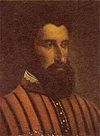 |
| 1539 | Cacica Gaitana Gaitana Gaitana, also referred to as La Gaitana and Cacica Gaitana, was a 16th century Páez woman leader who, in 1539-40, led the indigenous people of northern Cauca, Colombia in armed resistance against colonization by the Spanish... indigenous leader starts the Paez Páez Páez may refer to:* Páez people* Páez language, the language of the Páez people* Paezan languages, a hypothetical language family of Colombia and Ecuador* Páez, Boyaca — a municipality in Boyacá Department, Colombia... an revolt against the Spanish conquest |
||
| 1539 | August 6 | Gonzalo Suárez Rendón founded the village of Hunza Tunja Tunja is a city and municipality located in the central part of Colombia, in the region of "Alto Chicomocha". As of the 2005 Census it had 152,419 inhabitants. It is the capital of the Department of Boyacá and part of the subregion of the Central Boyacá Province. It is approximately 145 km... . |
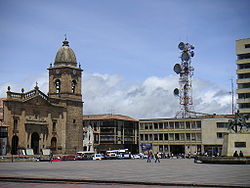 |
| 1539 | Foundation of Neiva by Juan de Cabrera | ||
| 1539 | Foundation of Honda, Tolima Honda, Tolima Honda is a town and municipality in the Tolima department of Colombia. The population of the municipality was 26,873 as of the 2005 census. Along with Líbano, Honda is the seat of the Roman Catholic Diocese of Líbano-Honda... by Gonzalo Jimenez de Quesada Gonzalo Jiménez de Quesada Gonzalo Jiménez de Quesada was a Spanish explorer and conquistador in Colombia. He explored the northern part of South America. While successful in many of his exploits, acquiring massive amounts of gold and emeralds, he ended his career disastrously; and has been suggested as a possible model... |
||
| 1540 | July 27 | King Spanish monarchy The Monarchy of Spain, constitutionally referred to as The Crown and commonly referred to as the Spanish monarchy or Hispanic Monarchy, is a constitutional institution and an historic office of Spain... Carlos V Charles V, Holy Roman Emperor Charles V was ruler of the Holy Roman Empire from 1519 and, as Charles I, of the Spanish Empire from 1516 until his voluntary retirement and abdication in favor of his younger brother Ferdinand I and his son Philip II in 1556.As... appointed Santa Fe de Bogotá Bogotá Bogotá, Distrito Capital , from 1991 to 2000 called Santa Fé de Bogotá, is the capital, and largest city, of Colombia. It is also designated by the national constitution as the capital of the department of Cundinamarca, even though the city of Bogotá now comprises an independent Capital district... the title of city. |
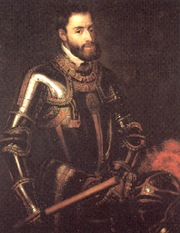 |
| 1541 | August 24 | Jerónimo Luis Tejelo discovers the Aburrá Valley Aburrá Valley Aburrá Valley , is the natural basin of the Medellín River and one of the most populous valleys of Colombia in its Andean Region with near 3 million inhabitants. The valley is located on the Central Range, over the Antioquian Mountain just between the Magdalean and Cauca valleys from east to west... . |
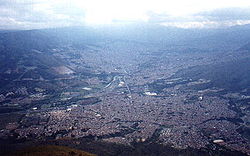 |
| 1542 | Francisco de Orellana Francisco de Orellana Francisco de Orellana was a Spanish explorer and conquistador. He completed the first known navigation of the length of the Amazon River, which was originally named for him... sails the length of the Amazon River Amazon River The Amazon of South America is the second longest river in the world and by far the largest by waterflow with an average discharge greater than the next seven largest rivers combined... . |
 |
|
| 1545 | Foundation of Riohacha Riohacha Riohacha, Rio Hacha or Rio de la Hacha , is a city in the Riohacha Municipality in the northern Caribbean Region of Colombia by the mouth of the Ranchería River and the Caribbean sea, capital city of the La Guajira Department. Founded by conquistador Nikolaus Federmann in 1535, Riohacha was named... by Nikolaus Federmann Nikolaus Federmann Nikolaus Federmann was a German adventurer and conquistador in the colonies of Venezuela and Colombia. He worked in the service of the Welser brothers.- Life :... |
 |
|
| 1549 | July 17 | Emperor Carlos V, created the Royal Audiencia of Santa Fe, subdivided into districts including the "New Kingdom Provinces": Santa Marta, Río de San Juan, Popayán, bordering with Quito, Guayana o Dorado and Cartagena de Indias. Pamplona Pamplona, Colombia Pamplona is a municipality and city in Norte de Santander, Colombia.-Colonization:Nueva Pamplona del Valle del Espíritu Santo, the name by which Don Pedro de Ursúa and Don Ortún Velasco de Velázquez paid tribute to the capital of the province of Navarre in Spain, was founded on 1 November 1549... was founded. |
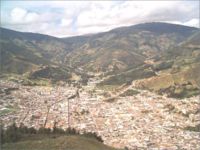 |
| 1550 | January 6 | Hernando de Santana Hernando de Santana Hernando de Santana was a Spanish conqueror, the founder of the City of Valledupar and conqueror in what is now northern Colombia.... founded the village of Valle de Upar Valledupar Valledupar is a city and municipality in northeastern Colombia. It is the capital of Cesar Department and was founded in 1550 by the Spanish conquistador Hernando de Santana. Its name, Valle de Upar , was established in honor of the Amerindian cacique who ruled the valley; Cacique Upar... . |
 |
| 1550 | Foundation of Ibagué Ibagué Ibagué is the capital of the department of Tolima in Colombia. It is situated 1,285 m above sea level, on the eastern slopes of the Cordillera Central between the Chipalo and Combeima rivers, tributaries of the Coello River... by Andres Lopez de Galarza |
 |
|
| 1556 | April 7 | The Real Audiencia de Santafé is officially installed. | 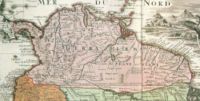 |
| 1572 | Foundation of Villa de Leyva Villa de Leyva Villa de Leyva is a colonial town and municipality, in the Boyacá department of Colombia, part of the subregion of the Ricaurte Province. The town is located some 40 km west of Tunja and has a population of about 9,600 people... by Hernan Suarez de Villalobos |
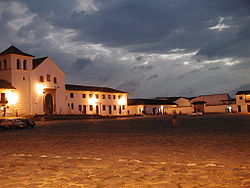 |
|
| 1580 | December 7 | first historical recorded eruption of Galeras Galeras Galeras is an Andean stratovolcano in the Colombian department of Nariño, near the departmental capital Pasto. Its summit rises above sea level. It has erupted frequently since the Spanish conquest, with its first historical eruption being recorded on December 7, 1580... volcano |
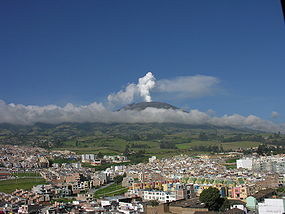 |
| 1588 | November 4–6 | Cartagena de Indias is affected by a hurricane. | |
| 1596 | English corsair Corsair Corsairs were privateers, authorized to conduct raids on shipping of a nation at war with France, on behalf of the French Crown. Seized vessels and cargo were sold at auction, with the corsair captain entitled to a portion of the proceeds... Francis Drake Francis Drake Sir Francis Drake, Vice Admiral was an English sea captain, privateer, navigator, slaver, and politician of the Elizabethan era. Elizabeth I of England awarded Drake a knighthood in 1581. He was second-in-command of the English fleet against the Spanish Armada in 1588. He also carried out the... attacks Riohacha Riohacha Riohacha, Rio Hacha or Rio de la Hacha , is a city in the Riohacha Municipality in the northern Caribbean Region of Colombia by the mouth of the Ranchería River and the Caribbean sea, capital city of the La Guajira Department. Founded by conquistador Nikolaus Federmann in 1535, Riohacha was named... |
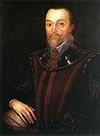 |
17th century
| Year | Date | Event | |
|---|---|---|---|
| 1600 | February 19 | Huaynaputina Huaynaputina Huaynaputina is a stratovolcano located in a volcanic upland in southern Peru. The volcano does not have an identifiable mountain profile, but instead has the form of a large volcanic crater. It has produced high-potassium andesite and dacite... volcano in Perú Peru Peru , officially the Republic of Peru , is a country in western South America. It is bordered on the north by Ecuador and Colombia, on the east by Brazil, on the southeast by Bolivia, on the south by Chile, and on the west by the Pacific Ocean.... exploded catastrophically, in the largest volcanic explosion in South America in historic times causing a Volcanic winter Volcanic winter A volcanic winter is the reduction in temperature caused by volcanic ash and droplets of sulfuric acid obscuring the sun and raising Earth's albedo after a large particularly explosive type of volcanic eruption... , with deadly effects reaching as far as Russia Russian famine of 1601–1603 The Russian famine of 1601–1603 was Russia's worst famine in terms of proportional effect on the population, killing perhaps two million people, a third of Russians, during the Time of Troubles, when the country was unsettled politically and later invaded by the Polish Commonwealth... |
|
| 1610 | February 5 | the Catholic Monarchs established from Spain the Spanish Inquisition Spanish Inquisition The Tribunal of the Holy Office of the Inquisition , commonly known as the Spanish Inquisition , was a tribunal established in 1480 by Catholic Monarchs Ferdinand II of Aragon and Isabella I of Castile. It was intended to maintain Catholic orthodoxy in their kingdoms, and to replace the Medieval... Holy Office Court in Cartagena de Indias |
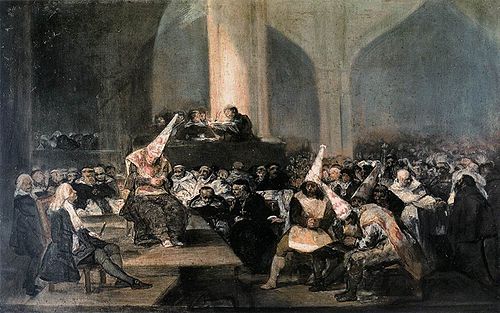 |
| 1629 | Foundation of Barranca de San Nicolas (Later Barranquilla Barranquilla Barranquilla is an industrial port city and municipality located in northern Colombia, near the Caribbean Sea. The capital of the Atlántico Department, it is the largest industrial city and port in the Colombian Caribbean region with a population of 1,148,506 as of 2005, which makes it Colombia's... ) by Galapa indigenous people |
 |
|
| 1631 | Foundation of Girón, Santander Girón, Santander Girón is a town and municipality in the Santander Department in northeastern Colombia.... by Francisco Mantilla de los Rios |
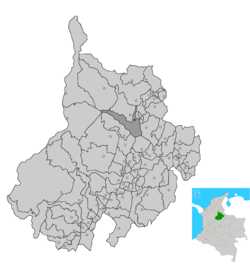 |
|
| 1650 | Approximated date of painting of the Sopo Archangels Sopo Archangels The Sopo Archangels is a famous collection of oil paintings from the Colombian colonial period which is located in the Church of the Divine Savior in the Colombian municipality of Sopó.... |
 |
|
| 1675 | Foundation of Medellín Medellín Medellín , officially the Municipio de Medellín or Municipality of Medellín, is the second largest city in Colombia. It is in the Aburrá Valley, one of the more northerly of the Andes in South America. It has a population of 2.3 million... by Francisco Herrera Campuzano |
18th century
| Year | Date | Event | Image |
|---|---|---|---|
| 1711 | August 6 | Death of painter Gregorio Vasquez de Arce y Ceballos Gregorio Vasquez de Arce y Ceballos Gregorio Vasquez de Arce y Ceballos , commonly referred to as Gregorio Vasquez, was a Colombian painter, including the Quitenian Miguel de Santiago, was one of the leading artist in the Latin American Baroque movement, which extended from the mid 17th to the late 18th century in the Viceroyalty of... |
|
| 1717 | The Viceroyalty of New Granada Viceroyalty of New Granada The Viceroyalty of New Granada was the name given on 27 May 1717, to a Spanish colonial jurisdiction in northern South America, corresponding mainly to modern Colombia, Ecuador, Panama, and Venezuela. The territory corresponding to Panama was incorporated later in 1739... is originally created, and then it was temporarily removed, to finally be reestablished in 1739 |
.svg.png) |
|
| 1719 | June 13 | Antonio Ignacio de la Pedrosa y Guerrero Antonio Ignacio de la Pedrosa y Guerrero Antonio de la Pedrosa y Guerrero was an attorney in Spain and in Santa Fe de Bogotá , a member of the Council of the Indies, and the first viceroy of New Granada, from June 13, 1718 to November 25, 1719.... is Viceroy of New Granada Viceroyalty of New Granada The Viceroyalty of New Granada was the name given on 27 May 1717, to a Spanish colonial jurisdiction in northern South America, corresponding mainly to modern Colombia, Ecuador, Panama, and Venezuela. The territory corresponding to Panama was incorporated later in 1739... |
|
| 1724 | May 11 | Jorge de Villalonga Jorge de Villalonga Jorge de Villalonga, segundo conde de la Cueva was a Spanish lawyer, general and the first official viceroy of New Granada, from November 25, 1719 to May 11, 1724.... is Viceroy of New Granada Viceroyalty of New Granada The Viceroyalty of New Granada was the name given on 27 May 1717, to a Spanish colonial jurisdiction in northern South America, corresponding mainly to modern Colombia, Ecuador, Panama, and Venezuela. The territory corresponding to Panama was incorporated later in 1739... |
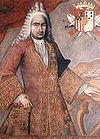 |
| 1740 | April 24 | Sebastián de Eslava Sebastián de Eslava Sebastián de Eslava y Lazaga was a Spanish general and colonial official. From April 24, 1740 to November 6, 1749 he was viceroy of the newly reestablished Viceroyalty of New Granada. He was governing the colony at the time of the defeat of British Admiral Edward Vernon at Cartagena de Indias... is Viceroy of New Granada Viceroyalty of New Granada The Viceroyalty of New Granada was the name given on 27 May 1717, to a Spanish colonial jurisdiction in northern South America, corresponding mainly to modern Colombia, Ecuador, Panama, and Venezuela. The territory corresponding to Panama was incorporated later in 1739... |
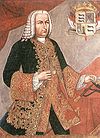 |
| 1740 | Revolt of the Comuneros (New Granada) Revolt of the Comuneros (New Granada) The Revolt of the Comuneros was an uprising by the inhabitants of the Viceroyalty of New Granada against the Spanish authorities in 1781. While underlying causes may have been economic, ideas of freedom and self-government were expressed... |
||
| 1749 | September 24 | José Alfonso Pizarro José Alfonso Pizarro José Alfonso Pizarro, Marqués del Villar was a Spanish naval officer and colonial administrator. From November 6, 1749 to November 24, 1753 he was viceroy of the Spanish Viceroyalty of New Granada.As a youth he entered the naval service of the Knights of Malta... is Viceroy of New Granada Viceroyalty of New Granada The Viceroyalty of New Granada was the name given on 27 May 1717, to a Spanish colonial jurisdiction in northern South America, corresponding mainly to modern Colombia, Ecuador, Panama, and Venezuela. The territory corresponding to Panama was incorporated later in 1739... |
 |
| 1753 | November 24 | José Solís Folch de Cardona José Solís Folch de Cardona José Solís y Folch de Cardona, grande de España and knight of the Order of Santiago was a Spanish colonial administrator and viceroy of New Granada from November 24, 1753 to February 25, 1761.-Background:... is Viceroy of New Granada Viceroyalty of New Granada The Viceroyalty of New Granada was the name given on 27 May 1717, to a Spanish colonial jurisdiction in northern South America, corresponding mainly to modern Colombia, Ecuador, Panama, and Venezuela. The territory corresponding to Panama was incorporated later in 1739... |
 |
| 1756 | The viceroyalty of New Granada is allowed to fabricate its own coins. The House of Coins "Casa de la Moneda" is built |  |
|
| 1761 | Pedro Messía de la Cerda Pedro Messía de la Cerda Pedro Messía Corea de la Cerda, 2nd Marquis of Vega de Armijo was a Spanish naval officer and colonial official... is Viceroy of New Granada Viceroyalty of New Granada The Viceroyalty of New Granada was the name given on 27 May 1717, to a Spanish colonial jurisdiction in northern South America, corresponding mainly to modern Colombia, Ecuador, Panama, and Venezuela. The territory corresponding to Panama was incorporated later in 1739... |
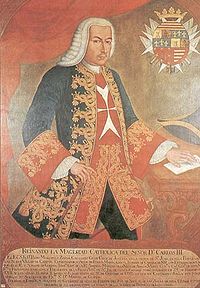 |
|
| 1772 | Manuel de Guirior Manuel de Guirior Manuel de Guirior was a Spanish naval officer and colonial administrator. He was viceroy of New Granada from 1772 to 1776 and of Peru from July 17, 1776 to July 21, 1780.Guirior was born into a noble family of Navarre. He entered the navy in 1733 as a lieutenant... is Viceroy of New Granada Viceroyalty of New Granada The Viceroyalty of New Granada was the name given on 27 May 1717, to a Spanish colonial jurisdiction in northern South America, corresponding mainly to modern Colombia, Ecuador, Panama, and Venezuela. The territory corresponding to Panama was incorporated later in 1739... |
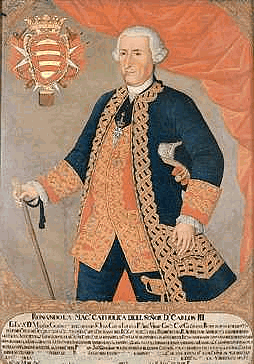 |
|
| 1773 | Foundation of San Jose de Cúcuta Cúcuta Cúcuta is a Colombian city, capital of Norte de Santander, in the northeast of the country. Due to its proximity to the Colombian-Venezuelan border, Cúcuta is an important commercial center. The city has the constitutional category of Special District. It is located at the most active... by Juana Rangel de Cuellar |
.jpg) |
|
| 1776 | November 26 | Manuel Antonio Flores Manuel Antonio Flores Manuel Antonio Flores Maldonado Martínez Ángulo y Bodquín was a general in the Spanish navy and viceroy of New Granada and New Spain .-Early career:Flores entered the royal navy of Spain, where he commanded various... is Viceroy of New Granada Viceroyalty of New Granada The Viceroyalty of New Granada was the name given on 27 May 1717, to a Spanish colonial jurisdiction in northern South America, corresponding mainly to modern Colombia, Ecuador, Panama, and Venezuela. The territory corresponding to Panama was incorporated later in 1739... |
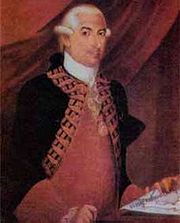 |
| 1780 | Manuela Beltrán Manuela Beltrán Manuela Beltrán was a Colombian woman who organized a peasant revolt against excess taxation in 1780.-General settings:The information concerning the biography of Manuela Beltran is scarce and fragmented... organized a peasant revolt against excessive taxation |
||
| 1782 | April 1 | Juan de Torrezar Díaz Pimienta Juan de Torrezar Díaz Pimienta Juan de Torrezar Díaz Pimienta was a Spanish military officer and colonial official. He was twice governor of Cartagena de Indias, after which he was promoted to viceroy of New Granada.-Background:He was a brigadier in the royal army and a knight of the Order of Carlos III... is Viceroy of New Granada Viceroyalty of New Granada The Viceroyalty of New Granada was the name given on 27 May 1717, to a Spanish colonial jurisdiction in northern South America, corresponding mainly to modern Colombia, Ecuador, Panama, and Venezuela. The territory corresponding to Panama was incorporated later in 1739... |
 |
| 1782 | Antonio Caballero y Góngora Antonio Caballero y Góngora Antonio Caballero y Góngora was a Spanish Roman Catholic prelate and, from 1782 to 1789, viceroy of New Granada.... is Viceroy of New Granada Viceroyalty of New Granada The Viceroyalty of New Granada was the name given on 27 May 1717, to a Spanish colonial jurisdiction in northern South America, corresponding mainly to modern Colombia, Ecuador, Panama, and Venezuela. The territory corresponding to Panama was incorporated later in 1739... |
 |
|
| 1783 | José Celestino Mutis José Celestino Mutis -External links:*** at The Catholic Encyclopedia official site... leads the Botany Botany Botany, plant science, or plant biology is a branch of biology that involves the scientific study of plant life. Traditionally, botany also included the study of fungi, algae and viruses... expedition |
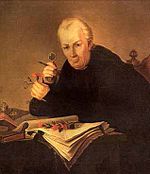 |
|
| 1786 | Death of indigenous leader Cacique Calarcá in combats against the Spanish forces in Peñasblancas Peñasblancas Peñas Blancas consists of a crag and three vertical rock faces located on the western slopes of the Central Cordillera of the Andes in the municipality of Calarcá, in the department of Quindío in Colombia.... |
||
| 1788 | Francisco Gil de Taboada y Lemos is Viceroy of New Granada Viceroyalty of New Granada The Viceroyalty of New Granada was the name given on 27 May 1717, to a Spanish colonial jurisdiction in northern South America, corresponding mainly to modern Colombia, Ecuador, Panama, and Venezuela. The territory corresponding to Panama was incorporated later in 1739... |
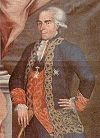 |
|
| 1789 | José Manuel de Ezpeleta José Manuel de Ezpeleta José Manuel de Ezpeleta y Galdeano, 1st Count of Ezpeleta de Beire was a Spanish military officer and politician, governor of Cuba from 1785 to 1789, and viceroy of New Granada from 1789 to 1797.A knight of the Order of Charles III and of the Royal and... is Viceroy of New Granada Viceroyalty of New Granada The Viceroyalty of New Granada was the name given on 27 May 1717, to a Spanish colonial jurisdiction in northern South America, corresponding mainly to modern Colombia, Ecuador, Panama, and Venezuela. The territory corresponding to Panama was incorporated later in 1739... |
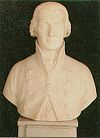 |
|
| 1797 | January 2 | Pedro Mendinueta y Múzquiz Pedro Mendinueta y Múzquiz Pedro Mendinueta y Múzquiz was a Spanish lieutenant general and colonial official. From January 2, 1797 to 1803 he was viceroy of New Granada. He was a knight of the Order of Santiago, and he was awarded the Gran Cruz of Carlos III.-Background:Mendinueta began his military career as an infantry... is Viceroy of New Granada Viceroyalty of New Granada The Viceroyalty of New Granada was the name given on 27 May 1717, to a Spanish colonial jurisdiction in northern South America, corresponding mainly to modern Colombia, Ecuador, Panama, and Venezuela. The territory corresponding to Panama was incorporated later in 1739... |
|
| 1799 | Research expedition of Alexander Von Humboldt Alexander von Humboldt Friedrich Wilhelm Heinrich Alexander Freiherr von Humboldt was a German naturalist and explorer, and the younger brother of the Prussian minister, philosopher and linguist Wilhelm von Humboldt... exploring the courses of the Orinoco river and Magdalena river Magdalena River The Magdalena River is the principal river of Colombia, flowing northward about through the western half of the country. It takes its name from the biblical figure Mary Magdalene. It is navigable through much of its lower reaches, in spite of the shifting sand bars at the mouth of its delta, as... |
 |
19th century
| Year | Date | Event | Image |
|---|---|---|---|
| 1803 | San Andres y Providencia islands are annexed to the Viceroyalty of New Granada Viceroyalty of New Granada The Viceroyalty of New Granada was the name given on 27 May 1717, to a Spanish colonial jurisdiction in northern South America, corresponding mainly to modern Colombia, Ecuador, Panama, and Venezuela. The territory corresponding to Panama was incorporated later in 1739... |
 |
|
| 1810 | July 20 | Cry of Independence, also known as the Florero de Llorente (Llorente Flower Vase) incident (Colombian Independence Day Colombian Declaration of Independence Colombian Declaration of Independence refers to the historic events which happened on July 20,1810, in Santa Fe de Bogota, at the time the Viceroyalty of New Granada seceded and the related events around this date that defined the uprising of the Republic of Colombia.- Background :An important... ) |
|
| 1810 | July 25 | José Miguel Pey de Andrade José Miguel Pey de Andrade José Miguel Pey y García de Andrade was a Colombian statesman and soldier and a leader of the independence movement from Spain. He is considered the first vice president and first president of Colombia. He was a centralist.-Background:Pey, a Criollo, was born on March 11, 1763 in Santa Fe de... is President of the Supreme Governing Junta |
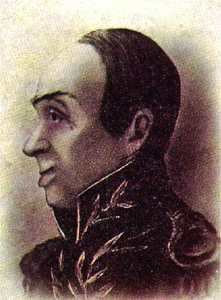 |
| 1810 | September 17 | The president of the Supreme Board of Cartagena, José María García Toledo, created the Colombian Navy | |
| 1811 | April 1 | Jorge Tadeo Lozano Jorge Tadeo Lozano Jorge Tadeo Lozano, Viscount of Pastrana was a Neogranadine scientist, journalist, and politician who presided over the Constituent College of Cundinamarca and was elected President of Cundinamarca in 1811.... is declared President of Cundinamarca Free and Independent State of Cundinamarca The Free and Independent State of Cundinamarca was a rebel state in modern Colombia between 1810 and 1815 during the Patria Boba period at the beginning of the Latin American wars of independence... and Vicegerent of the King's Person |
 |
| 1811 | November 11 | Cartagena de Indias declared its complete independence from Spain | 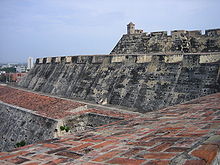 |
| 1811 | Antonio Nariño Antonio Nariño Antonio de la Santísima Concepción Nariño y Álvarez was an ideological Colombian precursor and one of the early political and military leaders of the independence movement in the New Granada - Early political activity :Nariño was born to an aristocratic family... publishes the first Newspaper in Colombia, "La Bagatela" |
 |
|
| 1811 | April 1 | Antonio Nariño Antonio Nariño Antonio de la Santísima Concepción Nariño y Álvarez was an ideological Colombian precursor and one of the early political and military leaders of the independence movement in the New Granada - Early political activity :Nariño was born to an aristocratic family... is declared President of Cundinamarca Free and Independent State of Cundinamarca The Free and Independent State of Cundinamarca was a rebel state in modern Colombia between 1810 and 1815 during the Patria Boba period at the beginning of the Latin American wars of independence... and Vicegerent of the King's Person |
 |
| 1812 | April 1 | Manuel Rodríguez Torices Manuel Rodríguez Torices Manuel Rodríguez Torices was a Neogranadine statesman, lawyer, journalist, and Precursor of the Independence of Colombia... is President of the State of Cartagena de Indias |
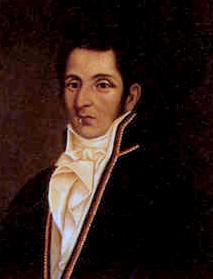 |
| 1812 | August 19 | Manuel Benito de Castro Manuel Benito de Castro Manuel Benito de Castro was a Neogranadine politician. He became President of the State of Cundinamarca in 1812 in place of Antonio Nariño.-Early life:... is declared President of Cundinamarca Free and Independent State of Cundinamarca The Free and Independent State of Cundinamarca was a rebel state in modern Colombia between 1810 and 1815 during the Patria Boba period at the beginning of the Latin American wars of independence... and Vicegerent of the King's Person |
 |
| 1814 | May 14 | Manuel de Bernardo Álvarez del Casal Manuel de Bernardo Álvarez del Casal Manuel de Bernardo Álvarez del Casal was an influential Criollo figure in New Granada at the time of the independence movement. He occupied several important positions in the rebel government. He was also the uncle of Antonio Nariño, forerunner of independence... is declared President of Cundinamarca Free and Independent State of Cundinamarca The Free and Independent State of Cundinamarca was a rebel state in modern Colombia between 1810 and 1815 during the Patria Boba period at the beginning of the Latin American wars of independence... and Vicegerent of the King's Person |
|
| 1814 | October 5 | José Luis Álvaro Alvino Fernández Madrid José Fernández Madrid José Luis Álvaro Alvino Fernández Madrid was a Neogranadine statesman, physician, scientist and writer, who was President of the interim triumvirate of the United Provinces of New Granada in 1814, and President of the United Provinces of the New Granada in 1816... , is president of the United Provinces of the New Granada. |
 |
| 1815 | January 21 | Custodio García Rovira Custodio García Rovira José Custodio Cayetano García Rovira was a Neogranadine general, statesman and painter, who fought for the independence of New Granada from Spain, and became President of the United Provinces of the New Granada in 1816... is president of the United Provinces of the New Granada. he was executed 1 month later by Pablo Morillo Pablo Morillo Pablo Morillo y Morillo, Count of Cartagena and Marquess of La Puerta, aka El Pacificador was a Spanish general.... . |
 |
| 1815 | March 28 | José Miguel Pey de Andrade José Miguel Pey de Andrade José Miguel Pey y García de Andrade was a Colombian statesman and soldier and a leader of the independence movement from Spain. He is considered the first vice president and first president of Colombia. He was a centralist.-Background:Pey, a Criollo, was born on March 11, 1763 in Santa Fe de... is President of the United Provinces of the New Granada |
 |
| 1815 | August 17 | Antonio Villavicencio Antonio Villavicencio Antonio Villavicencio y Verástegui was a Neogranadine Lieutenant statesman and soldier, born in Quito, and educated in Spain. He served in the Battle of Trafalgar as an office in the Spanish Navy... is President of the United Provinces of the New Granada |
 |
| 1815 | November 15 | Camilo Torres Tenorio Camilo Torres Tenorio Camilo Torres Tenorio was a Colombian politician. He is credited as being an early founder of the nation due to his role in early struggles for independence from Spain.-Biography:... is President of the United Provinces of the New Granada |
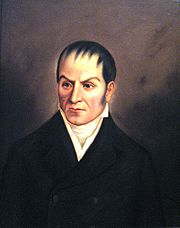 |
| 1816 | June 22 | Liborio Mejía Liborio Mejía Liborio Mejía Gutiérrez was a Colombian colonel and politician during the struggle for Independence from Spain, and in 1816 Liborio Mejía became president of the United Provinces of the New Granada making him the youngest person to ever hold the presidency of Colombia at the age of 24... is president of the United Provinces of the New Granada making him the youngest person to ever hold the presidency of Colombia at the age of 24. He was executed three months later during the Reconquest Reconquista (Spanish America) In colonial Spanish America, the Reconquista refers to the period following the defeat of Napoleon in 1814 during which royalist armies were able to gain the upper hand in the Spanish American wars of independence... led by the Spaniard Pablo Morillo Pablo Morillo Pablo Morillo y Morillo, Count of Cartagena and Marquess of La Puerta, aka El Pacificador was a Spanish general.... . |
 |
| 1816 | July 16 | Manuel Fernando Serrano Uribe Fernando Serrano Manuel Fernando Serrano Uribe was a Neogranadine statesman, lawyer, and officer who became Governor of the Province of Pamplona and wrote its Constitution in 1815... is the last president of the United Provinces of the New Granada before its dissolution and complete Reconquest Reconquista (Spanish America) In colonial Spanish America, the Reconquista refers to the period following the defeat of Napoleon in 1814 during which royalist armies were able to gain the upper hand in the Spanish American wars of independence... . |
 |
| 1816 | October 28 | Execution of Francisco José de Caldas Francisco José de Caldas Francisco José de Caldas was a Colombian lawyer, naturalist, and geographer who died a martyr by orders of Pablo Morillo during the Reconquista for being a precursor of the Independence of New Granada .... |
 |
| 1817 | November 14 | Execution of Policarpa Salavarrieta Policarpa Salavarrieta Policarpa Salavarrieta , also known as La Pola, was a Neogranadine seamstress who spied for the Revolutionary Forces during the Spanish Reconquista of the Viceroyalty of New Granada. She was captured by Spanish Royalists and ultimately executed for high treason... |
 |
| 1818 | September 25 | Doña Manuela Sáenz Manuela Sáenz Doña Manuela Sáenz was born in Quito, Viceroyalty of New Granada and died in Paita, Peru. She was a revolutionary hero of South America, who also became the mistress of the South American revolutionary leader, Simón Bolívar... de Thorne saves Simón Bolívar Simón Bolívar Simón José Antonio de la Santísima Trinidad Bolívar y Palacios Ponte y Yeiter, commonly known as Simón Bolívar was a Venezuelan military and political leader... from an attempted assassination |
 |
| 1819 | February 5 | The Congress of Angostura Congress of Angostura The Congress of Angostura was summoned by Simón Bolívar and took place in Angostura during the wars of Independence of Colombia and Venezuela. It met from February 15, 1819, to July 31, 1821, when the Congress of Cúcuta began its sessions.It consisted of twenty-six delegates, representing... |
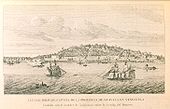 |
| 1819 | July 25 | Vargas Swamp Battle Vargas Swamp Battle Vargas Swamp Battle was an armed conflict that occurred near Paipa, on July 25, 1819. The joint Venezuelan and Neogranadan army commanded by Simón Bolívar was trying to prevent the Spanish forces from arriving at Santafe de Bogotá, which was lightly defended, before they did... |
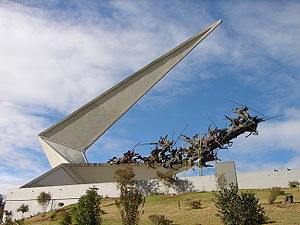 |
| 1819 | August 7 | Battle of Boyacá Battle of Boyacá The Battle of Boyacá in Colombia, then known as New Granada, was the battle in which Colombia acquired its definitive independence from Spanish Monarchy, although fighting with royalist forces would continue for years.... . |
 |
| 1819 | October 11 | For order of Francisco de Paula Santander Francisco de Paula Santander Francisco José de Paula Santander y Omaña , was a Colombian military and political leader during the 1810–1819 independence war of the United Provinces of New Granada... , Spanish colonel Jose Maria Barreiro and 38 Spanish officers were executed in Bogotá. |
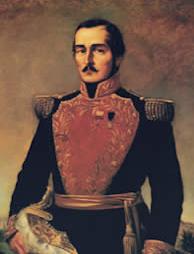 |
| 1821 | August 30 | Congress of Cúcuta Congress of Cúcuta The Congress of Cúcuta was a constituent assembly where Gran Colombia was created. The Congress elected Simón Bolívar and Francisco de Paula Santander president and vice-president, respectively.... and Constitution of Cúcuta Constitution of Cúcuta The Constitution of Cúcuta, also known as Constitution of the Gran Colombia and Constitution of 1821 was the founding document and constitution of the country of Gran Colombia, unifying the territories of the Viceroyalty of New Granada as part of a federation... |
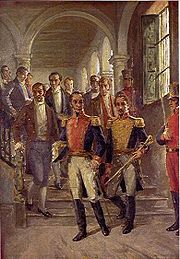 |
| 1828 | August 27 | After the failure of the constitutional convention of Ocaña Ocaña, Colombia Ocaña is a town and municipality in the Colombian Department of Norte de Santander. Ocaña is the second largest populated center of this department. It played an important role during the Independence of Colombia from the Spanish monarchy.-History:... Simón Bolívar Simón Bolívar Simón José Antonio de la Santísima Trinidad Bolívar y Palacios Ponte y Yeiter, commonly known as Simón Bolívar was a Venezuelan military and political leader... proclaimed himself dictator, through the "Organic Decree of Dictatorship". |
 |
| 1830 | September 15 | Rafael José de Urdaneta y Faría Rafael Urdaneta Rafael José Urdaneta y Faría was a Venezuelan General and hero of the Spanish American wars of independence in several countries in northern South America.- Biographic data :... is Provisional Chief of the Government of the Republic of Gran Colombia Gran Colombia Gran Colombia is a name used today for the state that encompassed much of northern South America and part of southern Central America from 1819 to 1831. This short-lived republic included the territories of present-day Colombia, Venezuela, Ecuador, Panama, northern Peru and northwest Brazil. The... |
 |
| 1830 | December 17 | Simon Bolívar Simón Bolívar Simón José Antonio de la Santísima Trinidad Bolívar y Palacios Ponte y Yeiter, commonly known as Simón Bolívar was a Venezuelan military and political leader... dies in Quinta de San Pedro Alejandrino Quinta de San Pedro Alejandrino La Quinta de San Pedro Alejandrino is a hacienda or Quinta built in the 17th century, famous for being the death place of Simón Bolívar on December 17, 1830. At that time, the estate produced rum, honey and panela... near Santa Marta Santa Marta Santa Marta is the capital city of the Colombian department of Magdalena in the Caribbean Region. It was founded in July 29, 1525 by the Spanish conqueror Rodrigo de Bastidas, which makes it the oldest remaining city in Colombia... |
 |
| 1830 | The Federation of Gran Colombia Gran Colombia Gran Colombia is a name used today for the state that encompassed much of northern South America and part of southern Central America from 1819 to 1831. This short-lived republic included the territories of present-day Colombia, Venezuela, Ecuador, Panama, northern Peru and northwest Brazil. The... is dissolved |
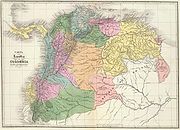 |
|
| 1831 | May 2 | Joaquín Mariano Mosquera y Arboleda Joaquín Mosquera Joaquín Mariano Mosquera y Arboleda was a Neogranadine statesman and a Founding Father of Colombia and served as the 6th and 4th President of Gran Colombia, and as the 3rd Vice President of the Republic of New Granada... is President of the Republic of New Granada |
 |
| 1832 | March 10 | José Ignacio de Márquez José Ignacio de Márquez José Ignacio de Márquez Barreto was a Colombian statesman, lawyer and professor, who served as Vice President of Colombia under the presidency of Francisco de Paula Santander, and subsequently was elected President of the Republic of the New Granada for the presidential term of 1837 to 1841.- ... is President of the Republic of New Granada |
 |
| 1832 | October 7 | Francisco de Paula Santander Francisco de Paula Santander Francisco José de Paula Santander y Omaña , was a Colombian military and political leader during the 1810–1819 independence war of the United Provinces of New Granada... is President of the Republic of New Granada |
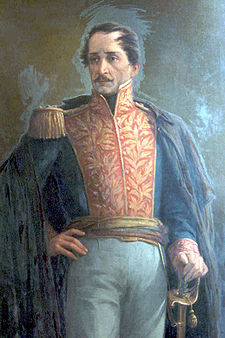 |
| 1832 | October 7 | Coat of Arms of Colombia Coat of arms of Colombia The coat of arms of Colombia contains a shield with numerous symbols. Perched on top of the shield is an Andean Condor holding an olive crown and the condor symbolizing freedom. The national motto, Libertad y Orden , is on a scroll in between the bird and the shield in black font over golden... is officially adopted |
 |
| 1835 | Start the Colombian coffee Colombian coffee Colombian Coffee is a protected designation of origin granted by the European Union that applies to the coffee produced in Colombia. The Colombian coffee has been recognized worldwide as having high quality and distinctive taste... industry with the first commercial crops in Norte de Santander |
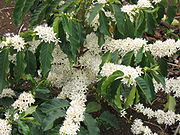 |
|
| 1837 | Colombian peso Colombian peso The peso is the currency of Colombia. Its ISO 4217 code is COP and it is also informally abbreviated as COL$. However, the official peso symbol is $. As 20 July 2011, the exchange rate of the Colombian peso is 1750 Colombian pesos to 1 U.S. dollar.-History:The peso has been the currency of Colombia... replaces Colombian real Colombian real The real was the currency of Colombia until 1837. No subdivisions of the real existed until after the real had ceased to be the primary unit of currency. However, 8 reales = 1 peso and 16 reales = 1 escudo.-History:... as official currency |
||
| 1839 | The War of the Supremes War of the Supremes The War of the Supremes was a civil conflict in Republic of the New Granada from 1839 to 1841 caused by the ambitions of various regional leaders to seize power and depose President José Ignacio de Márquez... (Spanish: Guerra de los Supremos, also called the Guerra de los Conventos) extended from 1839 to 1841, caused by the ambitions of various regional leaders (gamonales) to seize power and depose President José Ignacio de Márquez José Ignacio de Márquez José Ignacio de Márquez Barreto was a Colombian statesman, lawyer and professor, who served as Vice President of Colombia under the presidency of Francisco de Paula Santander, and subsequently was elected President of the Republic of the New Granada for the presidential term of 1837 to 1841.- ... |
 |
|
| 1840 | Foundation of Villavicencio Villavicencio Villavicencio is a city and municipality in Colombia, capital of the Department of Meta, with 361,058 inhabitants. The city is located at 4°08S, 73°40W, 75 km southeast of the Colombian capital city of Bogotá by the Guatiquía river... by Esteban Aguirre |
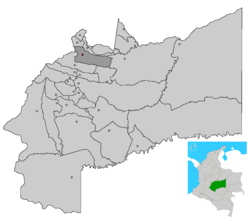 |
|
| 1841 | April 1 | Pedro Alcántara Herrán Pedro Alcántara Herrán Pedro Alcántara Herrán Martínez de Zaldúa was a Colombian general and statesman who served as President of the Republic of the New Granada between 1841 and 1845. As a general he served in the wars of independence of the New Granada and of Peru.... is President of the Republic of New Granada |
 |
| 1845 | April 1 | Tomás Cipriano de Mosquera Tomás Cipriano de Mosquera Tomás Cipriano de Mosquera y Arboleda was a Colombian general and political figure. He was president of Colombia four times. The first time was as president of Republic of New Granada from 1845 to 1849. During the Colombian Civil War of 1860-1862 he led liberal forces in a civil war against... is President of the Republic of New Granada |
 |
| 1849 | Foundation of Manizales Manizales Manizales is a city and municipality in central Colombia, capital of Department of Caldas and part of the region of Colombian Coffee-Growers Axis, near the Nevado del Ruiz volcano.... by Antioquian colonists |
||
| 1849 | April 1 | José Hilario López is President of the Republic of New Granada | 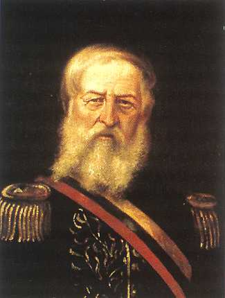 |
| 1851 | October 14 | José de Obaldía José de Obaldía José Vicente Arcenio de Obaldía y Orejuela was a Neogranadine statesmen and lawyer, who served as President of the Republic of the New Granada in two occasions between 1851–1852 and 1854-1855... is President of the Republic of New Granada |
 |
| 1853 | April 1 | José María Obando José María Obando José María Ramón Obando del Campo was a Neogranadine General and politician who twice served as President of Colombia... is President of the Republic of New Granada |
 |
| 1854 | April 17 | José María Melo José María Melo José María Dionisio Melo y Ortiz was a Colombian general and politician of Pijao ancestry, who fought in the South American wars of independence, and who in 1854 rose to power and held the presidency of Colombia. In August, 1850, artisans demanded protection and the creation of a national workshop... is President of the Republic of New Granada |
 |
| 1853 | April 1 | Manuel María Mallarino Manuel María Mallarino Manuel María Mallarino Ibargüen was a Colombian politician, lawyer and Member of Congress, who served as Vice-President of the New Granada, and as such he occupied the presidency of the country between 1855 and 1857.... is President of the Republic of New Granada |
 |
| 1856 | June 11 | Creation of the Sovereign State of Antioquía | |
| 1857 | June 15 | The Law of June 15, 1857, created the other states that would go on to form the Granadine Confederation: The Sovereign State of Bolívar, The Sovereign State of Santander, The Sovereign State of Cauca, and The Sovereign State of Magdalena | 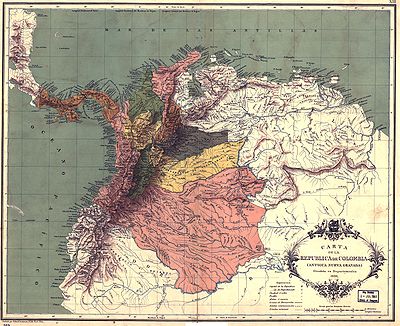 |
| 1858 | The Granadine Confederation Granadine Confederation The Granadine Confederation was a short-lived federal republic established in 1858 as a result of a constitutional change replacing the Republic of New Granada. It comprised the present day nations of Colombia and Panama... is created. |
 |
|
| 1858 | May 22 | Mariano Ospina Rodríguez Mariano Ospina Rodríguez Mariano Ospina Rodríguez was a Colombian politician, journalist and lawyer, founder of the Colombian Conservative Party and later President of Colombia between 1857 and 1861 during the Granadine Confederation.- Biographic data :... is president of the Granadine Confederation Granadine Confederation The Granadine Confederation was a short-lived federal republic established in 1858 as a result of a constitutional change replacing the Republic of New Granada. It comprised the present day nations of Colombia and Panama... |
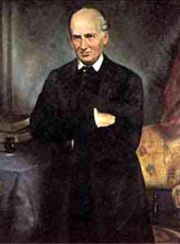 |
| 1860 | May 8 | Newly appointed Supreme Director of War Tomas Cipriano de Mosquera Tomás Cipriano de Mosquera Tomás Cipriano de Mosquera y Arboleda was a Colombian general and political figure. He was president of Colombia four times. The first time was as president of Republic of New Granada from 1845 to 1849. During the Colombian Civil War of 1860-1862 he led liberal forces in a civil war against... declared the Sovereign State of Cauca a separate nation from the Granadine Confederation Granadine Confederation The Granadine Confederation was a short-lived federal republic established in 1858 as a result of a constitutional change replacing the Republic of New Granada. It comprised the present day nations of Colombia and Panama... and Colombian Civil War (1860–1862) Colombian Civil War (1860–1862) The Colombian Civil War of May 8 1860 to November 1862 was an internal conflict between the newly formed conservative Grenadine Confederation and a more liberal rebel force from the newly seceded region of Cauca, composed of dissatisfied politicians commanded by General Tomás Cipriano de Mosquera,... broke out |
 |
| 1861 | April 1 | Bartolomé Calvo Bartolomé Calvo Bartolomé Calvo Díaz de Lamadrid was a Colombian lawyer, journalist, and statesman, who became President of the Granadine Confederation, in what is now Colombia, in 1861 in his role as Inspector General, because no elections were held on that year to the decide the presidency... is President of the Granadine Confederation |
 |
| 1861 | July 18 | Tomás Cipriano de Mosquera Tomás Cipriano de Mosquera Tomás Cipriano de Mosquera y Arboleda was a Colombian general and political figure. He was president of Colombia four times. The first time was as president of Republic of New Granada from 1845 to 1849. During the Colombian Civil War of 1860-1862 he led liberal forces in a civil war against... is President of the Granadine Confederation |
 |
| 1863 | Foundation of Pereira, Colombia Pereira, Colombia Pereira is the capital city of the Colombian department of Risaralda. It stands in the center of the western region of the country, located in a small valley that descends from a part of the western Andes mountain chain. Its strategic location in the coffee producing area makes the city an urban... by Remigio Antonio Cañarte |
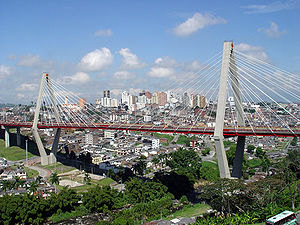 |
|
| 1863 | The name of the Republic is changed officially to "United States of Colombia" through the Rionegro Constitution |  |
|
| 1863 | May 14 | Tomás Cipriano de Mosquera Tomás Cipriano de Mosquera Tomás Cipriano de Mosquera y Arboleda was a Colombian general and political figure. He was president of Colombia four times. The first time was as president of Republic of New Granada from 1845 to 1849. During the Colombian Civil War of 1860-1862 he led liberal forces in a civil war against... is the first President of the United States of Colombia |
 |
| 1863 | November 26 | The Flag of Colombia Flag of Colombia After Miranda later designed his flag based on this conversation, he happily recalled seeing a fresco by Lazzaro Tavarone in the Palazzo Belimbau in Genoa that depicted Christopher Columbus unfurling a similar-coloured flag in Veragua during his fourth voyage.... is officially adopted |
 |
| 1864 | April 8 | Manuel Murillo Toro Manuel Murillo Toro Manuel Murillo Toro was a Colombian politician and statesman, who served as President of the United States of Colombia on two occasions, first from 1864 to 1866, and again between 1872 and 1874.- Biographic data :... is President President of Colombia The President of Colombia is the head of state and head of government of the Republic of Colombia. The office of president was established upon the ratification of the Constitution of 1819, by the Congress of Angostura, convened in December 1819, when Colombia was part of "la Gran Colombia"... of the United States of Colombia United States of Colombia The United States of Colombia was the name adopted in 1861 through the Rionegro Constitution for the nation which had been known as the Republic of New Granada since the dissolution of the federation of Gran Colombia in 1830-1831.... |
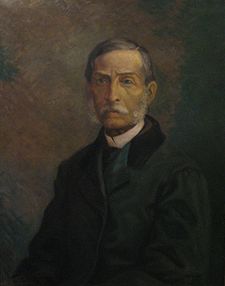 |
| 1865 | Kola Román Kola Román The Kola Román is a Colombian soft drink that was invented in the city of Cartagena, Colombia in 1865 by Don Carlos Román. At the beginning it was similar to a champagne soda but then in the early 1900s it was reinvented by Don Henrique Pio Román.... , a popular Colombian soft drink Soft drink A soft drink is a non-alcoholic beverage that typically contains water , a sweetener, and a flavoring agent... is introduced by Carlos Roman |
 |
|
| 1866 | April 1 | José María Rojas Garrido José María Rojas Garrido José María Rojas Garrido was a Colombian Senator, and statesmen, who as the first Presidential Designate became Acting President of the United States of Colombia in 1866 during the absence of President elect Tomás Cipriano de Mosquera... is President of the United States of Colombia |
 |
| 1866 | May 22 | Tomás Cipriano de Mosquera Tomás Cipriano de Mosquera Tomás Cipriano de Mosquera y Arboleda was a Colombian general and political figure. He was president of Colombia four times. The first time was as president of Republic of New Granada from 1845 to 1849. During the Colombian Civil War of 1860-1862 he led liberal forces in a civil war against... is President of the United States of Colombia for second time |
 |
| 1867 | May 12 | Joaquín Riascos Joaquín Riascos Manuel Joaquín Riascos García was a Colombian General and politician who became acting President in rebellion of the United States of Colombia in 1867 for 45 days.... is President of the United States of Colombia |
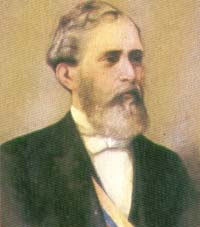 |
| 1867 | May 23 | Manuel María de los Santos Acosta Santos Acosta Manuel María de los Santos Acosta Castillo was a Colombian General and political figure. He served as the president of Colombia from 1867 until 1868.- Biographic data :Acosta was born in Miraflores, Boyacá, on November 1, 1828... is President of the United States of Colombia |
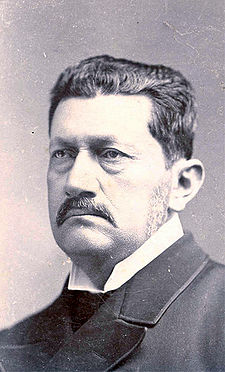 |
| 1867 | Foundation of Leticia, Colombia by Benigno Bustamante |  |
|
| 1868 | April 1 | Santos Gutiérrez Santos Gutiérrez José Santos Gutiérrez Prieto was a Colombian statesman and soldier, who became president of the Sovereign State of Boyacá, and later elected as president of the United States of Colombia for the term of 1868-1870.- Biographic data :... is President of the United States of Colombia |
 |
| 1870 | April 1 | Eustorgio Salgar Eustorgio Salgar Eustorgio Salgar Moreno was a lawyer, Colombian general and political figure, who was president of the Granadine Confederation from 1870 until 1872. Elected at age 39, was one of the youngest Presidents of the nation.- Biographic data :... is President President of Colombia The President of Colombia is the head of state and head of government of the Republic of Colombia. The office of president was established upon the ratification of the Constitution of 1819, by the Congress of Angostura, convened in December 1819, when Colombia was part of "la Gran Colombia"... of the United States of Colombia United States of Colombia The United States of Colombia was the name adopted in 1861 through the Rionegro Constitution for the nation which had been known as the Republic of New Granada since the dissolution of the federation of Gran Colombia in 1830-1831.... |
 |
| 1872 | April 1 | Manuel Murillo Toro Manuel Murillo Toro Manuel Murillo Toro was a Colombian politician and statesman, who served as President of the United States of Colombia on two occasions, first from 1864 to 1866, and again between 1872 and 1874.- Biographic data :... is President President of Colombia The President of Colombia is the head of state and head of government of the Republic of Colombia. The office of president was established upon the ratification of the Constitution of 1819, by the Congress of Angostura, convened in December 1819, when Colombia was part of "la Gran Colombia"... of the United States of Colombia United States of Colombia The United States of Colombia was the name adopted in 1861 through the Rionegro Constitution for the nation which had been known as the Republic of New Granada since the dissolution of the federation of Gran Colombia in 1830-1831.... for second time |
 |
| 1874 | Santiago Pérez de Manosalbas Santiago Pérez de Manosalbas Santiago Pérez de Manosalbas was a Colombian educator, lawyer, diplomat, writer, journalist and statesman who was President of the United States of Colombia between 1874 and 1876.- Biographic data :... is President President of Colombia The President of Colombia is the head of state and head of government of the Republic of Colombia. The office of president was established upon the ratification of the Constitution of 1819, by the Congress of Angostura, convened in December 1819, when Colombia was part of "la Gran Colombia"... of the United States of Colombia United States of Colombia The United States of Colombia was the name adopted in 1861 through the Rionegro Constitution for the nation which had been known as the Republic of New Granada since the dissolution of the federation of Gran Colombia in 1830-1831.... |
 |
|
| 1876 | April 1 | Aquileo Parra Aquileo Parra José Bonifacio Aquileo Elias Parra Gómez was a Colombian soldier, businessman and political figure. He was the president of Colombia between 1876 and 1878.- Biographic data :Aquileo Parra was born in Barichara, Santander, on May 12, 1825... is President President of Colombia The President of Colombia is the head of state and head of government of the Republic of Colombia. The office of president was established upon the ratification of the Constitution of 1819, by the Congress of Angostura, convened in December 1819, when Colombia was part of "la Gran Colombia"... of the United States of Colombia United States of Colombia The United States of Colombia was the name adopted in 1861 through the Rionegro Constitution for the nation which had been known as the Republic of New Granada since the dissolution of the federation of Gran Colombia in 1830-1831.... |
|
| 1878 | April 1 | Julián Trujillo Largacha Julián Trujillo Largacha Julián Trujillo Largacha was a Colombian lawyer, statesman, General of the Army and President of Colombia from 1878 to 1880.- Biographic data :Trujillo was born in Popayán, Cauca, on January 28, 1828... is President President of Colombia The President of Colombia is the head of state and head of government of the Republic of Colombia. The office of president was established upon the ratification of the Constitution of 1819, by the Congress of Angostura, convened in December 1819, when Colombia was part of "la Gran Colombia"... of the United States of Colombia United States of Colombia The United States of Colombia was the name adopted in 1861 through the Rionegro Constitution for the nation which had been known as the Republic of New Granada since the dissolution of the federation of Gran Colombia in 1830-1831.... |
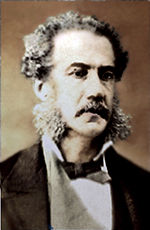 |
| 1880 | April 8 | Rafael Nuñez Rafael Núñez (politician) Rafael Wenceslao Núñez Moledo was a Colombian author, lawyer, journalist and politician, who was elected President of Colombia in 1880 and in 1884. Rafael Núñez was born in Cartagena de Indias, on September 28, 1825. He died in Cartagena on September 18, 1894.-Early life:Little is known about the... is President President of Colombia The President of Colombia is the head of state and head of government of the Republic of Colombia. The office of president was established upon the ratification of the Constitution of 1819, by the Congress of Angostura, convened in December 1819, when Colombia was part of "la Gran Colombia"... of the United States of Colombia United States of Colombia The United States of Colombia was the name adopted in 1861 through the Rionegro Constitution for the nation which had been known as the Republic of New Granada since the dissolution of the federation of Gran Colombia in 1830-1831.... |
 |
| 1882 | April 1 | Francisco Javier Zaldúa Francisco Javier Zaldúa Francisco Javier Martínez de Zaldúa y Racines was a Colombian, lawyer and politician, elected President of Colombia in 1882.- Biographic data :... served as President of the Rionegro Convention, a constituent assembly Constituent assembly A constituent assembly is a body composed for the purpose of drafting or adopting a constitution... that created the United States of Colombia United States of Colombia The United States of Colombia was the name adopted in 1861 through the Rionegro Constitution for the nation which had been known as the Republic of New Granada since the dissolution of the federation of Gran Colombia in 1830-1831.... (now present day Colombia). As President of this legislative body, Zaldúa became the de facto De facto De facto is a Latin expression that means "concerning fact." In law, it often means "in practice but not necessarily ordained by law" or "in practice or actuality, but not officially established." It is commonly used in contrast to de jure when referring to matters of law, governance, or... President of the United States of Colombia for 6 days, when President Tomás Cipriano de Mosquera Tomás Cipriano de Mosquera Tomás Cipriano de Mosquera y Arboleda was a Colombian general and political figure. He was president of Colombia four times. The first time was as president of Republic of New Granada from 1845 to 1849. During the Colombian Civil War of 1860-1862 he led liberal forces in a civil war against... ceded executive power to the Convention, and until the said convention elected a Council of Ministers Council of Ministers of the Republic of Colombia The Council of Ministers of the Republic of Colombia is part of the executive power, and according to the presidential orientation of the Colombian Constitution of 1991, it is a cabinet of advisors to the President of Colombia.-19th century:... to serve collectively as the Colombian head of state Head of State A head of state is the individual that serves as the chief public representative of a monarchy, republic, federation, commonwealth or other kind of state. His or her role generally includes legitimizing the state and exercising the political powers, functions, and duties granted to the head of... . |
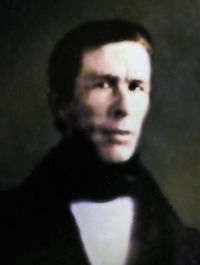 |
| 1882 | December 22 | José Eusebio Otalora José Eusebio Otalora José Eusebio Otálora Martínez was a Colombian statesman and General who became President of the United States of Colombia in 1882 in his capacity as the Second Presidential Designate following the death of President Francisco Javier Zaldúa, and the non acceptance of the office by the First... is President of the United States of Colombia, in his capacity as the Second Presidential Designate following the death of President Francisco Javier Zaldúa Francisco Javier Zaldúa Francisco Javier Martínez de Zaldúa y Racines was a Colombian, lawyer and politician, elected President of Colombia in 1882.- Biographic data :... , and the non acceptance of the office by the First Designate Rafael Núñez Rafael Núñez (politician) Rafael Wenceslao Núñez Moledo was a Colombian author, lawyer, journalist and politician, who was elected President of Colombia in 1880 and in 1884. Rafael Núñez was born in Cartagena de Indias, on September 28, 1825. He died in Cartagena on September 18, 1894.-Early life:Little is known about the... . |
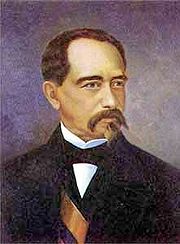 |
| 1884 | April 1 | Ezequiel Hurtado Ezequiel Hurtado Ezequiel Hurtado Hurtado was a politician, military general and statesman who became President of Colombia. He was born in Silvia, in the department of Cauca, 14 December 1825 and died in Popayán, 4 September 1890. His parents were Nicolas Hurtado and Maria Trinidad Hurtado... is President of the United States of Colombia |
 |
| 1884 | August 11 | Rafael Nuñez Rafael Núñez (politician) Rafael Wenceslao Núñez Moledo was a Colombian author, lawyer, journalist and politician, who was elected President of Colombia in 1880 and in 1884. Rafael Núñez was born in Cartagena de Indias, on September 28, 1825. He died in Cartagena on September 18, 1894.-Early life:Little is known about the... is President President of Colombia The President of Colombia is the head of state and head of government of the Republic of Colombia. The office of president was established upon the ratification of the Constitution of 1819, by the Congress of Angostura, convened in December 1819, when Colombia was part of "la Gran Colombia"... of the United States of Colombia United States of Colombia The United States of Colombia was the name adopted in 1861 through the Rionegro Constitution for the nation which had been known as the Republic of New Granada since the dissolution of the federation of Gran Colombia in 1830-1831.... for second time |
 |
| 1884 | August 28 | ETB (company) ETB (company) ETB , formally known as Empresa de Telecomunicaciones de Bogotá S.A. , is the second largest telecommunications company in Colombia. It is headquartered in Bogotá, D.C..-Company history:... is created, being the first telecommunications company in Colombia |
|
| 1886 | President Rafael Nuñez Rafael Núñez (politician) Rafael Wenceslao Núñez Moledo was a Colombian author, lawyer, journalist and politician, who was elected President of Colombia in 1880 and in 1884. Rafael Núñez was born in Cartagena de Indias, on September 28, 1825. He died in Cartagena on September 18, 1894.-Early life:Little is known about the... creates the Colombian Constitution of 1886 Colombian Constitution of 1886 The Colombian Constitution of 1886 was the constitution that created the Republic of Colombia. Before 1886, the country was called United States of Colombia. The coalition of moderate Liberals and Conservatives that ended the liberal hegemony and placed Rafael Nuñez in power repealed the... , which has been one of the longest lasting constitutions in the western hemisphere, and with the Reforms of 1910, 1936, 1958, 1968, 1973 and 1986 was the constitution of Colombia until 1991. The country adopts its present name: "Republic of Colombia" |
||
| 1886 | April 1 | on March 30, 1886, president Núñez presented his resignation to Congress due to his poor health condition caused by dysentery Dysentery Dysentery is an inflammatory disorder of the intestine, especially of the colon, that results in severe diarrhea containing mucus and/or blood in the faeces with fever and abdominal pain. If left untreated, dysentery can be fatal.There are differences between dysentery and normal bloody diarrhoea... . José María Campo Serrano José María Campo Serrano José María Campo Serrano was a Colombian lawyer, general, and statesman, who became President of Colombia after the resignation of the President and the dismissal of the Vice President. He sanctioned the Constitution of 1886 that created the Republic of Colombia proceeding the United States of... is sworn in as Acting President, becoming the first President of Colombian Republic |
 |
| 1887 | January 7 | Eliseo Payán Eliseo Payán José Eliseo Payán Hurtado was a Colombian lawyer, politician, and military officer. Payán as Vice President of Colombia assumed the Presidency of Colombia due to the absence of President Rafael Núñez in 1887.- Biographic data :... is the 2nd president of Colombia |
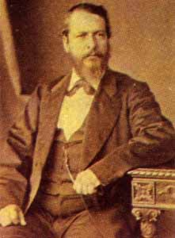 |
| 1887 | June 4 | Rafael Nuñez Rafael Núñez (politician) Rafael Wenceslao Núñez Moledo was a Colombian author, lawyer, journalist and politician, who was elected President of Colombia in 1880 and in 1884. Rafael Núñez was born in Cartagena de Indias, on September 28, 1825. He died in Cartagena on September 18, 1894.-Early life:Little is known about the... is the 3rd President of Colombia |
 |
| 1888 | Carlos Holguín Mallarino Carlos Holguín Mallarino Carlos Holguín Mallarino was a Colombian lawyer, journalist and statesman who became President of Colombia between 1888 and 1892, acting in the absence of President Rafael Núñez.- Biographic data :... is the 4th President of Colombia |
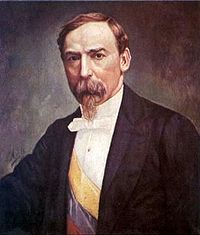 |
|
| 1889 | October 14 | Foundation of Villa Holguin (Later Armenia, Colombia Armenia, Colombia Armenia is the capital of Quindío, a department in Colombia. The city is located at coordinates 4.5170° north, 75.6830° west, 290 kilometers west of Bogotá. Armenia is a mid-size city located between Bogotá, Medellín and Cali, the 3 largest Colombian cities. The city's area code for phone calls is... ) by Jesus Maria Ocampo |
 |
| 1891 | November 5 | Colombian National Police Colombian National Police The National Police of Colombia is the national police force of Colombia. Although the National Police is not part of the Military of Colombia , it constitutes along with them the "Public Force" and is also controlled by the Ministry of Defense. They are the largest police force in Colombia... is created |
 |
| 1892 | August 7 | Miguel Antonio Caro Miguel Antonio Caro Miguel Antonio Caro Tobar was a Colombian scholar, poet, journalist, philosopher, orator, philologist, lawyer and politician.- Biographic data :Miguel Antonio Caro was born in Bogotá on November 10, 1845, and he died in the same city on August 5, 1909.... is the 4th president of Colombia |
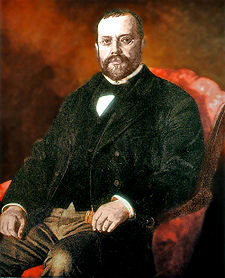 |
| 1892 | September 29 | Rafael Nuñez Rafael Núñez (politician) Rafael Wenceslao Núñez Moledo was a Colombian author, lawyer, journalist and politician, who was elected President of Colombia in 1880 and in 1884. Rafael Núñez was born in Cartagena de Indias, on September 28, 1825. He died in Cartagena on September 18, 1894.-Early life:Little is known about the... is the 5th President of Colombia |
 |
| 1894 | September 18 | Miguel Antonio Caro Miguel Antonio Caro Miguel Antonio Caro Tobar was a Colombian scholar, poet, journalist, philosopher, orator, philologist, lawyer and politician.- Biographic data :Miguel Antonio Caro was born in Bogotá on November 10, 1845, and he died in the same city on August 5, 1909.... is the 6th president of Colombia |
 |
| 1896 | May 26 | Poet José Asunción Silva José Asunción Silva José Asunción Silva was a Colombian poet. He is considered one of the founders of Spanish-American Modernism.-Life:... commits suicide Suicide Suicide is the act of intentionally causing one's own death. Suicide is often committed out of despair or attributed to some underlying mental disorder, such as depression, bipolar disorder, schizophrenia, alcoholism, or drug abuse... |
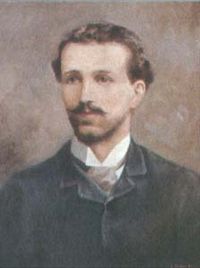 |
| 1898 | Manuel Antonio Sanclemente Manuel Antonio Sanclemente Manuel Antonio Sanclemente Sanclemente was President of Colombia between 1898 and 1900.- Early life :Sanclemente was born in Buga, Valle del Cauca Department on September 19, 1814. He died in Villeta, Cundinamarca on March 19, 1902, during his house arrest. He studied Law at the University of... is the 7th president of Colombia |
||
| 1889 | October 17 | The Thousand Days War Thousand Days War The Thousand Days' War , was a civil armed conflict in the newly created Republic of Colombia, between the Conservative Party, the Liberal Party and its radical factions. In 1899 the ruling conservatives were accused of maintaining power through fraudulent elections... (1899–1902) (Spanish: Guerra de los Mil Días) |
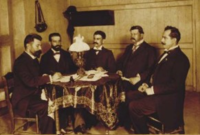 |
20th century
| Year | Date | Event | Image |
|---|---|---|---|
| 1900 | May 26 | President President of Colombia The President of Colombia is the head of state and head of government of the Republic of Colombia. The office of president was established upon the ratification of the Constitution of 1819, by the Congress of Angostura, convened in December 1819, when Colombia was part of "la Gran Colombia"... Manuel Antonio Sanclemente Manuel Antonio Sanclemente Manuel Antonio Sanclemente Sanclemente was President of Colombia between 1898 and 1900.- Early life :Sanclemente was born in Buga, Valle del Cauca Department on September 19, 1814. He died in Villeta, Cundinamarca on March 19, 1902, during his house arrest. He studied Law at the University of... extended the deadline for completion of the Panama Canal Panama Canal The Panama Canal is a ship canal in Panama that joins the Atlantic Ocean and the Pacific Ocean and is a key conduit for international maritime trade. Built from 1904 to 1914, the canal has seen annual traffic rise from about 1,000 ships early on to 14,702 vessels measuring a total of 309.6... from October 31, 1904 to October 31, 1910. The executive decree was granted without consent of the Colombian Congress. |
 |
| 1900 | May 26 | Battle of Palonegro Battle of Palonegro The Battle of Palonegro started on May 26, 1900, in the early days of the Thousand Days War, the commanding general of the Liberal armies, Gabriel Vargas Santos, ordered his troops to retire to Palonegro. Few could have imagined the effect it would have on Colombian history... |
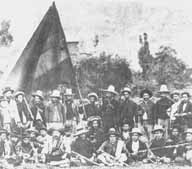 |
| 1900 | June 19 | Date of death of Salvador Camacho Salvador Camacho Salvador Camacho Roldán was a Colombian lawyer, businessman and politician who, as Presidential Designate, served as President of Colombia ad interim in 1868 and again in 1871.... , called the "founder of sociology Sociology Sociology is the study of society. It is a social science—a term with which it is sometimes synonymous—which uses various methods of empirical investigation and critical analysis to develop a body of knowledge about human social activity... " in Colombia. |
 |
| 1900 | July 31 | José Manuel Marroquín José Manuel Marroquín Jose Manuel Marroquin Ricaurte was a Colombian political figure and President of Colombia.- Biographic data :José Manuel Marroquín was born in Bogotá, on August 6, 1827. He died in the same city on September 19, 1908.- Early life :... is president of Colombia |
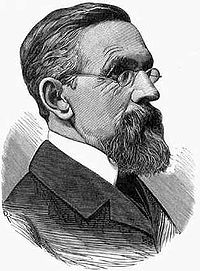 |
| 1900 | August | Naturalist Naturalist Naturalist may refer to:* Practitioner of natural history* Conservationist* Advocate of naturalism * Naturalist , autobiography-See also:* The American Naturalist, periodical* Naturalism... Soto Grimshaw Soto Grimshaw Soto Grimshaw was an Argentine naturalist, explorer and gaucho.Grimshaw was born to British parents in La Pampa Province. Growing up on the family ranch, Grimshaw became well versed in the wrangling and cattle herding skills required of any gaucho. He then went to complete his studies at the... dies of cholera Cholera Cholera is an infection of the small intestine that is caused by the bacterium Vibrio cholerae. The main symptoms are profuse watery diarrhea and vomiting. Transmission occurs primarily by drinking or eating water or food that has been contaminated by the diarrhea of an infected person or the feces... during an expedition to the Caribbean Region of Colombia |
 |
| 1901 | February 23 | Battle of Aguadulce Battle of Aguadulce The Battle of Aguadulce was a battle that occurred during the Thousand Days War, between Liberals and Conservatives. It occurred between February 23 and August 27, 1901 and ended in an overwhelming victory on the part of the Liberal army under the command of General Benjamin Herrera over the... |
|
| 1901 | Colombian Geographer Geographer A geographer is a scholar whose area of study is geography, the study of Earth's natural environment and human society.Although geographers are historically known as people who make maps, map making is actually the field of study of cartography, a subset of geography... Francisco Javier Vergara y Velasco Francisco Javier Vergara y Velasco Francisco Javier Vergara y Velasco was a colombian geographer, cartographer and historian.His major works are the Nueva Geografía de Colombia and the Atlas completo de geografía colombiana , through which he won the Charles Manoir price of the Paris Geographical Society.The anarchist French... publishes the first complete cartographic charts of the country, the Atlas completo de geografía colombiana (1906–1910), through which he won the Charles Manoir price of the Paris Geographical Society. |
||
| 1901 | Manuelita Manuelita Inversiones Manuelita S.A. is a Colombian agribusiness corporation, headquartered in Palmira, Valle del Cauca, whose main products are refined sugar, ethanol, palm oil, mussels and shrimp... became the first Colombian sugar mill to move from mule Mule A mule is the offspring of a male donkey and a female horse. Horses and donkeys are different species, with different numbers of chromosomes. Of the two F1 hybrids between these two species, a mule is easier to obtain than a hinny... to steam powered Steam engine A steam engine is a heat engine that performs mechanical work using steam as its working fluid.Steam engines are external combustion engines, where the working fluid is separate from the combustion products. Non-combustion heat sources such as solar power, nuclear power or geothermal energy may be... mills |
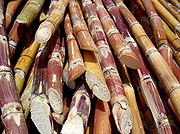 |
|
| 1902 | October 24 | The peace treaty that ends the thousand days war is signed on the Neerlandia plantation | |
| 1903 | Panama Panama Panama , officially the Republic of Panama , is the southernmost country of Central America. Situated on the isthmus connecting North and South America, it is bordered by Costa Rica to the northwest, Colombia to the southeast, the Caribbean Sea to the north and the Pacific Ocean to the south. The... remained as a province of Colombia until this year, when – with backing from the United States in exchange for allowing the US to build the Panama Canal Panama Canal The Panama Canal is a ship canal in Panama that joins the Atlantic Ocean and the Pacific Ocean and is a key conduit for international maritime trade. Built from 1904 to 1914, the canal has seen annual traffic rise from about 1,000 ships early on to 14,702 vessels measuring a total of 309.6... – it became independent (Separation of Panama from Colombia Separation of Panama from Colombia The Separation of Panama from Colombia was formalized on 3 November 1903 with the establishment of the Republic of Panama from the Republic of Colombia's Department of Panama.-Prelude:... ) |
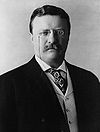 |
|
| 1903 | January22nd | The United States and the Republic of Colombia sign the Hay-Herran Treaty Hay-Herran Treaty The Hay–Herran Treaty was a treaty signed on January 22, 1903 between United States Secretary of State John M. Hay of the United States and Dr. Tomás Herrán of Colombia... |
 |
| 1903 | October 26 | The United States Navy United States Navy The United States Navy is the naval warfare service branch of the United States Armed Forces and one of the seven uniformed services of the United States. The U.S. Navy is the largest in the world; its battle fleet tonnage is greater than that of the next 13 largest navies combined. The U.S... patrol gunboat Gunboat diplomacy In international politics, gunboat diplomacy refers to the pursuit of foreign policy objectives with the aid of conspicuous displays of military power — implying or constituting a direct threat of warfare, should terms not be agreeable to the superior force.... USS Nashville USS Nashville (PG-7) USS Nashville , a gunboat, was the only ship of its class. It was the third ship of the United States Navy to hold the name Nashville.... blocks Colombian attempts to suppress the Panama Panama Panama , officially the Republic of Panama , is the southernmost country of Central America. Situated on the isthmus connecting North and South America, it is bordered by Costa Rica to the northwest, Colombia to the southeast, the Caribbean Sea to the north and the Pacific Ocean to the south. The... nian separatist movement |
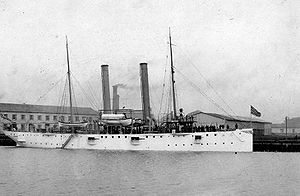 |
| 1904 | June 16 | Date of death of Manuel Uribe Ángel Manuel Uribe Ángel Manuel María Uribe Angel was a Colombian physician, geographer and politician, he has been called the "father of medicine of Antioquia" for his contributions to the advances of the practice of medicine in Colombia and the Antioquia Department... , known for his great contributions to the advances of the practice of medicine in Colombia and the Antioquia Department Antioquia Department Antioquia is one of the 32 departments of Colombia, located in the central northwestern part of Colombia with a narrow section that borders the Caribbean Sea. Most of its territory is mountainous with some valleys, much of which is part of the Andes mountain range... . He also served as President of the then Sovereign State of Antioquia |
|
| 1904 | August 7 | Rafael Reyes Rafael Reyes Rafael Reyes Prieto was Chief of Staff of the Colombian National Army and President of Colombia .- Biographic data :... is president of Colombia |
 |
| 1904 | October 11 | Creation of Postobón Postobón Postobón, S.A. is one of the largest Colombian beverage companies. The company has a wide portfolio of products that includes soft drinks, fruit juices, bottled water, tea, and energy drinks.... soft drink Soft drink A soft drink is a non-alcoholic beverage that typically contains water , a sweetener, and a flavoring agent... s company |
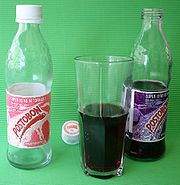 |
| 1910 | August 7 | Carlos Eugenio Restrepo Carlos Eugenio Restrepo For the President of Colombia from 1966 to 1970, see Carlos Lleras RestrepoCarlos Eugenio Restrepo Restrepo was a Colombian lawyer, writer, and statesman, who was elected President of Colombia in 1910. During his administration he worked towards making political reconciliation among the... is president of Colombia |
 |
| 1910 | Colombian astronomer Julio Garavito Armero Julio Garavito Armero Julio Garavito Armero was a Colombian astronomer.Born in Bogotá, he was a child prodigy in science and mathematics. He obtained his degrees as mathematician and civil engineer in the Escuela Nacional de Ingeniería... discovers the crater Impact crater In the broadest sense, the term impact crater can be applied to any depression, natural or manmade, resulting from the high velocity impact of a projectile with a larger body... on the Moon Moon The Moon is Earth's only known natural satellite,There are a number of near-Earth asteroids including 3753 Cruithne that are co-orbital with Earth: their orbits bring them close to Earth for periods of time but then alter in the long term . These are quasi-satellites and not true moons. For more... 's far side which is named after him (Garavito crater Garavito (crater) Garavito is a lunar crater that is located in the southern hemisphere on the Moon's far side. It lies to the north-northwest of the huge walled plain Poincaré, and to the west of the crater Chrétien. It takes its name in honor of the Colombian astronomer Julio Garavito Armero.This crater has a worn... ). |
||
| 1914 | August 7 | José Vicente Concha José Vicente Concha José Vicente Concha was a Colombian politician who served as President of Colombia from 1914-1918. He was also a noted member of the Colombian Conservative Party.- Biographic data :... is president of Colombia |
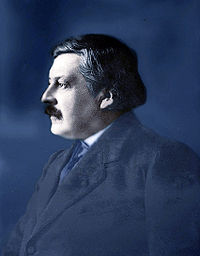 |
| 1915 | May 9 | Indigenous nasa leader Quintín Lame Quintín Lame Manuel Quintín Lame Chantre was an Colombian indigenous rebel from the early 20th century who tried to conform an independent indigenous republic.... is arrested for attempting the creation of an indigenous independent republic |
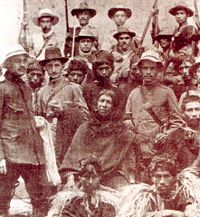 |
| 1918 | Marco Fidel Suarez Marco Fidel Suárez Marco Fidel Suárez was a Colombian political figure. He served as president of Colombia from 1918 to 1921. He was born on April 23, 1855, in the town of Hatoviejo, Antioquia... is president of Colombia |
||
| 1926 | Miguel Abadia Mendez Miguel Abadía Méndez Miguel Abadía Méndez was the 17th President of Colombia . A Conservative party politician, Abadía was the last president of the period known as the Conservative Hegemony, running unopposed and forming a one party Cabinet.- Political career :Abadía, as a young lawyer, was a professor and MP... is president of Colombia |
 |
|
| 1927 | The Federación Nacional de Cafeteros de Colombia Federación Nacional de Cafeteros de Colombia The Federación Nacional de Cafeteros de Colombia , often abbreviated Fedecafé, is a non-profit business association, popularly known for its "Juan Valdez" marketing campaign. The federation was founded in 1927 as a business cooperative that promotes the production and exportation of Colombian coffee... is created |
||
| 1928 | December 6 | The Banana massacre, in Spanish, Matanza de las bananeras or Masacre de las bananeras: A massacre of workers for the United Fruit Company that occurred in the town of Ciénaga near Santa Marta Santa Marta Santa Marta is the capital city of the Colombian department of Magdalena in the Caribbean Region. It was founded in July 29, 1525 by the Spanish conqueror Rodrigo de Bastidas, which makes it the oldest remaining city in Colombia... |
 |
| 1930 | Enrique Olaya Herrera Enrique Olaya Herrera Enrique Alfredo Olaya Herrera was a Colombian journalist and politician, President of Colombia from August 7, 1930 until August 7, 1934 representing the Colombian Liberal Party.- Early years :... is president of Colombia |
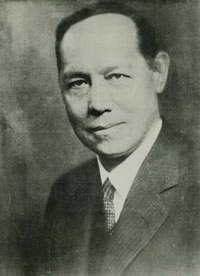 |
|
| 1932 | September 1 | The Colombia-Peru War Colombia-Peru War The Colombia–Peru War was an armed conflict between the Republic of Colombia and the Republic of Peru.-Civilian takeover:... |
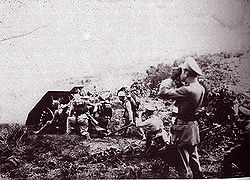 |
| 1934 | Alfonso López Pumarejo Alfonso López Pumarejo Alfonso López Pumarejo was a two-time Colombian president and political figure, as a member of the Colombian Liberal Party. He served as president of Colombia for the first time between 1934 and 1938 and again between 1942 and 1945.... is president of Colombia |
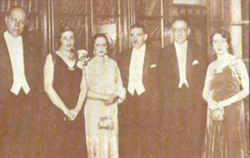 |
|
| 1934 | First census Census A census is the procedure of systematically acquiring and recording information about the members of a given population. It is a regularly occurring and official count of a particular population. The term is used mostly in connection with national population and housing censuses; other common... in Colombia. Population:8.700.000 |
||
| 1935 | June 24 | Argentine Argentina Argentina , officially the Argentine Republic , is the second largest country in South America by land area, after Brazil. It is constituted as a federation of 23 provinces and an autonomous city, Buenos Aires... singer Carlos Gardel Carlos Gardel Carlos Gardel was a singer, songwriter and actor, and is perhaps the most prominent figure in the history of tango. He was born in Toulouse, France, although he never acknowledged his birthplace publicly, and there are still claims of his birth in Uruguay. He lived in Argentina from the age of two... dies in a plane crash in Medellín Medellín Medellín , officially the Municipio de Medellín or Municipality of Medellín, is the second largest city in Colombia. It is in the Aburrá Valley, one of the more northerly of the Andes in South America. It has a population of 2.3 million... |
 |
| 1938 | Eduardo Santos Montejo is president of Colombia | 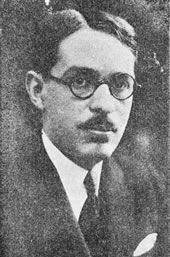 |
|
| 1942 | Alfonso López Pumarejo Alfonso López Pumarejo Alfonso López Pumarejo was a two-time Colombian president and political figure, as a member of the Colombian Liberal Party. He served as president of Colombia for the first time between 1934 and 1938 and again between 1942 and 1945.... is president of Colombia for a second time |
||
| 1945 | April 29 | Date of death of impressionist painter Andrés de Santa Maria Andrés de Santa Maria Andrés de Santa Maria was the most internationally known Colombian painter of his time and the pioneer of impressionism in Colombia. His work in solitary as a vanguardist painter, frames the beginnings of modern art in Colombia. Santa Maria search of new artistic expressions generated rejection... |
|
| 1945 | Alberto Lleras Camargo Alberto Lleras Camargo Alberto Lleras Camargo was an important Colombian diplomat and political figure.He was a member of the Liberal Party of Colombia; he served as congressman , Minister of Education, Minister of the Interior and Minister of Foreign Affairs, during the governments of Alfonso López Pumarejo and Eduardo... is president of Colombia |
||
| 1946 | Mariano Ospina Pérez Mariano Ospina Pérez Luis Mariano Ospina Pérez was a Colombian engineer and political figure, member of the Colombian Conservative Party. He served as President of Colombia between 1946 and 1950.- Biographic data :... is president of Colombia |
||
| 1948 | April 9 | Murder of politician Jorge Eliécer Gaitán Jorge Eliécer Gaitán Jorge Eliécer Gaitán Ayala was a politician, a leader of a populist movement in Colombia, a former Education Minister and Labor Minister , mayor of Bogotá and one of the most charismatic leaders of the Liberal Party.He was assassinated during his second presidential campaign in 1948, setting off... . Bogotazo Bogotazo El Bogotazo refers to the massive riots that followed the assassination in Bogotá, Colombia of Liberal leader and presidential candidate Jorge Eliécer Gaitán on April 9, 1948 during the government of President Mariano Ospina Pérez... riots. Starts the bipartisan violence ("La Violencia La Violencia La Violencia is a period of civil conflict in the Colombian countryside between supporters of the Colombian Liberal Party and the Colombian Conservative Party, a conflict which took place roughly from 1948 to 1958 .... ") |
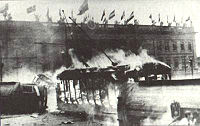 |
| 1950 | Laureano Gómez Castro is president of Colombia |  |
|
| 1953 | June 13 | Gustavo Rojas Pinilla Gustavo Rojas Pinilla Gustavo Rojas Pinilla was a Colombian politician, military officer, General of the Army and President of Colombia between 1953 and 1957.- Biographic data :... seized power by means of a coup d'état Coup d'état A coup d'état state, literally: strike/blow of state)—also known as a coup, putsch, and overthrow—is the sudden, extrajudicial deposition of a government, usually by a small group of the existing state establishment—typically the military—to replace the deposed government with another body; either... |
 |
| 1954 | August 3 | President Rojas Pinilla government gives women the right to vote Women's suffrage Women's suffrage or woman suffrage is the right of women to vote and to run for office. The expression is also used for the economic and political reform movement aimed at extending these rights to women and without any restrictions or qualifications such as property ownership, payment of tax, or... |
|
| 1954 | Rojas Pinilla introduced the Television in Colombia Television in Colombia Television in Colombia or Colombian television is a media of Colombia. It is characterized for broadcasting telenovelas, series, game shows and TV news. Until 1998 it was a state monopoly... |
||
| 1955 | Rojas Pinilla ordered a military offensive against rearmed peasants triggering a confrontation known as the "Guerra de Villarrica" (War of Villarrica) which took place in the central town of Villarrica Villarrica Villarrica may refer to:*Villarrica, Paraguay - a city in Southern Paraguay*Villarrica, Colombia - a municipality in the Tolima department of Colombia*Villarrica, Chile - a city in Chile*Lake Villarrica - a lake in Chile... in Tolima Department. |
||
| 1956 | June 24 | the Liberal Party headed by Alberto Lleras Camargo and the Conservative Party headed by Laureano Gómez signed an accord on June 24, 1956 to begin the National Front (Colombia) National Front (Colombia) National Front was a period in the history of Colombia in which the two main political parties; Liberal Party and Conservative Party agreed to let the opposite party govern, intercalating for a period of four presidential terms.... . |
 |
| 1958 | Dr. Jorge Reynolds Pompo is credited with having helped in the design of the first successful internal pacemaker Pacemaker An artificial pacemaker is a medical device that uses electrical impulses to regulate the beating of the heart.Pacemaker may also refer to:-Medicine:... |
||
| 1960 | Creation of the first Natural protected area in Colombia, the Cueva de los Guacharos Cueva de los Guácharos The Cueva de los Guácharos National Park , created in 1960, is the oldest of the 51 protected areas of Colombia. The park is located in the western face of the Colombian Eastern Andean Range in the departments of Huila and Caquetá... National park |
 |
|
| 1961 | October 28 | Hurricane Hattie Hurricane Hattie Hurricane Hattie was the deadliest tropical cyclone of the 1961 Atlantic hurricane season, as well as the strongest, reaching a peak intensity equivalent to Category 5 hurricane intensity... moves over San Andrés San Andrés (island) San Andrés is a coral island among the Colombian islands in the Caribbean Sea; it is the largest island of the southern group of islands. Together with the nearby island of Providencia and some smaller islands of the southern group of the Colombian archipelago, San Andrés forms the department of... island with winds of 80 mph (130 km/h), causing 1 death, 15 injuries, and $300,000 in damage (1961 USD, $2.1 million 2008 USD). |
 |
| 1962 | Guillermo León Valencia Guillermo León Valencia Guillermo León Valencia Muñóz was a Colombian lawyer and statesman, who served as President of Colombia from August 7, 1962 to August 7, 1966.-Personal life:... is president of Colombia |
||
| 1962 | July 25 | Luz Marina Zuluaga Luz Marina Zuluaga Luz Marina Zuluaga is a Colombian beauty pageant winner and Miss Universe 1958. She is the only Colombian in history to hold the Miss Universe title.-Biography:... wins Miss Universe Miss Universe Miss Universe is an annual international beauty contest that is run by the Miss Universe Organization. The pageant is the most publicized beauty contest in the world with 600 million viewers.... beauty contest |
|
| 1964 | The refractive surgery Refractive surgery Refractive eye surgery is any eye surgery used to improve the refractive state of the eye and decrease or eliminate dependency on glasses or contact lenses. This can include various methods of surgical remodeling of the cornea or cataract surgery. The most common methods today use excimer lasers to... keratomileusis Keratomileusis Keratomileusis is the surgical improvement of the refractive state of the cornea performed by lifting up the front surface of the eye by forming a thin hinged flap under which the shape of the cornea is changed by using an excimer laser or other surgical device, and was developed by José Ignacio... was developed by Ignacio Barraquer Ignacio Barraquer Ignacio Barraquer was a Spanish ophthalmologist known for his contributions to the advancement of cataract surgery. Barraquer was born in Barcelona, Catalonia, Spain... in Bogotá. |
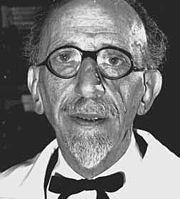 |
|
| 1964 | May | Marquetalia Republic Marquetalia Republic "Marquetalia Republic" was a term used to unofficially refer to one of the enclaves in rural Colombia which communist peasant guerrillas held during the aftermath of "La Violencia"... is overrun by the Colombian army (during what was termed "Operation Marquetalia") |
|
| 1965 | January 7 | The National Liberation Army (Colombia) National Liberation Army (Colombia) National Liberation Army is a revolutionary, avowed Marxist guerrilla group that has been operating in several regions of Colombia since 1964.... (ELN) guerrilla is created |
|
| 1966 | Carlos Lleras Restrepo Carlos Lleras Restrepo Carlos Lleras Restrepo was a Colombian lawyer and political figure, President of Colombia .- Biographic data :... is president of Colombia |
 |
|
| 1970 | Misael Pastrana Borrero Misael Pastrana Borrero Misael Pastrana Borrero , was a Conservative Party politician and President of Colombia from 1970 to 1974, the last presidential period of the National Front. Misael Pastrana became President after a close election campaign against Gen. Gustavo Rojas Pinilla, a former dictator. Mr... is president of Colombia |
||
| 1972 | Discovery of Ciudad Perdida Ciudad Perdida Ciudad Perdida is the archaeological site of an ancient city in Sierra Nevada, Colombia. It is believed to have been founded about 800 AD, some 650 years earlier than Machu Picchu... archaeological place |
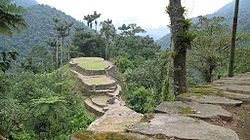 |
|
| 1974 | Alfonso López Michelsen Alfonso López Michelsen Alfonso López Michelsen was a Colombian politician, lawyer and journalist. Lopez Michelsen was President of Colombia from 1974 to 1978. He was the son of Alfonso López Pumarejo, who was also president of Colombia from 1934 to 1938, and once again from 1942 to 1945... is president of Colombia |
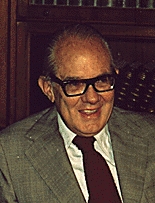 |
|
| 1974 | The Black Tuna Gang Black Tuna Gang The Black Tuna gang was an American marijuana-smuggling organization active in 1970s Miami. The group were responsible for bringing in around 500 tons of marijuana into the United States over the course of 16 months.... , a Miami-based Colombian marijuana-trafficking group was responsible for bringing in over 500 tons of marijuana over a 16-month period in the mid-70s ("the marijuana bonanza"). |
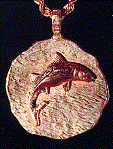 |
|
| 1976 | December | Starts the development of Cerrejón Cerrejón Cerrejón is a coal mine located in the Guajira department in the north of Colombia. It is the largest mining operation in Colombia and among the largest open-pit coal mines in the world. The legal entity managing the Cerrejón operation is known as Carbones del Cerrejón Ltd... Coal mine. It is the largest mining operation in Colombia and among the largest open-pit Open-pit mining Open-pit mining or opencast mining refers to a method of extracting rock or minerals from the earth by their removal from an open pit or borrow.... coal mines in the world |
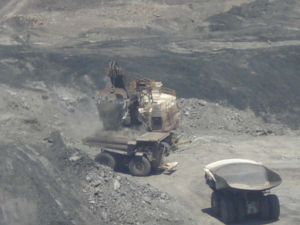 |
| 1978 | Julio César Turbay Ayala Julio César Turbay Ayala Julio César Turbay Ayala was a Colombian politician, member of the Colombian Liberal Party, elected president of the Senate of Colombia and and, was president of Colombia from 1978 to 1982.- Biographic data :... is president of Colombia |
 |
|
| 1980 | February 27 | Dominican embassy siege Dominican embassy siege The Dominican Embassy siege was the 1980 siege of the embassy of the Dominican Republic by M-19 guerrillas in Bogotá, Colombia. The guerrillas held nearly 60 people, including 14 ambassadors, hostage for 61 days.-The Siege:... |
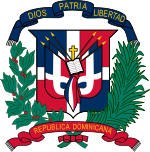 |
| 1980 | June | Serial killer Serial killer A serial killer, as typically defined, is an individual who has murdered three or more people over a period of more than a month, with down time between the murders, and whose motivation for killing is usually based on psychological gratification... Pedro López Pedro López Pedro Alonso López is a Colombian-born confessed serial killer, accused of raping and killing more than 300 girls across South America... a.k.a Monster of the Andes confessed to over 300 murders |
 |
| 1981 | Homosexuality in Colombia LGBT in Colombia The initialism LGBT is used to refer collectively to lesbian, gay, bisexual, and transgender people and members of the specific group and to the community that surrounds them... is declared legal by the national government |
||
| 1982 | Belisario Betancur Belisario Betancur Belisario Betancur Cuartas is a Colombian statesman, who as a member of the Colombian Conservative Party was President of Colombia from 1982 to 1986.- Biographic data :... is elected president of Colombia |
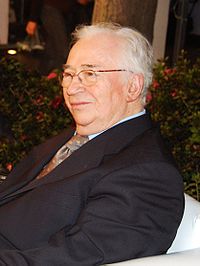 |
|
| 1982 | Paramilitary Paramilitary A paramilitary is a force whose function and organization are similar to those of a professional military, but which is not considered part of a state's formal armed forces.... group "Muerte a Secuestradores Muerte a Secuestradores Muerte a Secuestradores or MAS, was a Colombian paramilitary group supported by drug cartels, U.S. corporations, Colombian politicians, and wealthy landowners during the 1980s, in order to protect their economic interests, assassinate political opponents and community organizers, and wage... " (MAS) is formed |
||
| 1982 | Antioquian entrepreneur Felix Correa and his bank FURATENA get convicted for financial fraud causing a collapse in the national financial system | ||
| 1982 | September 1 | Mother Teresa Mother Teresa Mother Teresa , born Agnes Gonxha Bojaxhiu , was a Roman Catholic nun of Albanian ethnicity and Indian citizenship, who founded the Missionaries of Charity in Calcutta, India, in 1950... visits Colombia |
 |
| 1982 | October | Gabriel García Márquez Gabriel García Márquez Gabriel José de la Concordia García Márquez is a Colombian novelist, short-story writer, screenwriter and journalist, known affectionately as Gabo throughout Latin America. He is considered one of the most significant authors of the 20th century. He was awarded the Nobel Prize in Literature in... win the Nobel Prize Nobel Prize The Nobel Prizes are annual international awards bestowed by Scandinavian committees in recognition of cultural and scientific advances. The will of the Swedish chemist Alfred Nobel, the inventor of dynamite, established the prizes in 1895... in literature |
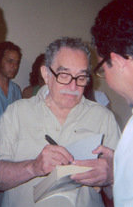 |
| 1982 | Colombia resigns as host for 1986 Soccer World Cup due to scarcity of public resources | ||
| 1983 | March 31 | Popayán Popayán Popayán is the capital of the Colombian department of Cauca. It is located in southwestern Colombia between Colombia's Western Mountain Range and Central Mountain Range... is partially destroyed by an earthquake Earthquake An earthquake is the result of a sudden release of energy in the Earth's crust that creates seismic waves. The seismicity, seismism or seismic activity of an area refers to the frequency, type and size of earthquakes experienced over a period of time... during the traditional celebrations of Holy week Holy Week Holy Week in Christianity is the last week of Lent and the week before Easter... |
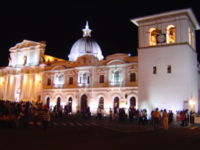 |
| 1983 | Pablo Escobar Pablo Escobar Pablo Emilio Escobar Gaviria was a Colombian drug lord. He was an elusive cocaine trafficker and rich and successful criminal. He owned numerous luxury residences, automobiles, and even airplanes... attends Colombian congress sessions as backup of congressman Jairo Ortega |
||
| 1983 | President Betancur announces Colombia has signed in the Non-Aligned Movement Non-Aligned Movement The Non-Aligned Movement is a group of states considering themselves not aligned formally with or against any major power bloc. As of 2011, the movement had 120 members and 17 observer countries... |
 |
|
| 1983 | Businessman Roberto Soto steals 13.5 million dollars from the national budget with the help of a teleprinter Teleprinter A teleprinter is a electromechanical typewriter that can be used to communicate typed messages from point to point and point to multipoint over a variety of communication channels that range from a simple electrical connection, such as a pair of wires, to the use of radio and microwave as the... machine |
||
| 1983 | General Prosecutor Carlos Jimenez declares that MAS group have underground relations of support with the National Army | ||
| 1983 | Guerrilla leader Manuel Marulanda Manuel Marulanda Pedro Antonio Marín Marín , known by his "nom de guerre" Manuel Marulanda Vélez, was the main leader of the FARC-EP... announces to the press that the FARC guerrilla has grown to 28 main divisions, causing international concern |
||
| 1983 | 1983 Guerrilla leader Jaime Bateman Cayon a.k.a. "El Flaco" dies in a plane crash near the Gulf of Urabá Gulf of Urabá The Gulf of Urabá is a gulf on the northern coast of South America. It is part of the Caribbean Sea. It is a long narrow inlet in the coast of Colombia, close to the connection of the continent to the Isthmus of Panama. The town of Turbo lies at the southern end of the Gulf... while traveling from Santa Marta Santa Marta Santa Marta is the capital city of the Colombian department of Magdalena in the Caribbean Region. It was founded in July 29, 1525 by the Spanish conqueror Rodrigo de Bastidas, which makes it the oldest remaining city in Colombia... to Panama Panama Panama , officially the Republic of Panama , is the southernmost country of Central America. Situated on the isthmus connecting North and South America, it is bordered by Costa Rica to the northwest, Colombia to the southeast, the Caribbean Sea to the north and the Pacific Ocean to the south. The... |
 |
|
| 1983 | Jumbo 747 airplane of Avianca airllines, in flight from Bogotá Bogotá Bogotá, Distrito Capital , from 1991 to 2000 called Santa Fé de Bogotá, is the capital, and largest city, of Colombia. It is also designated by the national constitution as the capital of the department of Cundinamarca, even though the city of Bogotá now comprises an independent Capital district... , crashes in Mejorana del campo, near Barajas airport in Madrid Madrid Madrid is the capital and largest city of Spain. The population of the city is roughly 3.3 million and the entire population of the Madrid metropolitan area is calculated to be 6.271 million. It is the third largest city in the European Union, after London and Berlin, and its metropolitan... , Spain. 189 passengers die, including Art critic Art critic An art critic is a person who specializes in evaluating art. Their written critiques, or reviews, are published in newspapers, magazines, books and on web sites... Marta Traba Marta traba Marta Traba Taín was an art critic and writer well known for her important contributions in the study of Latin American art.... |
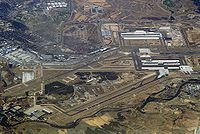 |
|
| 1984 | Minister of Justice Rodrigo Lara Bonilla Rodrigo Lara Bonilla Rodrigo Lara Bonilla was a Colombian lawyer and politician, who served as Minister of Justice under President Belisario Betancur, and was assassinated by orders of Pablo Escobar because of his work as Minister in prosecuting cocaine traffickers mainly belonging to the Medellín Cartel.Lara's death... is shot to death by teenager hitmen hired by the Medellín Cartel Medellín Cartel The Medellín Cartel was an organized network of "drug suppliers and smugglers" originating in the city of Medellín, Colombia. The drug cartel operated in Colombia, Bolivia, Peru, Central America, the United States, as well as Canada and Europe throughout the 1970s and 1980s. It was founded and... . One of the hitmen, Byron de Jesus Velasquez, is captured |
||
| 1984 | March 10 | Tranquilandia Tranquilandia Tranquilandia, was the name of the large cocaine processing laboratory located in the jungles of Caquetá, Colombia. Tranquilandia was constructed for the Medellín Cartel by José Gonzalo Rodríguez Gacha, also known as the Mexican... , a large cocaine Cocaine Cocaine is a crystalline tropane alkaloid that is obtained from the leaves of the coca plant. The name comes from "coca" in addition to the alkaloid suffix -ine, forming cocaine. It is a stimulant of the central nervous system, an appetite suppressant, and a topical anesthetic... processing laboratory located in the jungles of Caquetá Caquetá Caquetá may refer to:* Caquetá River, a river in Colombia* Caquetá Territory, a former territory of Colombia* Caquetá Department, a department of Colombia... , constructed for the Medellín Cartel Medellín Cartel The Medellín Cartel was an organized network of "drug suppliers and smugglers" originating in the city of Medellín, Colombia. The drug cartel operated in Colombia, Bolivia, Peru, Central America, the United States, as well as Canada and Europe throughout the 1970s and 1980s. It was founded and... is destroyed by units of the Colombian National Police, assisted by the DEA |
 |
| 1984 | President Betancur achieves a ceasefire Ceasefire A ceasefire is a temporary stoppage of a war in which each side agrees with the other to suspend aggressive actions. Ceasefires may be declared as part of a formal treaty, but they have also been called as part of an informal understanding between opposing forces... with 80% of guerrilla forces in the country. In the case of FARC, this would be linked to the creation of the political movement Patriotic Union (Colombia) Patriotic Union (Colombia) The Patriotic Union or UP , was a leftist Colombian political party founded by the FARC and the Colombian Communist Party in 1985, as part of the peace negotiations that the guerrillas held with the Conservative Belisario Betancur administration... UP during the next year. |
||
| 1984 | Dissident guerrilla 19th of April Movement 19th of April Movement The 19th of April Movement or M-19, was a Colombian guerrilla movement. After its demobilization it became a political party, the M-19 Democratic Alliance , or AD/M-19.The M-19 traced its origins to the allegedly fraudulent presidential elections of 19 April 1970... (M-19) attacks Florencia, Caquetá Florencia, Caquetá Florencia is a municipality and capital city of the Department of Caquetá, Colombia. It is the most important city in southeast Colombia because of its population as well as its more than a hundred years of history.... . Over 100 civilians dead |
 |
|
| 1985 | January 10 | Elkin Lucena performed the fist successful In vitro fertilization, that allowed the birth of the first Latin American test tube baby (Carolina Mendez). | |
| 1985 | The Gorgona Island Gorgona, Colombia Gorgona is a Colombian island in the Pacific Ocean situated about 50 km off the Colombian Pacific coast and part of the municipality of Guapi in the Department of Cauca. The island is about 9 km long and 2.5 km wide, with a maximum height of 338 m ; with an area of 10 square miles... prison is dissolved and the island is declared National park |
||
| 1985 | May 23 | Guerrilla leader Antonio Navarro Antonio Navarro Antonio Navarro can refer to:* Antonio Navarro Wolff, a Colombian politician* Antonio Navarro , a Mexican Olympic fencer... is victim of a bomb that nearly killed him, and loses one leg |
|
| 1985 | July | Colombian cyclist Luis Herrera Luis Herrera Luis Alberto "Lucho" Herrera Herrera known as "el jardinerito" is a retired Colombian road racing cyclist... wins the Vuelta a España, first South American to win a Grand Tour |
|
| 1985 | September 16 | Ceroxylon quindiuense Ceroxylon quindiuense Ceroxylon quindiuense , is a palm native to the Andean high altitude valley of Cocora in the department of Quindío, northwest Colombia.-Description:... is declared as the National tree National symbols of Colombia The National symbols of Colombia are the symbols which represent the national identity of the Republic of Colombia as a sovereign state. The national symbols intend to represent the Colombian identity by creating visual, verbal cultural iconic representations of the national people, values,... by the national government |
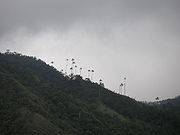 |
| 1985 | November 6 | M19 guerrilla attacks the supreme court in the Palace of Justice siege Palace of Justice siege The Palace of Justice siege was a 1985 attack against the Supreme Court of Colombia, in which members of the M-19 guerrilla group took over the Palace of Justice in Bogotá, Colombia, and held the Supreme Court hostage, intending to hold a trial against President Belisario Betancur... . The president of the Supreme Court of Colombia Supreme Court of Colombia The Supreme Court of Colombia in Bogotá is the highest judicial body in civil and penal matters and issues of criminal and civil procedure in Colombia... and many magistrates, employees and bystanders get killed. Over 100 fatal victims and undetermined number of missing persons. The army is accused of forced disappearance Forced disappearance In international human rights law, a forced disappearance occurs when a person is secretly abducted or imprisoned by a state or political organization or by a third party with the authorization, support, or acquiescence of a state or political organization, followed by a refusal to acknowledge the... of civilians |
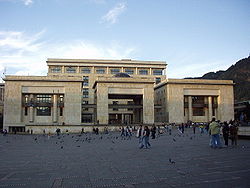 |
| 1985 | November 13 | In the worst natural disaster Natural disaster A natural disaster is the effect of a natural hazard . It leads to financial, environmental or human losses... in the history of Colombia, Armero Armero The Armero tragedy was one of the major consequences of the eruption of the Nevado del Ruiz stratovolcano in Tolima, Colombia on November 13, 1985... city in Tolima Department is destroyed due to a flood created by the eruption of Nevado del Ruiz Nevado del Ruiz The Nevado del Ruiz, also known as La Mesa de Herveo or Kumanday in the language of the local pre-Columbian indigenous people, is a volcano located on the border of the departments of Caldas and Tolima in Colombia, about west of the capital city Bogotá. It is a stratovolcano, composed of many... volcano (Armero tragedy). Over 20.000 dead. Countless homes destroyed. |
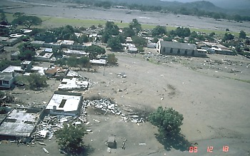 |
| 1985 | December 14 | Cardiologist Alberto Villegas performed the first heart transplant in Latin America to Antonio Yepes. | |
| 1986 | Virgilio Barco is elected president of Colombia | 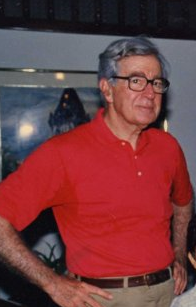 |
|
| 1986 | El Espectador El Espectador El Espectador is a newspaper with national circulation within Colombia, founded by Fidel Cano Gutiérrez on 22 March 1887 in Medellín and published since 1915 in Bogotá... newspaper director, Guillermo Cano is shot to death by hitmen |
||
| 1986 | Guerrilla leader Javier Delgado kills 150 fellow guerrilleros of the Ricardo Franco Group, in the Tacueyó massacre Jose Fedor Rey Jose Fedor Rey aka Javier Delgado was a Colombian guerrilla, and leader of the Ricardo Franco Front.-References:... , because he suspected them to be infiltrated |
||
| 1986 | December 4 | Campo Elías Delgado Campo Elías Delgado Campo Elías Delgado was a Colombian Vietnam War veteran who killed 30 people, and wounded 15 more, most of them at a luxurious Bogotá restaurant called Pozzetto, before apparently being shot dead by police... Morales, a Vietnam War Vietnam War The Vietnam War was a Cold War-era military conflict that occurred in Vietnam, Laos, and Cambodia from 1 November 1955 to the fall of Saigon on 30 April 1975. This war followed the First Indochina War and was fought between North Vietnam, supported by its communist allies, and the government of... veteran Veteran A veteran is a person who has had long service or experience in a particular occupation or field; " A veteran of ..."... kills 28 persons (including his mother) and leaves 15 injured, in the Pozzetto restaurant massacre, presumably due to mental illness. The events are depicted in the 2006 movie Satanás (film) Satanás (film) Satanás is a 2007 Colombian film directed by Andi Baiz. It is adapted from the novel of the same title by Mario Mendoza Zambrano... |
 |
| 1986 | July 3 | Pope John Paul II visits Bogotá and the remains of Armero tragedy |  |
| 1986 | August 9 | Miguel "Happy" Lora wins the world boxing championship in the bantamweight division |  |
| 1987 | February 4 | Drug dealer Carlos Lehder Carlos Lehder Carlos Enrique Lehder Rivas or simply Carlos Lehder is a German-Colombian drug dealer currently imprisoned in the United States, having been co-founder of the Medellín Cartel.... is captured in a farm near Medellín Medellín Medellín , officially the Municipio de Medellín or Municipality of Medellín, is the second largest city in Colombia. It is in the Aburrá Valley, one of the more northerly of the Andes in South America. It has a population of 2.3 million... at 6:20a.m. The same day at 5:20 p.m he is extradited and sent in a DEA Drug Enforcement Administration The Drug Enforcement Administration is a federal law enforcement agency under the United States Department of Justice, tasked with combating drug smuggling and use within the United States... turbocommander airplane to USA |
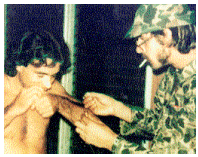 |
| 1987 | October 11 | UP leaders Jaime Pardo Leal Jaime Pardo Leal Jaime Pardo Leal was the candidate of the Patriotic Union for the presidency of Colombia in the 1986 elections.Members of the Patriotic Union became the target of multiple death threats and assassination attempts... and Hector Abad are killed in La Mesa, Cundinamarca. Eventually this movement would be lose more than 3000 of their members due to violence |
 |
| 1987 | Guerrilla groups attack a military convoy in Caqueta breaking the 1984 truce. 42 soldiers dead and 27 injured | ||
| 1987 | Colombian Navy ship ARC Caldas sails in waters of Atlantic ocean Atlantic Ocean The Atlantic Ocean is the second-largest of the world's oceanic divisions. With a total area of about , it covers approximately 20% of the Earth's surface and about 26% of its water surface area... in dispute with Venezuela Venezuela Venezuela , officially called the Bolivarian Republic of Venezuela , is a tropical country on the northern coast of South America. It borders Colombia to the west, Guyana to the east, and Brazil to the south... creating a serious diplomatic incident |
||
| 1988 | Paramillitary groups commit massacres in Saiza, Mejor Esquina and Segovia, Antioquia Segovia, Antioquia Segovia is a town and municipality in Antioquia Department, Colombia. Part of the subregion of Northeastern Antioquia.... |
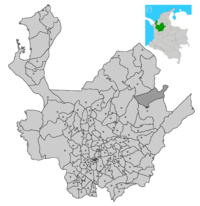 |
|
| 1988 | March 21 | Colombian Painter Dario Morales dies in Paris | |
| 1988 | General Prosecutor Carlos Mauro Hoyos is killed by hitmen | ||
| 1988 | The first election of city majors for popular vote | ||
| 1988 | June | Serial killer Serial killer A serial killer, as typically defined, is an individual who has murdered three or more people over a period of more than a month, with down time between the murders, and whose motivation for killing is usually based on psychological gratification... Daniel Barbosa Daniel Barbosa Daniel Camargo Barbosa was a psychopathic serial killer from Colombia, South America. It is believed that he raped and killed over 150 young girls in Colombia and Ecuador during the 1970s and 1980s.-Early life:... a.k.a the Beast Of The Andes confessed 72 murders |
 |
| 1988 | Politicians Álvaro Gómez Hurtado Álvaro Gómez Hurtado Álvaro Gómez Hurtado was a Colombian lawyer, politician, journalist and active member of the Colombian Conservative Party. Gómez was a son of the former President of Colombia, Laureano Gómez... and Andrés Pastrana are kidnapped by narcotrafficking related groups |
||
| 1988 | collapse of Stock market due to incarceration of financial managers Juan Ricardo Escobar and Guillermo Uribe Holguin | ||
| 1988 | Massacre of Trujillo Massacre of Trujillo The Massacre of Trujillo was a series of murders perpetrated between 1988 and 1994 in the town of Trujillo, Valle del Cauca Department in southwestern Colombia by paramilitaries and the Cali Cartel with the complicity of active members of the Colombian military and police.Some 245 to 342 people,... , 107 victims. On December 19, 2006 Henry Loaiza-Ceballos was accused by Colombian authorities of being responsible for the massacre |
 |
|
| 1988 | First Iberoamerican Theater Festival Iberoamerican Theater Festival Theater in Colombia was introduced during the Spanish colonization in 1550 through zarzuela companies. Colombian theater in Colombia is currently supported by the Ministry of Culture and a number of private and state owned organizations... in Bogotá. 100.000 people attend to the closing act in Plaza de Bolívar |
||
| 1988 | August 18 | Luis Carlos Galán Luis Carlos Galán Luis Carlos Galán Sarmiento was a Colombian journalist and liberal politician who ran for the presidency of Colombia on two occasions, the first time representing the Liberal Party in 1982 which he lost to Belisario Betancur... , Politician and candidate to presidency is killed by hitmen in Soacha Soacha Soacha is the city of Colombia on the southern edge of Bogotá, the country's capital. It has an important industrial zone and is home to mostly working class families.-Demographics:... during a public speech |
|
| 1989 | November 27 | Avianca Flight 203 Avianca Flight 203 Avianca Airlines Flight 203 was a Colombian domestic passenger flight from El Dorado International Airport in Bogotá to Alfonso Bonilla Aragón International Airport in Cali. It was destroyed by a bomb over the municipality of Soacha on November 27, 1989.... airplane HK1803 explodes in the air with 107 people on board, few minutes after leaving El Dorado International Airport El Dorado International Airport El Dorado International Airport is an international airport located in Bogotá, Colombia. It is the largest Latin America airport in terms of cargo movements with 593,946 tons and the third in terms of passenger traffic, only behind São Paulo-Guarulhos International Airport and Mexico City's... as a result of a bomb planted by the Medellín Cartel Medellín Cartel The Medellín Cartel was an organized network of "drug suppliers and smugglers" originating in the city of Medellín, Colombia. The drug cartel operated in Colombia, Bolivia, Peru, Central America, the United States, as well as Canada and Europe throughout the 1970s and 1980s. It was founded and... . No survivors |
|
| 1989 | December 6 | 7:30 a.m. The Security Administration Department building (Departamento Administrativo de Seguridad Departamento Administrativo de Seguridad The Administrative Department of Security was the Security Service agency of Colombia, also responsible for the immigration services. It was dissolved on 31 October 2011 as part of a wider Executive Reform, and it was superseded by the National Directorate of Intelligence, DNI.- Activities :Its... DAS) and an important part of the commercial area of Paloquemao Paloquemao (TransMilenio) The simple-station Paloquemao is part of the TransMilenio mass-transit system of Bogotá, Colombia, opened in the year 2000.-Location:The station is located in the western part of downtown Bogotá, specifically on the Avenida NQS with Calle 19.-History:... district in Bogotá are destroyed by a bomb, in what is considered the worst terrorist attack in Colombian history |
|
| 1989 | Drug dealer Gonzalo Rodríguez Gacha is killed in a military operation |  |
|
| 1989 | First reports of the presence of Coffee borer beetle Coffee borer beetle The coffee berry borer, Hypothenemus hampei, is a small beetle native to Africa. It is recognised as the most harmful pest to coffee crops worldwide. The insect affects over seventy countries, mainly in Latin America... in Colombian coffee Colombian coffee Colombian Coffee is a protected designation of origin granted by the European Union that applies to the coffee produced in Colombia. The Colombian coffee has been recognized worldwide as having high quality and distinctive taste... crops |
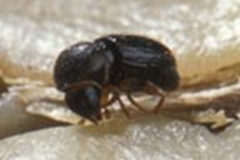 |
|
| 1990 | M19 Guerrilla leader Carlos Pizarro Leongómez Carlos Pizarro Leongómez Carlos Pizarro Leongómez was the fourth commander of the Colombian guerrilla group 19th of April Movement . Pizarro later ran for president of Colombia after the demobilization of M-19 that transformed the group into the political party, M-19 Democratic Alliance... is killed by hitmen when he was a presidential candidate |
||
| 1990 | March 22 | UP leader politician Bernardo Jaramillo Ossa Bernardo Jaramillo Ossa Bernardo Jaramillo Ossa was a Colombian politician member of the Colombian Communist Party... is killed by hitmen |
|
| 1990 | César Gaviria César Gaviria César Gaviria Trujillo is a Colombian politician and a Latin American statesman. He served as President of Colombia from 1990 to 1994, and Secretary General of the Organization of American States from 1994 until 2004.-Early life:... is elected President of Colombia |
 |
|
| 1990 | El Tiempo newspaper director Francisco Santos Francisco Santos XeskoFrancisco Santos's primary nom d'art or alter ego.Alan J. BantaThe heteronym Alan J. Banta is described as a civil engineer, born in the year of 1952 in Kakamas, a village located in the Northern Cape, South Africa but living and working in Angola. After independence, in 1975, remained in the... is kidnapped |
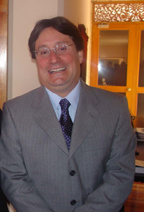 |
|
| 1990 | 20 Emberá Emberá Emberá is a comarca indígena in eastern Panama. It was created by Law Number 22 on November 8, 1983, within the territories of Chepigana and Pinogana districts, Darién Province. The capital is Union Choco. The 2010 census found 10,001 people within Emberá. The area of this comarca is 4,383.6 sq... indigenous people are killed in the Caloto, Cauca Caloto, Cauca Caloto is a town and municipality in the Cauca Department, Colombia.... massacre due to land ownership disagreements with local landlords |
 |
|
| 1991 | January | Journalist Diana Turbay Diana Turbay Diana Turbay Quintero was a Colombian journalist, killed during the rescue operation while kidnapped by the Medellín Cartel... is killed while kept kidnapped in a farm near Sabaneta Sabaneta Sabaneta could refer to either of the following:*Colombia**Sabaneta, Antioquia*Dominican Republic**Sabaneta, Dominican Republic*Venezuela**Sabaneta, Barinas- See also :* Savaneta, Aruba* Sabanetas * Sabanetas... |
|
| 1991 | January | Drug dealers Fabio, Juan David and Jorge Luis Ochoa Vázquez Jorge Luis Ochoa Vázquez Jorge Luis Ochoa Vásquez was a Colombian drug trafficker who helped found the notorious Medellín Cartel in the late 1970s. The cartel's key members were Pablo Escobar, Carlos Lehder, José Gonzalo Rodríguez Gacha, Jorge Ochoa and his brothers Juan David and Fabio.-Early years and the founding of the... (The Ochoa brothers) and Pablo Escobar Pablo Escobar Pablo Emilio Escobar Gaviria was a Colombian drug lord. He was an elusive cocaine trafficker and rich and successful criminal. He owned numerous luxury residences, automobiles, and even airplanes... surrender themselves to the authorities |
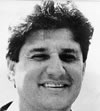 |
| 1991 | February 17 | Opening of the national assembly for reform to the 1886 national constitution (Constituent Assembly of Colombia Constituent Assembly of Colombia The Constituent Assembly of Colombia was formed on February 5, 1991, to draft Colombia's 1991 constitution. It was dissolved in June 1991, after the new document was adopted nationwide.-Background:... ) |
|
| 1991 | Rafael Pardo is the first civilian to be designated as minister of defense | ||
| 1991 | Minister of economy Rudolph Hommes announced the new aperture politic for international trade inspirited in the Russian perestroika Perestroika Perestroika was a political movement within the Communist Party of the Soviet Union during 1980s, widely associated with the Soviet leader Mikhail Gorbachev... and the creation of the National bank for international trade Bancomex |
||
| 1991 | Starts the first concessions for mobile telephony Mobile telephony Mobile telephony is the provision of telephone services to phones which may move around freely rather than stay fixed in one location. Mobile phones connect to a terrestrial cellular network of base stations , whereas satellite phones connect to orbiting satellites... |
 |
|
| 1992 | The Office of the Attorney General of Colombia is created, with Gustavo de Greiff Gustavo de Greiff Gustavo de Greiff Restrepo is a Colombian lawyer, educator and activist, who served as former Attorney General of Colombia and former Colombian Ambassador to Mexico. He is known for being an outspoken critic of the United States' War on Drugs in Colombia, and for being an advocate for drug... designated as the first Attorney General |
||
| 1992 | Noemí Sanín Noemí Sanín Marta Noemí del Espíritu Santo Sanín Posada is a Colombian lawyer and politician, twice Ambassador of Colombia to the United Kingdom, as well as Ambassador to Spain and Venezuela... is the new minister of foreign affairs. She is the first women to be designed as a minister in Colombia |
||
| 1992 | The collapse of the national electricity generation system causes massive power blackouts all over the country with an average of 18 hours/day without electricity from March 1992 to April 1993 | ||
| 1992 | July 20 | Pablo Escobar Pablo Escobar Pablo Emilio Escobar Gaviria was a Colombian drug lord. He was an elusive cocaine trafficker and rich and successful criminal. He owned numerous luxury residences, automobiles, and even airplanes... escapes from the Cathedral Prison |
|
| 1992 | Fernando Botero Fernando Botero Fernando Botero Angulo is a Colombian figurative artist. His works feature a figurative style, called by some "Boterismo", which gives them an unmistakable identity... presents a collection of 31 sculptures in an outdoors exhibition in the Champs-Élysées Champs-Élysées The Avenue des Champs-Élysées is a prestigious avenue in Paris, France. With its cinemas, cafés, luxury specialty shops and clipped horse-chestnut trees, the Avenue des Champs-Élysées is one of the most famous streets and one of the most expensive strip of real estate in the world. The name is... in Paris |
||
| 1992 | November 15 | Villatina Massacre Villatina Massacre The Villatina Massacre was a massacre of eight children and one young adult by the Colombian police that took place on November 15, 1992 in the city of Medellín. Colombian policemen had been killed by youth gangs before the massacre took place, and the Colombian police were attempting to exact... |
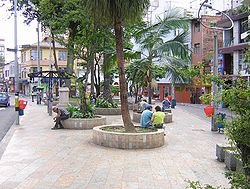 |
| 1993 | January 14 | Galeras Galeras Galeras is an Andean stratovolcano in the Colombian department of Nariño, near the departmental capital Pasto. Its summit rises above sea level. It has erupted frequently since the Spanish conquest, with its first historical eruption being recorded on December 7, 1580... volcano eruption killed nine people, including six scientists who had descended into the volcano's crater to sample gases. |
 |
| 1993 | Massive celebration of the winning of Colombian soccer team in a play against Argentine Argentina Argentina , officially the Argentine Republic , is the second largest country in South America by land area, after Brazil. It is constituted as a federation of 23 provinces and an autonomous city, Buenos Aires... team in Buenos Aires Buenos Aires Buenos Aires is the capital and largest city of Argentina, and the second-largest metropolitan area in South America, after São Paulo. It is located on the western shore of the estuary of the Río de la Plata, on the southeastern coast of the South American continent... with final score 5-0. Riots all over the country. |
 |
|
| 1993 | The national government achieves commercial treaties with Venezuela, Mexico and Ecuador Ecuador Ecuador , officially the Republic of Ecuador is a representative democratic republic in South America, bordered by Colombia on the north, Peru on the east and south, and by the Pacific Ocean to the west. It is one of only two countries in South America, along with Chile, that do not have a border... |
 |
|
| 1993 | November | Bomb explodes on 15th Avenue of Bogotá, near the intersection with 93rd Street (in front of Centro 93 mall). 10 people die, over 100 injured | 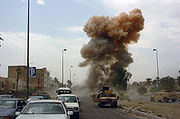 |
| 1993 | December 2 | Pablo Escobar dies in combats with the police | 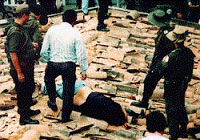 |
| 1994 | February 11 | CONVIVIR CONVIVIR CONVIVIR was a national program of cooperative neighbourhood watch groups created by a February 11, 1994 decree of Colombia's Ministry of National Defense and a law passed in the Colombian Congress, in response to growing guerrilla activity... (Spanish for to coexist) program of cooperative neighbourhood watch groups is created by a decree of Colombia's Ministry of Defense |
|
| 1994 | May 20 | Manuel Elkin Patarroyo Manuel Elkin Patarroyo Manuel Elkin Patarroyo is a Colombian pathologist who made the world's first attempt of synthetic vaccine for malaria, a disease transmitted by mosquitoes that affects millions of people in tropical and subtropical regions, including parts of the Americas, Asia, and Africa... received the Prince of Asturias Awards Prince of Asturias Awards The Prince of Asturias Awards are a series of annual prizes awarded in Spain by the Prince of Asturias Foundation to individuals, entities or organizations from around the world who make notable achievements in the sciences, humanities, and public affairs.... by his technical and scientific research in the development of syntetic malaria vaccine Malaria vaccine Malaria vaccines are an area of intensive research. However, there is no effective vaccine that has been introduced into clinical practice.The global burden of P. falciparum malaria increased through the 1990s due to drug-resistant parasites and insecticide-resistant mosquitoes; this is illustrated... |
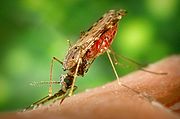 |
| 1994 | Ernesto Samper Ernesto Samper Ernesto Samper Pizano is a Colombian politician. He served as the President of Colombia from August 7, 1994 to August 7, 1998, representing the Liberal Party. He was involved in the 8000 process scandal, which takes its name from the folio number assigned to it by the chief prosecutor's office... is elected president of Colombia |
||
| 1994 | 8000 Process scandal of Cali Cartel Cali Cartel The Cali Cartel was a drug cartel based in southern Colombia, around the city of Cali and the Valle del Cauca Department. The Cali Cartel was founded by the Rodríguez Orejuela brothers, Gilberto and Miguel, as well as associate José Santacruz Londoño... narcotrafficking money investment in the Samper electoral campaign starts with the public broadcasting of tapes from telephonic conversations among Minister Alberto Giraldo and drug dealers Gilberto and Miguel Rodríguez Orejuela Miguel Rodríguez Orejuela Miguel Angel Rodríguez Orejuela is a Colombian druglord, formerly one of the leaders of the Cali Cartel, based in the city of Cali. He is the younger brother of Gilberto Rodríguez Orejuela... |
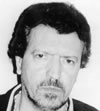 |
|
| 1994 | Former president César Gaviria is designated as OEA general secretary | ||
| 1994 | A team of 10 people steals 24.075.000.000 pesos from the Republic Bank in Valledupar Valledupar Valledupar is a city and municipality in northeastern Colombia. It is the capital of Cesar Department and was founded in 1550 by the Spanish conquistador Hernando de Santana. Its name, Valle de Upar , was established in honor of the Amerindian cacique who ruled the valley; Cacique Upar... in the biggest bank robbery Bank robbery Bank robbery is the crime of stealing from a bank during opening hours. According to the Federal Bureau of Investigation's Uniform Crime Reporting Program, robbery is "the taking or attempting to take anything of value from the care, custody, or control of a person or persons by force or threat of... in the Colombian history |
 |
|
| 1994 | July 2 | Due to the poor performance of the national soccer team in the USA soccer World Cup, an angry soccer aficionado shot to death soccer player Andrés Escobar Andrés Escobar Andrés Escobar Saldarriaga , nicknamed "The Gentleman of Football", was a Colombian footballer who was shot and killed in Medellín. It is widely believed that he was murdered due to his own goal in the 1994 FIFA World Cup, which supposedly would have caused gambling losses to several powerful drug... |
|
| 1994 | Paez river flood in Cauca Cauca Department Cauca is a Department of Colombia. Located in the south-western part of the country, facing the Pacific Ocean to the west, the Valle del Cauca Department to the north, Tolima Department to the northeast, Huila Department to the east and the Nariño Department to the south, covering a total area of... department kills hundreds of people and destroys villages in a length of 40 km |
 |
|
| 1995 | January | Plane crash in Marialabaja, Bolívar Department Bolívar Department Bolívar is a department of Colombia. It was named after one of the original nine states of the United States of Colombia. It is located to the north of the country, extending from the coast at Cartagena near the mouth of the Magdalena River, then south along the river to a border with Antioquia.Its... . 52 dead, only survivor 9years old girl Erika Delgado |
 |
| 1995 | February | Luciano Pavarotti Luciano Pavarotti right|thumb|Luciano Pavarotti performing at the opening of the Constantine Palace in [[Strelna]], 31 May 2003. The concert was part of the celebrations for the 300th anniversary of [[St... gives a concert in Bogotá |
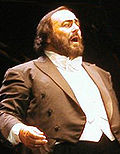 |
| 1995 | June 9 | Drug dealers Miguel and Gilberto Rodriguez Orejuela (The Rodriguez Brothers) are captured in a police operation | |
| 1995 | 76 years old conservative politician Álvaro Gómez Hurtado Álvaro Gómez Hurtado Álvaro Gómez Hurtado was a Colombian lawyer, politician, journalist and active member of the Colombian Conservative Party. Gómez was a son of the former President of Colombia, Laureano Gómez... is murdered by hitmen |
 |
|
| 1995 | November 30 | Start operations of rapid transit Rapid transit A rapid transit, underground, subway, elevated railway, metro or metropolitan railway system is an electric passenger railway in an urban area with a high capacity and frequency, and grade separation from other traffic. Rapid transit systems are typically located either in underground tunnels or on... rail system Metro de Medellín Metro de Medellín The Medellín Metro is an urban train that crosses the Metropolitan Area of Medellín from North to South and from Centre to West. As one of the first experiences of modern mass transportation in Colombia and the only metro system in the country, the Medellín Metro is a product of the urban planning... |
|
| 1995 | December | Plane crash near Cali airport. American Airlines American Airlines American Airlines, Inc. is the world's fourth-largest airline in passenger miles transported and operating revenues. American Airlines is a subsidiary of the AMR Corporation and is headquartered in Fort Worth, Texas adjacent to its largest hub at Dallas/Fort Worth International Airport... plane with 152 occupants. 9 survivors |
|
| 1996 | Antioquia governor Álvaro Uribe Álvaro Uribe Alvaro Uribe Vélez was the 58th President of Colombia, from 2002 to 2010. In August 2010 he was appointed Vice-chairman of the UN panel investigating the Gaza flotilla raid.... orders the capture of the German citizens Werner and Michela Mauss, suspected of being FARC collaborators |
||
| 1996 | March of protest of 90.000 cocaleros (coca leaf illegal farmers) from Guaviare Department Guaviare Department Guaviare is a department of Colombia. It is in the southern central region of the country. Its capital is San José del Guaviare. Guaviare was created on July 4, 1991 by the new Political Constitution of Colombia... and Putumayo Department Putumayo Department Putumayo is a department of Colombia. It is in the south-west of the country, bordering Ecuador and Peru. Its capital is Mocoa.The word putumayo comes from the Quechua language. The verb putuy means "to spring forth" or "to burst out", and mayo is a variant of mayu, meaning river... ended with 12 cocaleros dead. Army soldiers accused of brutality |
||
| 1996 | June 26 | La Gabarra Massacre La Gabarra Massacre La Gabarra Massacre was a massacre that occurred on June 16, 1996 near the Colombian village of La Gabarra, Municipality of Tibú, Norte de Santander near the border with Venezuela. It was perpetrated by members of the Revolutionary Armed Forces of Colombia against alleged members of the United... |
 |
| 1996 | July 24–27 | Hurricane Cesar Hurricane Cesar-Douglas Hurricane Cesar–Douglas was a devastating tropical cyclone that killed 122 people throughout Central and South America in late-July 1996. The Category 1 hurricane formed in late July in the Caribbean Sea and pounded Central America with rain, killing 67 people and causing local governments to deem... moves westward across the southern Caribbean and crosses over extreme northern Colombia and the San Andres archipelago. Cesar kills 11 people in Colombia due to flooding and mudslides. |
 |
| 1996 | Guerrilla attack to the military base "Las Delicias" in Putumayo. 29 soldiers dead, 20 injured, 60 kidnapped | 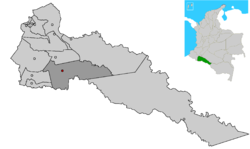 |
|
| 1996 | November | Aterciopelados Aterciopelados Aterciopelados , also referred to as los Aterciopelados on some albums and other promotional materials, are a rock band from Colombia. Led by Andrea Echeverri and Héctor Buitrago, they have been one of the first rock bands from Colombia to gain international notice and is among the country's top... band ranks number 1 in the MTV network, becoming the most successful Colombian rock band Rock Band Rock Band is a music video game developed by Harmonix Music Systems, published by MTV Games and Electronic Arts. It is the first title in the Rock Band series. The PlayStation 3 and Xbox 360 versions were released in the United States on November 20, 2007, while the PlayStation 2 version was... |
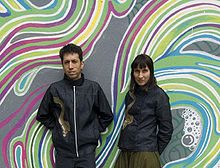 |
| 1997 | April 15 | Drug dealer Phanor Arizabaleta-Arzayus Phanor Arizabaleta-Arzayus Phanor Arizabaleta-Arzayus is Colombian drugtrafficker former member of the Cali Cartel fifth most important in the chain of command. Arizabaleta was in charge of kidnappings and extortions for the Cali Cartel and surrendered to Colombian authorities on July 8, 1995. He was sentenced by the... , member of the Cali Cartel Cali Cartel The Cali Cartel was a drug cartel based in southern Colombia, around the city of Cali and the Valle del Cauca Department. The Cali Cartel was founded by the Rodríguez Orejuela brothers, Gilberto and Miguel, as well as associate José Santacruz Londoño... is captured at a road checkpoint |
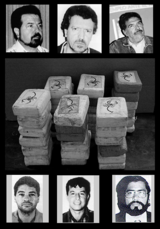 |
| 1997 | April | Salvatore Mancuso Salvatore Mancuso Salvatore Mancuso Gómez, also known as "el Mono Mancuso","Santander Lozada" or "Triple Cero", among other names is a Colombian paramilitary leader, once second in command of the United Self-Defense Forces of Colombia paramilitary group... and Carlos Castaño Carlos Castaño Carlos Castaño Gil was the founder of the Peasant Self-Defense Forces of Córdoba and Urabá , an extreme right paramilitary organization in Colombia... conformed what they called the "Autodefensas Unidas de Colombia" (AUC) United Self-Defense Forces of Colombia United Self-Defense Forces of Colombia The United Self-Defense Forces of Colombia was created as an umbrella organization of regional far-right... |
 |
| 1997 | "Miti-Miti" corruption scandal, involving Ministrer of communications Saulo Arboleda and minister of mining and energy Rodrigo Villamizar accused of obtaining illegal profit of 100 fm radio concessions | ||
| 1997 | July 15 | Mapiripán Massacre Mapiripán Massacre The Mapiripán Massacre was a massacre of civilians that took place in Mapiripán, Meta Department, Colombia. The massacre was carried out from July 15 to July 20, 1997, by the United Self-Defense Forces of Colombia , an outlawed right-wing paramilitary group backed by elements of the government.On... |
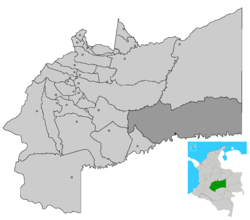 |
| 1997 | September | Carlos Castaño Carlos Castaño Carlos Castaño Gil was the founder of the Peasant Self-Defense Forces of Córdoba and Urabá , an extreme right paramilitary organization in Colombia... in a press interview admits responsibility for the Mapiripán Massacre Mapiripán Massacre The Mapiripán Massacre was a massacre of civilians that took place in Mapiripán, Meta Department, Colombia. The massacre was carried out from July 15 to July 20, 1997, by the United Self-Defense Forces of Colombia , an outlawed right-wing paramilitary group backed by elements of the government.On... . AUC is listed by the US Department of State as a Foreign Terrorist Organization. |
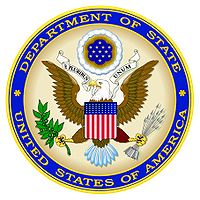 |
| 1997 | October | Bird (sculpture by Fernando Botero Fernando Botero Fernando Botero Angulo is a Colombian figurative artist. His works feature a figurative style, called by some "Boterismo", which gives them an unmistakable identity... ) was destroyed by a terrorist attack in downtown Medellín Medellín Medellín , officially the Municipio de Medellín or Municipality of Medellín, is the second largest city in Colombia. It is in the Aburrá Valley, one of the more northerly of the Andes in South America. It has a population of 2.3 million... . About 17 people died. Several body parts remained unidentified. The remains of the sculpture are displayed in San Antonio Square as a memorial for the victims |
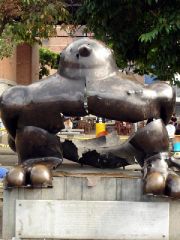 |
| 1998 | Andrés Pastrana is elected as president of Colombia | 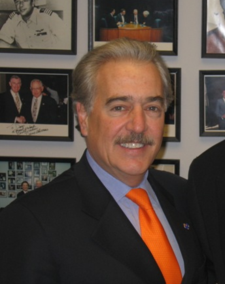 |
|
| 1998 | June 20 | Plan Colombia Plan Colombia The term Plan Colombia is most often used to refer to U.S. legislation aimed at curbing drug smuggling and combating a left-wing insurgency by supporting different activities in Colombia.... (Treaty signed with USA for support in War on Drugs War on Drugs The War on Drugs is a campaign of prohibition and foreign military aid and military intervention being undertaken by the United States government, with the assistance of participating countries, intended to both define and reduce the illegal drug trade... ) is officially unveiled by President Pastrana |
 |
| 1998 | Gloria Zea, director of the national Modern Art Museum organizes one of the largest art exhibits in Colombia "Arte y Violencia en Colombia" as a commemoration of 50th anniversary of the start of the bipartisan violence La Violencia La Violencia La Violencia is a period of civil conflict in the Colombian countryside between supporters of the Colombian Liberal Party and the Colombian Conservative Party, a conflict which took place roughly from 1948 to 1958 .... |
||
| 1998 | Fernando Botero donates 100 of his works and 60 pieces of his private art collection (19th and 20th centuries) to the Antioquia Museum |  |
|
| 1998 | November 7 | President Pastrana granted to the FARC guerrilla a 42,000 km2 (16,200 sq mi) safe haven meant to serve as a confidence building measure, centered around the San Vicente del Caguán San Vicente del Caguán San Vicente del Caguán is a town and municipality in Caquetá Department, Colombia.Between 1998 and 2002, San Vicente del Caguán was the center of the demilitarized zone , which was created as a safe haven for the FARC. Two days after the peace talks were ended, Ingrid Betancourt was kidnapped while... settlement |
|
| 1999 | January 19 | The 1999 Armenia earthquake devastates Armenia, Colombia Armenia, Colombia Armenia is the capital of Quindío, a department in Colombia. The city is located at coordinates 4.5170° north, 75.6830° west, 290 kilometers west of Bogotá. Armenia is a mid-size city located between Bogotá, Medellín and Cali, the 3 largest Colombian cities. The city's area code for phone calls is... . Over 2000 dead, 3000 missing persons and a quarter million people homeless |
|
| 1999 | April 14 | ELN National Liberation Army (Colombia) National Liberation Army is a revolutionary, avowed Marxist guerrilla group that has been operating in several regions of Colombia since 1964.... guerrilla kidnap Fokker airplane with 41 occupants in Bolívar department Bolívar Department Bolívar is a department of Colombia. It was named after one of the original nine states of the United States of Colombia. It is located to the north of the country, extending from the coast at Cartagena near the mouth of the Magdalena River, then south along the river to a border with Antioquia.Its... |
 |
| 1999 | April 22 | Serial killer Serial killer A serial killer, as typically defined, is an individual who has murdered three or more people over a period of more than a month, with down time between the murders, and whose motivation for killing is usually based on psychological gratification... Luis Garavito Luis Garavito Luis Alfredo Garavito Cubillos, aka "La Bestia" or "Tribilín" is a Colombian rapist and serial killer. In 1999, he admitted to the rape and murder of 140 young boys... is found guilty of the murder of 138 boys. (The total number of victims according with Garavito confessions off-record is estimated up to 300 boys and an undetermined number of adults) |
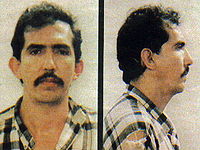 |
| 1999 | May 30 | Mass kidnapping of 70 people in La Maria church in Cali Calì Calì, also written in English as Cali, is an Italian surname, widespread mainly in the Ionian side of Sicily.For the surname Calì is assumed the origin of the Greek word kalos , or from its Sanskrit root kali, "time."The surname refers to:... |
|
| 1999 | August 13 | Comedian Jaime Garzón Jaime Garzón Jaime Hernando Garzón Forero was a Colombian journalist, a comedian, lawyer, peace activist and political satirist. He was very popular on Colombian television during the 1990s, especially for his political satire. In addition to his work on television, he also had roles as a peace negotiator in... is murdered by hitmen |
|
| 1999 | November 13–16 | Strong waves from Hurricane Lenny Hurricane Lenny Hurricane Lenny was the strongest November Atlantic hurricane on record. It was the twelfth tropical storm, eighth hurricane, and record-breaking fifth Category 4 hurricane in the 1999 Atlantic hurricane season. Lenny formed on November 13 in the western Caribbean Sea, and maintained an... affect the Guajira Peninsula Guajira Peninsula Guajira Peninsula , is a peninsula in northern Colombia and northwestern Venezuela in the Caribbean Sea... of Colombia, flooding 1,200 homes and businesses along the northern coastline. In addition, winds and rains from the hurricane causes severe crop damage in the country. The hurricane kills two in Colombia. |
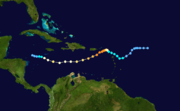 |
| 1999 | November 29 | Date of death of Colombian essayist and historian Historian A historian is a person who studies and writes about the past and is regarded as an authority on it. Historians are concerned with the continuous, methodical narrative and research of past events as relating to the human race; as well as the study of all history in time. If the individual is... Germán Arciniegas Germán Arciniegas Germán Arciniegas was a Colombian essayist and historian. Arciniegas wrote over 50 books and many columns in the Colombian newspaper El Tiempo and also taught at Columbia University in New York.- Books :... |
|
| 1999 | Betty la fea Betty la fea Yo soy Betty, la fea is a popular soap opera filmed in Colombia, written by Fernando Gaitán and produced between 1999 through 2001 by the Colombian network RCN . More than a dozen versions of the telenovela have been made in other countries... soap opera Soap opera A soap opera, sometimes called "soap" for short, is an ongoing, episodic work of dramatic fiction presented in serial format on radio or as television programming. The name soap opera stems from the original dramatic serials broadcast on radio that had soap manufacturers, such as Procter & Gamble,... a.k.a Ugly Betty Ugly Betty Ugly Betty is an American comedy-drama television series developed by Silvio Horta, which premiered on ABC on September 28, 2006, and ended on April 14, 2010. The series revolves around the character Betty Suarez and is based on Fernando Gaitán's Colombian telenovela soap opera Yo soy Betty, la fea... reach the highest levels of rating and the script is sold to different producers in several countries |
21st century
| Year | Date | Event | Image |
|---|---|---|---|
| 2000 | March 30 | A car bomb parked in front of the mayor's office in Cachipay (Cundinamarca Department) detonated, causing injuries to nineteen and deaths to four | 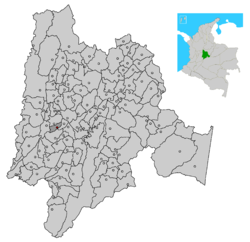 |
| 2000 | June | The sport of Precolumbian origin; Turmequé Tejo (sport) -Mechanics:Tejo is a traditional sport in Colombia. The sport originated by the Chibcha people from pre-hispanic central-western Colombia. It is played by throwing a metal plate or disc, named tejo, weighing about 680 g at a target so as to make it strike the "mechas" located in cardinal points... or tejo is declared as the National sport by the Colombian congress |
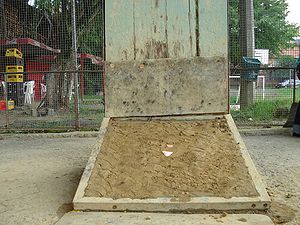 |
| 2000 | First Olympic gold medal in Colombian history, earned by María Isabel Urrutia in weightlifting | ||
| 2000 | April 11 | ELN bombs damage 4 meetinghouses of The Church of Jesus Christ of Latter-day Saints (LDS Church); bridge attack kills 1, injures 20. | |
| 2000 | May 15 | A woman was killed by a time bomb fastened to her neck by FARC guerrilla; 1 bomb disposal Bomb disposal Bomb disposal is the process by which hazardous explosive devices are rendered safe. Bomb disposal is an all encompassing term to describe the separate, but interrelated functions in the following fields:*Military:... specialist died trying to deactivate the bomb and other 3 were wounded. The 2007 movie PVC-1 PVC-1 PVC-1 is a 2007 Colombian drama film directed by Spiros Stathoulopoulos. The plot was inspired by a true story about a pipe bomb improvised explosive device that was placed around the neck of an extortion victim. This directorial debut premiered at the Cannes International Film Festival in 2007... is based in this incident |
|
| 2000 | September 4 | A 70 kilograms of R1 explosive bomb exploded in Barrancabermeja Barrancabermeja Barrancabermeja is a city and municipality in Santander Department, in northeastern Colombia. It is located on the banks of the Magdalena River in the Middle Magdalena region, 110 km west of Bucaramanga. Founded in 1536, Barrancabermeja is home of the biggest petroleum refinery in Colombia,... 's commercial district, injuring four policemen, two security guards and two civilians. The bomb was made of. The intended target was apparently the National Customs and Tax Directorate (DIAN). |
 |
| 2000 | August 30 | USA president Bill Clinton Bill Clinton William Jefferson "Bill" Clinton is an American politician who served as the 42nd President of the United States from 1993 to 2001. Inaugurated at age 46, he was the third-youngest president. He took office at the end of the Cold War, and was the first president of the baby boomer generation... and his daughter Chelsea visit Cartagena de Indias |
 |
| 2000 | October 15 | A bomb went off in Cali Calì Calì, also written in English as Cali, is an Italian surname, widespread mainly in the Ionian side of Sicily.For the surname Calì is assumed the origin of the Greek word kalos , or from its Sanskrit root kali, "time."The surname refers to:... outside a rehabilitation center in the Obrero neighborhood. Two children were killed and thirty other injured. An explosive device went off in a Christian church in Cali, killing two and injuring fifteen. |
|
| 2000 | October | Macayepo massacre Macayepo massacre The Macayepo massacre occurred in October, 2000 resulting in the slaughter of fifteen peasants from Macayepo in the southern region of Bolívar Department, northern Colombia... in Montes de María Montes de María The Montes de María are a group of mountains of the northern coast of Colombia , which do not belong to the Andes ranges, and the highlands around them. The Montes de María are the last part of the Serranía de San Jerónimo.Montes de María is a zone located in the center of the Colombian... |
 |
| 2000 | November 14 th | A guerrilla group gave a homeless man a package that, unbeknownst to him, was filled with explosives. The package exploded as he walked through the banking sector of Cali Calì Calì, also written in English as Cali, is an Italian surname, widespread mainly in the Ionian side of Sicily.For the surname Calì is assumed the origin of the Greek word kalos , or from its Sanskrit root kali, "time."The surname refers to:... , killing him and wounding four others. The package reportedly contained 500 grams of ammonium nitrate fuel oil. |
|
| 2000 | December 4 | Politician Fernando Araújo Perdomo Fernando Araújo Perdomo Fernando Araújo Perdomo is a Colombian politician. He was the Minister of Development during the administration of Andrés Pastrana. He resigned from this post after the Chambacú land deal scandal. He was later kidnapped by the FARC-EP guerrillas and held for six years until he eventually escaped... is kidnapped by the Farc guerrilla |
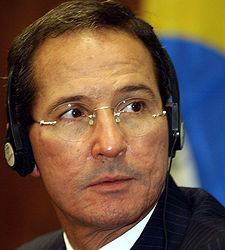 |
| 2000 | December 18 | Opening of the mass transportation system Transmilenio TransMilenio TransMilenio is a bus rapid transit system that serves Bogotá, the capital of Colombia. The system opened to the public in December 2000, covering Av. Caracas and Calle 80... in Bogotá |
|
| 2001 | April 24 | the House of Representatives Committee on International Relations published the findings of its investigation into IRA Irish Republican Army The Irish Republican Army was an Irish republican revolutionary military organisation. It was descended from the Irish Volunteers, an organisation established on 25 November 1913 that staged the Easter Rising in April 1916... activities in Colombia |
|
| 2001 | May 4 | A car bomb kills four and injures 32 in a luxury hotel in Cali Calì Calì, also written in English as Cali, is an Italian surname, widespread mainly in the Ionian side of Sicily.For the surname Calì is assumed the origin of the Greek word kalos , or from its Sanskrit root kali, "time."The surname refers to:... . No group claims the attack. |
|
| 2001 | May 17 | A car bomb kills 20 and injures at least 50 in a park in Medellín Medellín Medellín , officially the Municipio de Medellín or Municipality of Medellín, is the second largest city in Colombia. It is in the Aburrá Valley, one of the more northerly of the Andes in South America. It has a population of 2.3 million... . |
|
| 2001 | July 11 to 29 | Soccer tournament Copa America 2001 Copa América 2001 The Copa América 2001 was held in Colombia, from July 11 to July 29, 2001. It was organised by CONMEBOL, South America's football governing body.... was held in Colombia |
|
| 2001 | August 11 | Arrest of the Irish Ireland Ireland is an island to the northwest of continental Europe. It is the third-largest island in Europe and the twentieth-largest island on Earth... Colombia Three Colombia Three The Colombia Three are three individuals – Niall Connolly, James Monaghan and Martin McCauley – who are currently living in the Republic of Ireland, having fled from Colombia, where they were sentenced to prison terms of seventeen years for training FARC rebels.-Arrest:The three came to... charged with training FARC rebels in bomb Bomb A bomb is any of a range of explosive weapons that only rely on the exothermic reaction of an explosive material to provide an extremely sudden and violent release of energy... -making |
|
| 2001 | August 23 | In a series of attacks near Medellín Medellín Medellín , officially the Municipio de Medellín or Municipality of Medellín, is the second largest city in Colombia. It is in the Aburrá Valley, one of the more northerly of the Andes in South America. It has a population of 2.3 million... , 10 bombs kill one and injure 39 others. At least 15 members of terrorist group ELN National Liberation Army (Colombia) National Liberation Army is a revolutionary, avowed Marxist guerrilla group that has been operating in several regions of Colombia since 1964.... die when the explosives they were carrying detonate. |
|
| 2001 | September 29 | Politician Consuelo Araújo is murdered while being kidnapped by FARC guerrilla | |
| 2001 | The stock market Stock market A stock market or equity market is a public entity for the trading of company stock and derivatives at an agreed price; these are securities listed on a stock exchange as well as those only traded privately.The size of the world stock market was estimated at about $36.6 trillion... s of Cali, Medellín and Bogotá are fused into a single entity: Bolsa de Valores de Colombia Bolsa de Valores de Colombia The Bolsa de Valores de Colombia, also known as BVC, is the principal stock exchange of Colombia. It was created on July 3, 2001 by the union of three extant stock exchanges in Colombia: Bogotá Stock Exchange , Medellín Stock Exchange and Cali's Western Stock Exchange .The company maintains... |
||
| 2001 | Singer Shakira Mebarak wins a Grammy Award Grammy Award A Grammy Award — or Grammy — is an accolade by the National Academy of Recording Arts and Sciences of the United States to recognize outstanding achievement in the music industry... for her MTV MTV MTV, formerly an initialism of Music Television, is an American network based in New York City that launched on August 1, 1981. The original purpose of the channel was to play music videos guided by on-air hosts known as VJs.... unplugged |
||
| 2002 | January 25 | A bomb kills a child and four police officers and injures 28 people in Bogotá Bogotá Bogotá, Distrito Capital , from 1991 to 2000 called Santa Fé de Bogotá, is the capital, and largest city, of Colombia. It is also designated by the national constitution as the capital of the department of Cundinamarca, even though the city of Bogotá now comprises an independent Capital district... . Rebel group FARC is blamed |
|
| 2002 | January 30 | A car bomb Car bomb A car bomb, or truck bomb also known as a Vehicle Borne Improvised Explosive Device , is an improvised explosive device placed in a car or other vehicle and then detonated. It is commonly used as a weapon of assassination, terrorism, or guerrilla warfare, to kill the occupants of the vehicle,... kills five and injures 40 in the city of Florencia Florencia -Places:*Florencia de Benito Juárez, a municipality in the state of Zacatecas, Mexico*Florencia, Caquetá, a town and municipality in the Department of Caqueta, Colombia*Florencia, Cauca, a town and municipality in the Department of Cauca, Colombia... in the department of Caquetá Caquetá Caquetá may refer to:* Caquetá River, a river in Colombia* Caquetá Territory, a former territory of Colombia* Caquetá Department, a department of Colombia... |
|
| 2002 | February 21 | President Pastrana ended the peace talks and ordered the armed forces to start retaking the FARC-EP controlled zone of San Vicente del Caguan | |
| 2002 | February 24 | Oxygen Green Party Oxygen Green Party The Oxygen Green Party was a political party in Colombia founded in 1998. After Íngrid Betancourt, one of its most prominent members, was kidnapped in 2002, the party's popular support began to fade. In 2005 a political reform on the Colombian party system left the party without participation, due... Politician Ingrid Betancourt Íngrid Betancourt Ingrid Betancourt Pulecio is a Colombian politician, former senator and anti-corruption activist.Betancourt was kidnapped by the Revolutionary Armed Forces of Colombia on 23 February 2002 and was rescued by Colombian security forces six and a half years later on 2 July 2008... is kiddnapped by FARC guerrilla |
|
| 2002 | March | President Uribe decided to appoint Marta Lucía Ramírez as Minister of Defense Ministry of National Defense (Colombia) The Ministry of National Defence , is the national executive ministry of the Government of Colombia charged with coordinating and supervising all agencies and functions of the government relating directly to national security and the armed forces of Colombia, similar to the defense ministries in... becoming the second woman in Latin America to ever hold this title, after Michelle Bachelet Michelle Bachelet Verónica Michelle Bachelet Jeria is a Social Democrat politician who was President of Chile from 11 March 2006 to 11 March 2010. She was the first woman president of her country... |
 |
| 2002 | April 7 | Two bombs explode in the restaurant district of Villavicencio Villavicencio Villavicencio is a city and municipality in Colombia, capital of the Department of Meta, with 361,058 inhabitants. The city is located at 4°08S, 73°40W, 75 km southeast of the Colombian capital city of Bogotá by the Guatiquía river... , killing twelve and injuring 70. FARC is the prime suspect for the attack. |
|
| 2002 | April 11 | Two police officers and a girl are killed by a bomb concealed in the corpse of a peasant (Pedro Nel Camacho) apparently executed by the FARC guerrilla with such purpose | |
| 2002 | April 12 | 12 politicians in Valle del Cauca are kidnapped using a hoax antibomb operative, starting the Valle del Cauca Deputies hostage crisis Valle del Cauca Deputies hostage crisis The Valle del Cauca Deputies hostage crisis refers to the kidnapping of 12 Deputies of the Valle del Cauca Department, Colombia, on April 12, 2002 by members of the Revolutionary Armed Forces of Colombia to pressure a prisoner exhange between them and the government and to negotiate the... |
|
| 2002 | April 12 | A rocket Rocket A rocket is a missile, spacecraft, aircraft or other vehicle which obtains thrust from a rocket engine. In all rockets, the exhaust is formed entirely from propellants carried within the rocket before use. Rocket engines work by action and reaction... explodes near the studios of RCN TV RCN TV RCN Televisión , is a Colombian private television network. It started as a production company in 1967... in Bogotá Bogotá Bogotá, Distrito Capital , from 1991 to 2000 called Santa Fé de Bogotá, is the capital, and largest city, of Colombia. It is also designated by the national constitution as the capital of the department of Cundinamarca, even though the city of Bogotá now comprises an independent Capital district... . |
|
| 2002 | April 14 | During an assassination attempt of then-presidential candidate Álvaro Uribe Vélez a bomb kills two and injures 20 in Barranquilla Barranquilla Barranquilla is an industrial port city and municipality located in northern Colombia, near the Caribbean Sea. The capital of the Atlántico Department, it is the largest industrial city and port in the Colombian Caribbean region with a population of 1,148,506 as of 2005, which makes it Colombia's... . Rebel group FARC is blamed. |
|
| 2002 | May 26 | Cali bishop Isaias Duarte is murdered by hitmen | |
| 2002 | May 2 | Bojaya massacre Bojayá massacre The Bojayá massacre was a massacre that occurred on May 2, 2002 in the Colombian town of Bojayá , in Chocó department... in Chocó Department Chocó Department Chocó is a department of Colombia known for its large Afro-Colombian population. It is in the west of the country, and is the only Colombian department to have coastlines on both the Pacific Ocean and the Atlantic Ocean. It also has all of Colombia's border with Panama. Its capital is... . A bomb destroys the local church. 117 dead, 114 injured. |
 |
| 2002 | August 7 | Álvaro Uribe Álvaro Uribe Alvaro Uribe Vélez was the 58th President of Colombia, from 2002 to 2010. In August 2010 he was appointed Vice-chairman of the UN panel investigating the Gaza flotilla raid.... is elected president of Colombia |
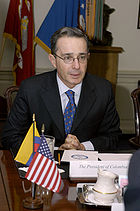 |
| 2002 | August 7 | Four rounds of mortars are fired against the Presidential Palace in Bogotá Bogotá Bogotá, Distrito Capital , from 1991 to 2000 called Santa Fé de Bogotá, is the capital, and largest city, of Colombia. It is also designated by the national constitution as the capital of the department of Cundinamarca, even though the city of Bogotá now comprises an independent Capital district... during the inauguration ceremony of President Álvaro Uribe Vélez. 13 people, mostly homeless, die and 50 are wounded. FARC is blamed. |
|
| 2002 | November 24 | Guerrilla leader alias Simon Trinidad Simón Trinidad Simón Trinidad is the alias of Juvenal Ovidio Ricardo Palmera Pineda, a high-ranking member of the Revolutionary Armed Forces of Colombia , and reputedly the first high-ranking member of that guerrilla group to be captured... is extradited to USA |
|
| 2002 | December 13 | A bomb destroys 30th floor of the Intercontinental Hotel in downtown Bogotá Bogotá Bogotá, Distrito Capital , from 1991 to 2000 called Santa Fé de Bogotá, is the capital, and largest city, of Colombia. It is also designated by the national constitution as the capital of the department of Cundinamarca, even though the city of Bogotá now comprises an independent Capital district... . 37 people injured. |
|
| 2003 | January 16 | A car bomb kills four and injures 27 at a shopping mall in Medellín Medellín Medellín , officially the Municipio de Medellín or Municipality of Medellín, is the second largest city in Colombia. It is in the Aburrá Valley, one of the more northerly of the Andes in South America. It has a population of 2.3 million... . The attack is believed to be a retaliation of FARC for the arrest of 53 of its members in the preceding days |
|
| 2003 | February 7 | 2003 El Nogal Club bombing 2003 El Nogal Club bombing The 2003 El Nogal Club bombing was a terrorist attack that occurred in Bogotá, Colombia. On February 7, 2003, a car containing 200 kg of explosives that was parked in a garage on the third floor of the multi-story El Nogal club exploded, killing 36 people and wounding more than 200. There were... . Car bomb kills 36 and injures more than 200 at the El Nogal social club in Bogotá Bogotá Bogotá, Distrito Capital , from 1991 to 2000 called Santa Fé de Bogotá, is the capital, and largest city, of Colombia. It is also designated by the national constitution as the capital of the department of Cundinamarca, even though the city of Bogotá now comprises an independent Capital district... ; FARC Revolutionary Armed Forces of Colombia The Revolutionary Armed Forces of Colombia – People's Army is a Marxist–Leninist revolutionary guerrilla organization based in Colombia which is involved in the ongoing Colombian armed conflict, currently involved in drug dealing and crimes against the civilians..FARC-EP is a peasant army which... rebels are blamed |
|
| 2003 | February 14 | A bomb kills 18 and wounds 37 in Neiva, destroying 70 homes. Amongst the dead are the chief prosecutor in Neiva and the chief of police. FARC is blamed for the attack. | |
| 2003 | March 5 | A car bomb kills six and injures 68 in a covered parking lot in Cúcuta Cúcuta Cúcuta is a Colombian city, capital of Norte de Santander, in the northeast of the country. Due to its proximity to the Colombian-Venezuelan border, Cúcuta is an important commercial center. The city has the constitutional category of Special District. It is located at the most active... . Rebel group ELN National Liberation Army (Colombia) National Liberation Army is a revolutionary, avowed Marxist guerrilla group that has been operating in several regions of Colombia since 1964.... is blamed for the attack. |
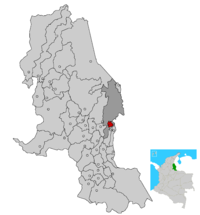 |
| 2003 | May | A group of Colombian Army Colombian Army The National Army of Colombia is the land military force of the government of Colombia and the largest service of the Colombian Armed Forces... soldiers, part of a Counter-terrorism Counter-terrorism Counter-terrorism is the practices, tactics, techniques, and strategies that governments, militaries, police departments and corporations adopt to prevent or in response to terrorist threats and/or acts, both real and imputed.The tactic of terrorism is available to insurgents and governments... unit, while cleaning up after an ambush by guerillas makes the surprising discovery of several tubs buried in the jungle which hold $16.75 million US dollars in cash. They decide to keep the money for themselves, leading to their capture and trial. These events are depicted in the 2006 movie A Ton of Luck A Ton of Luck Soñar no Cuesta Nada is a 2006 Colombian black comedy film directed by Rodrigo Triana. Based on a true story, the plot follows a group of anti-guerrilla soldiers, whose lives are turned upside down after finding $45 million hidden in the jungle.-Plot:... |
|
| 2003 | May 8 | A bomb kills three in an attack against a water treatment plant in Cali Calì Calì, also written in English as Cali, is an Italian surname, widespread mainly in the Ionian side of Sicily.For the surname Calì is assumed the origin of the Greek word kalos , or from its Sanskrit root kali, "time."The surname refers to:... . |
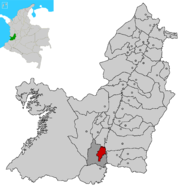 |
| 2003 | August 24 | Six die and 28 are wounded when a bomb explodes in a riverboat in the town of Puerto Rico. Rebel group FARC is blamed. | |
| 2003 | September 11 | A bomb strapped to a horse Horse The horse is one of two extant subspecies of Equus ferus, or the wild horse. It is a single-hooved mammal belonging to the taxonomic family Equidae. The horse has evolved over the past 45 to 55 million years from a small multi-toed creature into the large, single-toed animal of today... kills eight and injures 15 in the village of Chita, Boyacá Chita, Boyacá Chita is a town and municipality in the Colombian Department of Boyacá, part of the Valderrama Province a subregion of Boyaca.... . The attack is blamed on FARC, as the same technique had been used in the past. |
 |
| 2003 | September 29 | A motorcycle packed with explosives kills ten and injures 54 in downtown Florencia, Caquetá Florencia, Caquetá Florencia is a municipality and capital city of the Department of Caquetá, Colombia. It is the most important city in southeast Colombia because of its population as well as its more than a hundred years of history.... . Rebel group FARC is blamed. |
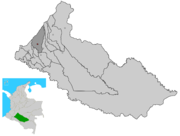 |
| 2003 | October 8 | A car bomb kills six and injures eleven in downtown Bogotá Bogotá Bogotá, Distrito Capital , from 1991 to 2000 called Santa Fé de Bogotá, is the capital, and largest city, of Colombia. It is also designated by the national constitution as the capital of the department of Cundinamarca, even though the city of Bogotá now comprises an independent Capital district... . |
|
| 2003 | November 15 | A grenade attack from a motorcycle kills two and injures seventy in the Bogotá Beer Company, a popular pub in Bogotá Bogotá Bogotá, Distrito Capital , from 1991 to 2000 called Santa Fé de Bogotá, is the capital, and largest city, of Colombia. It is also designated by the national constitution as the capital of the department of Cundinamarca, even though the city of Bogotá now comprises an independent Capital district... . Two FARC members were captured. |
 |
| 2003 | December | Biologist Biologist A biologist is a scientist devoted to and producing results in biology through the study of life. Typically biologists study organisms and their relationship to their environment. Biologists involved in basic research attempt to discover underlying mechanisms that govern how organisms work... Raul Cuero Raul Cuero Raul G Cuero is a professor of microbiology and an inventor, with particular expertise in biogenesis.Dr. Cuero led a team from around the world in synthetic biology in the 2006 IGEM competition, at the Massachusetts Institute of Technology in the USA.-Education:* Biology, University of Valle*... wins NASA NASA The National Aeronautics and Space Administration is the agency of the United States government that is responsible for the nation's civilian space program and for aeronautics and aerospace research... Technology Award for his research in removal of radionuclide Radionuclide A radionuclide is an atom with an unstable nucleus, which is a nucleus characterized by excess energy available to be imparted either to a newly created radiation particle within the nucleus or to an atomic electron. The radionuclide, in this process, undergoes radioactive decay, and emits gamma... s such as uranium Uranium Uranium is a silvery-white metallic chemical element in the actinide series of the periodic table, with atomic number 92. It is assigned the chemical symbol U. A uranium atom has 92 protons and 92 electrons, of which 6 are valence electrons... , using Martian Martian As an adjective, the term martian is used to describe anything pertaining to the planet Mars.However, a Martian is more usually a hypothetical or fictional native inhabitant of the planet Mars. Historically, life on Mars has often been hypothesized, although there is currently no solid evidence of... simulated soil |
|
| 2004 | March 15 | Date of death of popular salsa dancer Salsa (dance) Salsa is a syncretic dance form with origins in Cuba as the meeting point of Spanish and African cultures.Salsa is normally a partner dance, although there are recognized solo forms such as solo dancing "suelta" and "Rueda de Casino" where multiple couples exchange partners in a circle... Amparo Arrebato Amparo Arrebato Amparo Ramos Correa was a popular Colombian dancer famous as a celebrity in the annual Cali Fair and as a dancer for several popular Latin musicians... |
|
| 2004 | May 1 | Ecuador Ecuador Ecuador , officially the Republic of Ecuador is a representative democratic republic in South America, bordered by Colombia on the north, Peru on the east and south, and by the Pacific Ocean to the west. It is one of only two countries in South America, along with Chile, that do not have a border... ian government placed further stringent visa Visa (document) A visa is a document showing that a person is authorized to enter the territory for which it was issued, subject to permission of an immigration official at the time of actual entry. The authorization may be a document, but more commonly it is a stamp endorsed in the applicant's passport... restrictions on Colombians seeking to enter Ecuador |
|
| 2004 | May 22 | A bomb exploded in a crowded tavern/discothèque at 11:00 pm Saturday night killing six (some reports indicate seven) and wounding eighty-two. The bomb was packed in a small suitcase and left in the bathroom by suspected Revolutionary Armed Forces of Colombia (FARC) rebels. It is believed the bombing was part of a FARC campaign marking the organizations 40th anniversary. | |
| 2004 | August 4 | A bomb exploded at a bridge in Medellín Medellín Medellín , officially the Municipio de Medellín or Municipality of Medellín, is the second largest city in Colombia. It is in the Aburrá Valley, one of the more northerly of the Andes in South America. It has a population of 2.3 million... moments before a parade of antique cars was scheduled to cross it, as the closing event at the annual Festival of the Flowers Festival of the Flowers Festival of the Flowers is a festival that takes place in Medellín, Colombia. The festival is the most important social event for the city and there is a pageant, automobiles, a Paso Fino horse parade and many musical concerts.-History:... . 35 people injured. |
.jpg) |
| 2004 | October 29 | A bomb exploded near a bus stop along Bogotá's Transmilenio TransMilenio TransMilenio is a bus rapid transit system that serves Bogotá, the capital of Colombia. The system opened to the public in December 2000, covering Av. Caracas and Calle 80... bus system route. A taxi passing by was caught in the blast resulting in the death of the driver and a passenger. 30 surrounded houses destroyed |
|
| 2004 | November 22 | USA president George W. Bush George W. Bush George Walker Bush is an American politician who served as the 43rd President of the United States, from 2001 to 2009. Before that, he was the 46th Governor of Texas, having served from 1995 to 2000.... visits Cartagena de Indias |
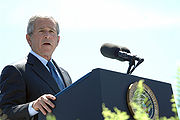 |
| 2004 | November 28 | A bomb exploded beside the mayor's office in the Rafael Uribe district of Bogotá | |
| 2004 | November 30 | Three people were killed and eight wounded when a fragment grenade was left at a supermarket checkout counter | |
| 2004 | December 13 | Rodrigo Granda affair Rodrigo Granda affair The Rodrigo Granda affair was an international incident that increased tension between Venezuela and Colombia between December 2004 and February 2005.- Events :... . FARC guerrilla leader Rodrigo Granda Rodrigo Granda Ricardo González also known as Rodrigo Granda is a Colombian Venezuelan member of Revolutionary Armed Forces of Colombia . He serves as international spokesman of the guerrilla organization.-Arrest in Venezuela:... , was captured by individual Venezuelan officials in Caracas Caracas Caracas , officially Santiago de León de Caracas, is the capital and largest city of Venezuela; natives or residents are known as Caraquenians in English . It is located in the northern part of the country, following the contours of the narrow Caracas Valley on the Venezuelan coastal mountain range... , Venezuela, and transferred to Cúcuta Cúcuta Cúcuta is a Colombian city, capital of Norte de Santander, in the northeast of the country. Due to its proximity to the Colombian-Venezuelan border, Cúcuta is an important commercial center. The city has the constitutional category of Special District. It is located at the most active... , Colombia (a departmental capital on the two nations' common border), where he was arrested by the Colombian authorities on December 14, generating a diplomatic crisis with Venezuela Venezuela Venezuela , officially called the Bolivarian Republic of Venezuela , is a tropical country on the northern coast of South America. It borders Colombia to the west, Guyana to the east, and Brazil to the south... n government. |
|
| 2004 | December 30 | Radio Televisión Nacional de Colombia Radio Televisión Nacional de Colombia Radio Televisión Nacional de Colombia is a colombian state-owned public service broadcaster controlled by the Ministry of Information Technology... (RTVC) replaced the liquidated Instituto Nacional de Radio y Televisión Instituto Nacional de Radio y Televisión The Instituto Nacional de Radio y Televisión was Colombia's national public broadcasting organization between 1964 and 2004. It was created by Decree 3267 of 20 December 1963, which declared that from 1 April 1964 the country's public radio and television broadcasting service would be provided by... (Inravisión) as the government-run radio and television broadcasting service |
|
| 2005 | January | Colombian justice Judicial Branch of Colombia Judicial Branch of Government of Colombia is the system of courts in Republic of Colombia which administer justice in the name of the state as a mechanism for the resolution of disputes. The judicial branch encompasses judges, magistrates and other adjudicators who form the core of a judiciary, as... adopts the adversarial system Adversarial system The adversarial system is a legal system where two advocates represent their parties' positions before an impartial person or group of people, usually a jury or judge, who attempt to determine the truth of the case... |
|
| 2005 | February 1 | FARC attacks the Iscuande marine base in Narino Department Nariño Department Nariño is a department of Colombia named after Antonio Nariño. It is in the west of the country, bordering Ecuador and the Pacific Ocean.Its capital is Pasto, other important cities include Tumaco, Ipiales.-Municipalities:# Albán# Aldana# Ancuya... with homemade rockets, killing 15 soldiers and injuring 25. |
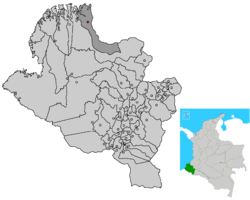 |
| 2005 | February 3 | A bridge was blown up in Putumayo Department Putumayo Department Putumayo is a department of Colombia. It is in the south-west of the country, bordering Ecuador and Peru. Its capital is Mocoa.The word putumayo comes from the Quechua language. The verb putuy means "to spring forth" or "to burst out", and mayo is a variant of mayu, meaning river... , killing eight soldiers and a civilian. |
|
| 2005 | April 6 | An ambush in Arauca Arauca Arauca can refer to the following Colombian locations:*The Arauca Department, in the northeastern part of the country*The city and municipality of Arauca, Arauca, capital of the Arauca Department*The Arauca River, a river shared by Colombia and Venezuela... state, near Venezuela Venezuela Venezuela , officially called the Bolivarian Republic of Venezuela , is a tropical country on the northern coast of South America. It borders Colombia to the west, Guyana to the east, and Brazil to the south... , kills 17 soldiers. |
 |
| 2005 | June 24 | FARC attacks military positions in the location of Puerto Asís Puerto Asís Puerto Asís is a Colombian municipality in the department of the Putumayo. It is located on the west bank of the Putumayo river, downstream from the mouth of the Guamúez River, 75 km by road to the south of Mocoa... in the Putumayo department, killing 25 and wounding 20 in a single operation. |
 |
| 2005 | October 27 | The islands of San Andrés San Andrés (island) San Andrés is a coral island among the Colombian islands in the Caribbean Sea; it is the largest island of the southern group of islands. Together with the nearby island of Providencia and some smaller islands of the southern group of the Colombian archipelago, San Andrés forms the department of... and Providencia Providencia Island Isla de Providencia or Old Providence is a mountainous Caribbean island. Though it is closer to Nicaragua, it is part of the Archipelago of San Andres, Providencia and Santa Catalina, a department of Colombia, lying midway between Costa Rica and Jamaica... are evacuated due to Hurricane Beta (2005) Hurricane Beta (2005) Hurricane Beta was a compact and intense tropical cyclone that impacted areas around the southwestern Caribbean Sea in late October 2005. Beta was the twenty-fourth tropical or subtropical storm, fourteenth hurricane, and seventh and final major hurricane of the record-breaking 2005 Atlantic... . Hours later, a hurricane watch was issued. |
 |
| 2005 | December 27 | FARC launches a massive attack in the remote village of San Marino in the Chocó Department Chocó Department Chocó is a department of Colombia known for its large Afro-Colombian population. It is in the west of the country, and is the only Colombian department to have coastlines on both the Pacific Ocean and the Atlantic Ocean. It also has all of Colombia's border with Panama. Its capital is... , killing at least six police officers along with the temporary abduction of some thirty, before they were released by the guerrillas on December 20 due to military pressure. |
|
| 2005 | December 28 | FARC rebels ambush troops near Vista Hermosa, Meta Vista Hermosa, Meta Vista Hermosa is a town and municipality in the Meta Department, Colombia.... , killing 28. |
 |
| 2006 | May 28 | Álvaro Uribe Álvaro Uribe Alvaro Uribe Vélez was the 58th President of Colombia, from 2002 to 2010. In August 2010 he was appointed Vice-chairman of the UN panel investigating the Gaza flotilla raid.... is re-elected for a second presidential term |
|
| 2006 | July 31 | 16 soldiers die in an ambush in Tibú Tibú Tibú is a Colombian municipality and town located in the department of North Santander.-History:The area of present day Tibú was established as a camp basement by oil companies who first arrived in the area in 1945. On March 8, 1945 the Council of Cúcuta approved the creation of the corregimiento... and a car bomb kills one and injures 22 in Bogotá Bogotá Bogotá, Distrito Capital , from 1991 to 2000 called Santa Fé de Bogotá, is the capital, and largest city, of Colombia. It is also designated by the national constitution as the capital of the department of Cundinamarca, even though the city of Bogotá now comprises an independent Capital district... . Both attacks are blamed on FARC. |
 |
| 2006 | August 4 | A car bomb kills five outside a police station in Cali Calì Calì, also written in English as Cali, is an Italian surname, widespread mainly in the Ionian side of Sicily.For the surname Calì is assumed the origin of the Greek word kalos , or from its Sanskrit root kali, "time."The surname refers to:... . FARC suspected responsible. |
|
| 2006 | October 19 | A car bomb explodes in a military college in northern Bogotá Bogotá Bogotá, Distrito Capital , from 1991 to 2000 called Santa Fé de Bogotá, is the capital, and largest city, of Colombia. It is also designated by the national constitution as the capital of the department of Cundinamarca, even though the city of Bogotá now comprises an independent Capital district... . |
|
| 2006 | November 9 | The Supreme Court ordered the detention of three congressmen implicated in the signature of an illegal agreement with the United Self-Defense Forces of Colombia United Self-Defense Forces of Colombia The United Self-Defense Forces of Colombia was created as an umbrella organization of regional far-right... at Santa Fe de Ralito Santa Fe de Ralito Santa Fe de Ralito is a small ranching outpost in Cordoba, Colombia. It was also the home base for the former leader of the AUC, Salvatore Mancuso, as well as other leaders and 400 of their bodyguards. As part of the late 2004 demobilizations these people were given a temporary 142 square mile ... starting the Colombian parapolitics scandal Colombian parapolitics scandal The Colombian parapolitics scandal or "parapolítica" in Spanish refers to the 2006–present Colombian congressional scandal in which several congressmen and other politicians have been indicted for suspicions of colluding with the United Self-Defense Forces of Colombia , a paramilitary group which... |
 |
| 2006 | December | First Narco submarine Narco submarine A narco-submarine is a type of custom-made ocean-going self-propelled submersible vessel built by drug traffickers to smuggle drugs. They are especially known to be used by Colombian drug cartel members to export cocaine from Colombia to Mexico, which is often then transported overland to the... s of Colombian origin seized by the U.S. Coast Guard, authorities dubbed it Bigfoot Bigfoot Bigfoot, also known as sasquatch, is an ape-like cryptid that purportedly inhabits forests, mainly in the Pacific Northwest region of North America. Bigfoot is usually described as a large, hairy, bipedal humanoid... because they had heard rumors that such things existed, but nobody had actually seen one. |
|
| 2006 | December 10 | Paramilitary Paramilitary A paramilitary is a force whose function and organization are similar to those of a professional military, but which is not considered part of a state's formal armed forces.... leader Salvatore Mancuso Salvatore Mancuso Salvatore Mancuso Gómez, also known as "el Mono Mancuso","Santander Lozada" or "Triple Cero", among other names is a Colombian paramilitary leader, once second in command of the United Self-Defense Forces of Colombia paramilitary group... surrenders to the Colombian authorities |
 |
| 2007 | January 5 | kidnapped politician Fernando Araújo Perdomo Fernando Araújo Perdomo Fernando Araújo Perdomo is a Colombian politician. He was the Minister of Development during the administration of Andrés Pastrana. He resigned from this post after the Chambacú land deal scandal. He was later kidnapped by the FARC-EP guerrillas and held for six years until he eventually escaped... escaped from his captors after a Colombian National Army military operation in the Montes de María Montes de María The Montes de María are a group of mountains of the northern coast of Colombia , which do not belong to the Andes ranges, and the highlands around them. The Montes de María are the last part of the Serranía de San Jerónimo.Montes de María is a zone located in the center of the Colombian... mountains. Araújo spent several days in hiding without food or water until eventually finding help. |
 |
| 2007 | March 1 | Ten injured in a car bomb blast in Neiva, capital of Huila Huila Department Huila is one of the departments of Colombia. It is located in the southwest of the country, and its capital is Neiva.-Geography:The south of the department is located in the Colombian Massif... ; rebel group FARC is believed responsible. The action is suspected to be an assassination attempt on Neiva's mayor. |
|
| 2007 | March 3 | A bomb kills four police officers and one civilian in the city of Neiva, as they attempt to deactivate it | |
| 2007 | March 16 | A bomb kills 16 and injures 16 in Buenaventura Buenaventura -Myths and legends:*Buenaventura River , a legendary but non-existent river that was once believed to run from the Rocky Mountains to the Pacific Ocean in what is now the western United States-People:... . Authorities blame FARC. |
|
| 2007 | April 7 | The first Colombian satellite Satellite In the context of spaceflight, a satellite is an object which has been placed into orbit by human endeavour. Such objects are sometimes called artificial satellites to distinguish them from natural satellites such as the Moon.... , Libertad I is launched in orbit from Baikonur cosmodrome Baikonur Cosmodrome The Baikonur Cosmodrome , also called Tyuratam, is the world's first and largest operational space launch facility. It is located in the desert steppe of Kazakhstan, about east of the Aral Sea, north of the Syr Darya river, near Tyuratam railway station, at 90 meters above sea level... |
 |
| 2007 | April 28 | Kidnapped police officer Jhon Frank Pinchao Jhon Frank Pinchao Jhon Frank Pinchao Blanco is a Colombian policeman with the rank of sub-intendant who was kidnapped by the Revolutionary Armed Forces of Colombia guerrilla group after Farc's attack on the town of Mitú, Vaupés Department on November 1, 1998... escapes from the FARC guerrilla spending near a month lost in the jungle |
|
| 2007 | May | Virginia Vallejo Virginia Vallejo Virginia Vallejo-Garcia is a Colombian writer, journalist, columnist, media personality, television anchorwoman, and socialite born on August 26th 1949 in Cartago, Valle del Cauca, who lost her career in television after her five-year romantic relationship with Pablo Escobar , head of the Medellín... , media personality and former lover of Pablo Escobar Pablo Escobar Pablo Emilio Escobar Gaviria was a Colombian drug lord. He was an elusive cocaine trafficker and rich and successful criminal. He owned numerous luxury residences, automobiles, and even airplanes... , published her memoir Amando a Pablo, odiando a Escobar (Loving Pablo, Hating Escobar), where she accused several Colombian presidents of involvement with drug traffickers |
 |
| 2007 | June 28 | Murder of the politicians kidnapped in the Valle del Cauca Deputies hostage crisis Valle del Cauca Deputies hostage crisis The Valle del Cauca Deputies hostage crisis refers to the kidnapping of 12 Deputies of the Valle del Cauca Department, Colombia, on April 12, 2002 by members of the Revolutionary Armed Forces of Colombia to pressure a prisoner exhange between them and the government and to negotiate the... causes national outrage |
|
| 2007 | September 7 | Colombian coffee Colombian coffee Colombian Coffee is a protected designation of origin granted by the European Union that applies to the coffee produced in Colombia. The Colombian coffee has been recognized worldwide as having high quality and distinctive taste... achieves Protected designation of origin Protected designation of origin Protected Geographical Status is a legal framework defined in European Union law to protect the names of regional foods. Protected Designation of Origin , Protected Geographical Indication and Traditional Speciality Guaranteed are distinct regimes of geographical indications within the framework... status granted by the European Union European Union The European Union is an economic and political union of 27 independent member states which are located primarily in Europe. The EU traces its origins from the European Coal and Steel Community and the European Economic Community , formed by six countries in 1958... |
 |
| 2007 | December 13 | International Court of Justice International Court of Justice The International Court of Justice is the primary judicial organ of the United Nations. It is based in the Peace Palace in The Hague, Netherlands... of The Hague The Hague The Hague is the capital city of the province of South Holland in the Netherlands. With a population of 500,000 inhabitants , it is the third largest city of the Netherlands, after Amsterdam and Rotterdam... concluded the long-time dispute with the Republic of Nicaragua over the San Andrés y Providencia Islands in favor of Colombian sovereignty over the San Andres Archipelago, ratifying the Esguerra-Bárcenas treaty. signed between 1928 and 1930 |
 |
| 2008 | January 10 | Former vice presidential candidate Clara Rojas Clara Rojas Clara Leticia Rojas González is a Colombian tax lawyer, university lecturer, and campaign manager for former senator and presidential candidate Ingrid Betancourt. She was kidnapped along with Betancourt by the FARC guerrilla group near San Vicente del Caguán on February 23, 2002, while Betancourt... and former congresswoman Consuelo González are freed after nearly six years in captivity |
 |
| 2008 | March 1 | The Colombian military attacks a FARC camp inside Ecuador Ecuador Ecuador , officially the Republic of Ecuador is a representative democratic republic in South America, bordered by Colombia on the north, Peru on the east and south, and by the Pacific Ocean to the west. It is one of only two countries in South America, along with Chile, that do not have a border... 's territory. Several guerrilla casualties including guerrilla leader Raul Reyes Raúl Reyes Luis Edgar Devia Silva , better known by his nom de guerre Raúl Reyes, was a Secretariat member, spokesperson, and advisor to the Southern Bloc of the Revolutionary Armed Forces of Colombia-EP... strarting the 2008 Andean diplomatic crisis 2008 Andean diplomatic crisis The 2008 Andean diplomatic crisis was a diplomatic stand-off between the South American countries of Ecuador, Colombia and Venezuela. It began with an incursion into Ecuadorian territory across the Putumayo River by the Colombian military on March 1, 2008, leading to the deaths of over twenty... |
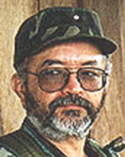 |
| 2008 | March 3 | Iván Ríos Iván Ríos José Juvenal Velandia, aka Iván Ríos, aka Manuel Jesús Muñoz Ortiz, , born in San Francisco, Putumayo, Colombia, was the Head of the Central Bloc of the Revolutionary Armed Forces of Colombia and the youngest member of this guerrilla's Central High Command.-Death:Ríos was killed by his security... , a member of the FARC Central High Command was killed by his security chief "Rojas". |
 |
| 2008 | March 26 | Guerrilla commander Manuel Marulanda Vélez dies | 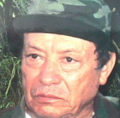 |
| 2008 | May 18 | Guerrilla leader Elda Neyis Mosquera Elda Neyis Mosquera Elda Neyis Mosquera García is the former commander of the 47th Front of FARC-EP, a communist rebel group in Colombia. She surrendered to the Colombian Military on May 18, 2008... alias "Karina" surrenders herself to the military forces |
|
| 2008 | July 2 | Under a Colombian military operation called Operation Jaque Operation Jaque Operation Jaque was a Colombian military operation that resulted in the freedom of 15 hostages, including former Colombian presidential candidate Íngrid Betancourt. The hostages had been held by the Revolutionary Armed Forces of Colombia . The operation took place on July 2, 2008, along the... , the FARC was tricked by the Colombian Government into releasing 15 hostages to Colombian Intelligence agents, including Ingrid Betancourt Íngrid Betancourt Ingrid Betancourt Pulecio is a Colombian politician, former senator and anti-corruption activist.Betancourt was kidnapped by the Revolutionary Armed Forces of Colombia on 23 February 2002 and was rescued by Colombian security forces six and a half years later on 2 July 2008... , U.S military contractors, and Colombian soldiers and police officers |
 |
| 2008 | August 15 | Ituango Ituango Ituango is a town and municipality in the Colombian department of Antioquia. Part of the subregion of Northern Antioquia.... , Antioquia. Seven people were killed and more than 50 wounded when a bomb detonated in a small town |
 |
| 2008 | August 21 | Colombia has chosen the European DVB-T DVB-T DVB-T is an abbreviation for Digital Video Broadcasting — Terrestrial; it is the DVB European-based consortium standard for the broadcast transmission of digital terrestrial television that was first published in 1997 and first broadcast in the UK in 1998... standard for Digital terrestrial television Digital terrestrial television Digital terrestrial television is the technological evolution of broadcast television and advance from analog television, which broadcasts land-based signals... |
|
| 2008 | October 30 | Denounces about Colombian army Colombian Army The National Army of Colombia is the land military force of the government of Colombia and the largest service of the Colombian Armed Forces... soldiers involved with criminal bands with the purpose of lure unsuspecting unemployed or homeless people into isolated areas where they were murdered and the scenes were staged as combats against guerrilla as means of enhance their achievements and get Performance-related pay Performance-related pay Performance-related pay is money paid to someone relating to how well one works. Car salesmen, production line workers, for example, may be paid in this way, or through commission.... ments, were investigated. The events, known as the false positive scandal drove to the destitution of forty officers and the resign of Commander-in-chief Commander-in-Chief A commander-in-chief is the commander of a nation's military forces or significant element of those forces. In the latter case, the force element may be defined as those forces within a particular region or those forces which are associated by function. As a practical term it refers to the military... , general Mario Montoya Mario Montoya Uribe Mario Montoya Uribe was a Colombian military General and Commander of the Colombian National Army until his resignation on November 4, 2008 following a scandal involving the deaths of 11 civilians at the hands of the military. Montoya holds a graduate title in Top management from the Los Andes... . |
|
| 2008 | November 12 | Riots broke out in the municipalities of Pasto Pasto Pasto, officially San Juan de Pasto, is the capital of the department of Nariño, located in southwest Colombia. The city is located in the "Atriz Valley", on the Andes cordillera, at the foot of the Galeras volcano, at an altitude of 8,290 feet above sea level... , Tumaco Tumaco Tumaco is a port city and municipality in the Nariño Department, Colombia, by the Pacific Ocean. It is located on the southwestern of Colombia, near to border with Ecuador, and enjoys of hot tropical climate... , Popayán Popayán Popayán is the capital of the Colombian department of Cauca. It is located in southwestern Colombia between Colombia's Western Mountain Range and Central Mountain Range... and later spread all over the country after the collapse of several pyramid scheme Pyramid scheme A pyramid scheme is a non-sustainable business model that involves promising participants payment or services, primarily for enrolling other people into the scheme, rather than supplying any real investment or sale of products or services to the public... s. Thousands of victims had invested their money in pyramids that promised them extraordinary interest rates. The lack of regulation laws allowed those pyramids to grow excessively during several years. Finally, after the riots the Colombian government was forced to declare the country in economical emergency in order to seize and stop those schemes. Several of the pyramid's managers were arrested and are being prosecuted for the crime of "illegal massive money reception". |
|
| 2008 | November 22 | Colombia and Canada signed a new $ Canadian dollar The Canadian dollar is the currency of Canada. As of 2007, the Canadian dollar is the 7th most traded currency in the world. It is abbreviated with the dollar sign $, or C$ to distinguish it from other dollar-denominated currencies... 1.14 billion dollar bilateral Bilateral trade Bilateral trade or clearing trade is trade exclusively between two states, particularly, barter trade based on bilateral deals between governments, and without using hard currency for payment... trade agreement (the Canada-Colombia Free Trade Agreement Canada-Colombia relations Canada-Colombia relations are foreign relations between Canada and Colombia. Full direct diplomatic relations were established in 1953, with the exchange of the first ambassadors. Canada has an embassy in Bogotá. Colombia has an embassy in Ottawa and 2 Consulates-General... ) at the Asia-Pacific Economic Cooperation Asia-Pacific Economic Cooperation Asia-Pacific Economic Cooperation is a forum for 21 Pacific Rim countries that seeks to promote free trade and economic cooperation throughout the Asia-Pacific region... meeting. |
 |
| 2009 | January 8 | Colombian drug lord and head of the Caqueta Caquetá Caquetá may refer to:* Caquetá River, a river in Colombia* Caquetá Territory, a former territory of Colombia* Caquetá Department, a department of Colombia... cartel Leonidas Vargas Leonidas Vargas Leonidas Vargas , also known as "El Viejo" and "The King of Caqueta", was a Colombian drug lord who headed a multi-million dollar cocaine empire associated with the Medellín Cartel and the Revolutionary Armed Forces of Colombia... is murdered inside a hospital. his brother(Héctor Fabio Vargas) and his girlfriend (Colombian actress Liliana Andrea Lozano Liliana Lozano Liliana Andrea Lozano was a Colombian actress and beauty queen, and was the girlfriend of drug lord Leonidas Vargas. Lozano won a national beauty contest at the Carnival in Colombia in 1995. She started her television career as a game show presenter, and eventually acted on such shows as Pasión de... ) were tortured and murdered in Pradera Pradera Pradera is a town and municipality located in the Department of Valle del Cauca, Colombia.The FARC requested this municipality together with Florida, Valle del Cauca as free areas for them to operate in order to start the negotiation to exchange 44 hostages they had, at the time of their request,... , Colombia. |
|
| 2009 | January 8 | Recognition of same-sex unions in Colombia Recognition of same-sex unions in Colombia Colombia has no laws providing for same-sex marriage. However, as a result of Constitutional Court ruling on 29 January 2009, same-sex couples can be recognised as de facto unions , which were previously available only to heterosexual couples and which provide all of the rights of marriage... is achieved by rule of the Constitutional Court |
|
| 2009 | January 11 | Reports of mass murders of Awá (kwaiker) Awá (kwaiker) The Awá are an ancient indigenous people that inhabit the regions of northern Ecuador and southern Colombia . Their entire population is around 32,555 members. They speak a language called Awapit.-Reserve:The Awa Reserve was established in northwestern Ecuador in 1987... indigenous people by FARC guerrilla |
|
| 2009 | February | Colombia has extended its existing tobacco control regulations by a smoking ban Smoking ban Smoking bans are public policies, including criminal laws and occupational safety and health regulations, which prohibit tobacco smoking in workplaces and/or other public spaces... requiring all indoor work places and public places be immediately smoke-free;prohibiting tobacco advertising, promotions and sponsorship |
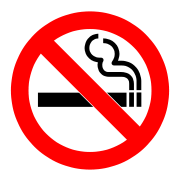 |
| 2009 | February | the fossil Fossil Fossils are the preserved remains or traces of animals , plants, and other organisms from the remote past... s of 28 individual Titanoboa cerrejonensis, the largest snake ever discovered, were announced to have been found in the coal mines Coal mining The goal of coal mining is to obtain coal from the ground. Coal is valued for its energy content, and since the 1880s has been widely used to generate electricity. Steel and cement industries use coal as a fuel for extraction of iron from iron ore and for cement production. In the United States,... of Cerrejón Cerrejón Cerrejón is a coal mine located in the Guajira department in the north of Colombia. It is the largest mining operation in Colombia and among the largest open-pit coal mines in the world. The legal entity managing the Cerrejón operation is known as Carbones del Cerrejón Ltd... in La Guajira Department of La Guajira La Guajira is a department of Colombia. It occupies most of its namesake peninsula, the Guajira Peninsula in the northeast region of the country, facing the Caribbean Sea and Venezuela in the northern most part of South America... , Colombia. |
 |
| 2009 | March | The Alvarez case Alvarez case The Alvarez incest case was uncovered late March 2009 when 59-year old Arcedio Alvarez was arrested in Mariquita, Colombia, accused of imprisoning and sexually abusing his daughter Alba Nidia Alvarez over a period of 25 years, beginning when she was 9 years old. The daughter also gave birth to 11... was uncovered when 59-year old Arcedio Alvarez was arrested in Mariquita, Colombia, accused of sexually abusing his now 30-year old daughter Alba Nidia Alvarez since the age of 9. The daughter also gave birth to 11 children, three of whom died. |
|
| 2009 | March | the Colombian government enacted a mandate to introduce E85 flexible-fuel vehicle Flexible-fuel vehicle A flexible-fuel vehicle or dual-fuel vehicle is an alternative fuel vehicle with an internal combustion engine designed to run on more than one fuel, usually gasoline blended with either ethanol or methanol fuel, and both fuels are stored in the same common tank... s |
|
| 2009 | March 15 | Luis Carlos Sarmiento Angulo gets ranked in the Forbes Forbes Forbes is an American publishing and media company. Its flagship publication, the Forbes magazine, is published biweekly. Its primary competitors in the national business magazine category are Fortune, which is also published biweekly, and Business Week... list of world billionaires. |
|
| 2009 | April | The Colombian armed forces launched Strategic Leap, an offensive in borders areas where the FARC's forces has still a strong military presence, especially in Arauca Arauca Arauca can refer to the following Colombian locations:*The Arauca Department, in the northeastern part of the country*The city and municipality of Arauca, Arauca, capital of the Arauca Department*The Arauca River, a river shared by Colombia and Venezuela... , near the Venezuelan border. |
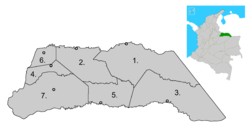 |
| 2009 | April | Colombian drug lord Daniel Rendón Herrera Daniel Rendon Herrera Daniel Rendón Herrera is a Colombian drug lord. He was captured on April 15, 2009 while hiding in a jungle.- References :... alias Don "Mario" is captured while hiding in a jungle. |
|
| 2009 | May 13 | Vallenato Vallenato Vallenato, along with cumbia, is currently a popular folk music of Colombia. It primarily comes from the Colombia's Caribbean region. Vallenato literally means "born in the valley". The valley influencing this name is located between the Sierra Nevada de Santa Marta and the Serranía de Perijá in... composer and troubadour Troubadour A troubadour was a composer and performer of Old Occitan lyric poetry during the High Middle Ages . Since the word "troubadour" is etymologically masculine, a female troubadour is usually called a trobairitz.... Rafael Escalona Rafael Escalona Rafael Calixto Escalona Martinez was a Colombian composer and troubadour. He was known for being one of the most prominent vallenato music composers and troubadours of the genre and for being the co-founder of the Vallenato Legend Festival, along with Consuelo Araújo and Alfonso López Michelsen.He... dies due to heart failure. |
 |
| 2009 | May 14 | During his visit in Colombia, the Czech Republic Czech Republic The Czech Republic is a landlocked country in Central Europe. The country is bordered by Poland to the northeast, Slovakia to the east, Austria to the south, and Germany to the west and northwest.... Prime Minister Mirek Topolánek Mirek Topolánek Mirek Topolánek is a former prime minister of the Czech Republic and former President of the European Council. A member of the Civic Democratic Party, he was chairman of the center-right party between November 2002 and March 2010, succeeding Václav Klaus, who was elected President in 2003.On 24... negotiated a possible sale of the combat aircrafts Aero L-159 Alca Aero L-159 Alca |-See also:-References:* Jackson, Paul. Jane's All The World's Aircraft 2003–2004. Coulsdon, UK:Jane's Information Group, 2003. ISBN 0-7106-2537-5.-External links:* * * * *... with Colombian President Álvaro Uribe Álvaro Uribe Alvaro Uribe Vélez was the 58th President of Colombia, from 2002 to 2010. In August 2010 he was appointed Vice-chairman of the UN panel investigating the Gaza flotilla raid.... . |
 |
| 2009 | June | Clara Guerrero Clara Guerrero Clara Juliana Guerrero Londoño is a Colombian bowler. She has won Colombian championships and multiple international championships in various competition categories... wins Women's World Championship World Ranking Masters World Ranking Masters The World Ranking Masters is Ten-pin bowling's international ranking system, as with professional Tennis. It is governed by the World Tenpin Bowling Association .... |
|
| 2009 | July | The Colombian government claimed that AT4 AT4 The AT4 is an 84-mm unguided, portable, single-shot recoilless smoothbore weapon built in Sweden by Saab Bofors Dynamics... anti-tank rockets manufactured by Saab Bofors Dynamics Saab Bofors Dynamics Saab Bofors Dynamics, located in Karlskoga and Linköping, Sweden, is a subsidiary of Saab AB that specializes in military materiel such as missile systems and anti-tank systems.... of Sweden, which were later purchased by Venezuela were being used by the FARC. In response, President Chavez ordered most staff members of the embassy in Colombia to return to Venezuela, including the ambassador. Only the "lowest functionaries" were left to staff the embassy. |
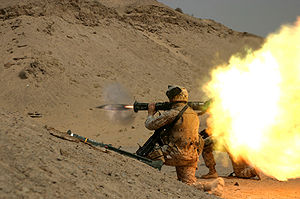 |
| 2009 | July 18 | Ricardo Londoño Ricardo Londoño Ricardo Londoño-Bridge was a racing driver from Colombia. He had an unremarkable international career apart from his one attempt at Formula One in the 1981 Brazilian Grand Prix with Ensign.... , Colombia's first Formula One Formula One Formula One, also known as Formula 1 or F1 and referred to officially as the FIA Formula One World Championship, is the highest class of single seater auto racing sanctioned by the Fédération Internationale de l'Automobile . The "formula" designation in the name refers to a set of rules with which... driver is murdered in the north Colombian Córdoba Department Córdoba Department Córdoba is a Department of the Republic of Colombia located to the north of this country in the Colombian Caribbean Region. Córdoba faces to the north with the Caribbean sea, to the northeast with the Sucre Department, east with the Bolívar Department and south with the Antioquia Department... . |
|
| 2009 | August 8 | Cuban artist Tania Bruguera Tania Bruguera Tania Bruguera is a Cuban installation and performance artist, trained at the Instituto Superior de Arte in Havana and at the School of the Art Institute of Chicago. Bruguera's work pivots around issues of power and control.... sets a controversial performance Performance A performance, in performing arts, generally comprises an event in which a performer or group of performers behave in a particular way for another group of people, the audience. Choral music and ballet are examples. Usually the performers participate in rehearsals beforehand. Afterwards audience... in the National University of Colombia National University of Colombia The Universidad Nacional de Colombia , also called UNAL or just UN, is a public, national, coeducational, research university, located primarily in Bogotá, Medellín, Manizales and Palmira, Colombia... (Bogotá branch), included consumption of cocaine provided by the artist to the attendants. |
|
| 2009 | August 30 | President Álvaro Uribe Álvaro Uribe Alvaro Uribe Vélez was the 58th President of Colombia, from 2002 to 2010. In August 2010 he was appointed Vice-chairman of the UN panel investigating the Gaza flotilla raid.... had contracted the AH1N1 flu virus, becoming the second head of state Head of State A head of state is the individual that serves as the chief public representative of a monarchy, republic, federation, commonwealth or other kind of state. His or her role generally includes legitimizing the state and exercising the political powers, functions, and duties granted to the head of... to do so (the first being Óscar Arias Óscar Arias Óscar Arias Sánchez is a Costa Rican politician who was President of Costa Rica from 2006 to 2010. He previously served as President from 1986 to 1990 and received the Nobel Peace Prize in 1987 for his efforts to end civil wars then raging in several other Central American countries.He is also a... ). |
|
| 2009 | September 11 | A group of eradicators of Coca crops Coca production in Colombia Like Bolivia and Peru, Colombia is a major cultivator of coca. Between 1993 and 1999 Colombia became the main producer of coca in the world along with cocaine. Total land area devoted to coca production increased 60 percent from 1983 to 1986, reaching 25,000 hectares... near the village of La Gabarra, Municipality of Tibú Tibú Tibú is a Colombian municipality and town located in the department of North Santander.-History:The area of present day Tibú was established as a camp basement by oil companies who first arrived in the area in 1945. On March 8, 1945 the Council of Cúcuta approved the creation of the corregimiento... , Norte de Santander is attacked by guerrilla forces with a donkey with bombs attached to it. 2 people deceased |
 |
Further reading
- Calderón Schrader, Camilo; Gil, Antonio; Torras, Daniel (2001), Enciclopedia de Colombia (4 volúmenes). Barcelona: céano Grupo Editorial, 2001. ISBN 978-84-494-1947-8 (Obra completa)

